
* A Distributed Proofreaders Canada eBook *
This ebook is made available at no cost and with very few restrictions. These restrictions apply only if (1) you make a change in the ebook (other than alteration for different display devices), or (2) you are making commercial use of the ebook. If either of these conditions applies, please contact a FP administrator before proceeding.
This work is in the Canadian public domain, but may be under copyright in some countries. If you live outside Canada, check your country's copyright laws. IF THE BOOK IS UNDER COPYRIGHT IN YOUR COUNTRY, DO NOT DOWNLOAD OR REDISTRIBUTE THIS FILE.
Title: The 48th Highlanders of Toronto
Date of first publication: 1900
Author: Alexander Fraser (1860-1936)
Date first posted: Feb. 27, 2017
Date last updated: Feb. 27, 2017
Faded Page eBook #20170230
This ebook was produced by: Barbara Watson, David T. Jones, Alex White & the online Distributed Proofreaders Canada team at http://www.pgdpcanada.net

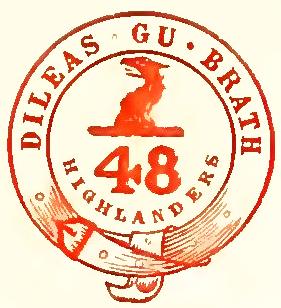
With the compliments of the season
and best wishes for the new year
from lieut. colonel macdonald and
officers of the 48th highlanders.
Headquarters,
Toronto, 1st Jany, 1901.
THE 48th HIGHLANDERS,
OF TORONTO.
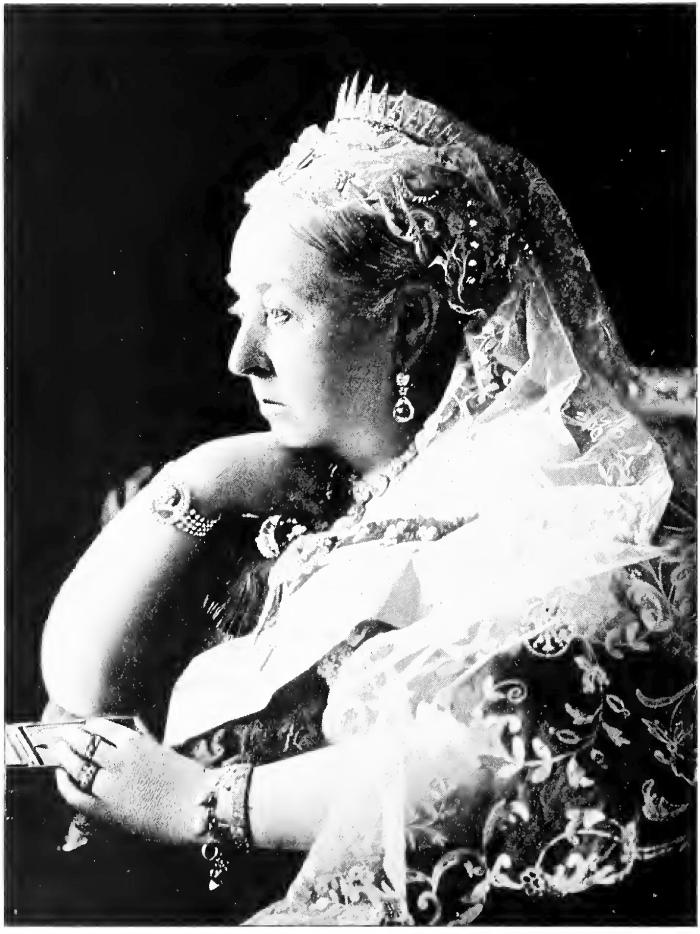
HER MAJESTY QUEEN VICTORIA.
THE
48th Highlanders
OF TORONTO.
CANADIAN MILITIA.
THE ORIGIN AND HISTORY OF THIS REGIMENT,
AND A SHORT ACCOUNT OF THE
HIGHLAND REGIMENTS
FROM TIME TO TIME
STATIONED IN CANADA.
BY
ALEXANDER FRASER, M.A.,
SECRETARY TO THE CITIZENS’ COMMITTEE WHICH RAISED THE REGIMENT.
E. L. RUDDY,
TORONTO.
1900.
Entered according to Act of the Parliament of Canada in the year 1900
at the Department of Agriculture, by E. L. Ruddy.
Printed by R. G. McLean, Toronto.
With Ink manufactured by Canada Printing Ink Co., Toronto.
On Coated Paper made by Ritchie & Ramsay, Toronto.
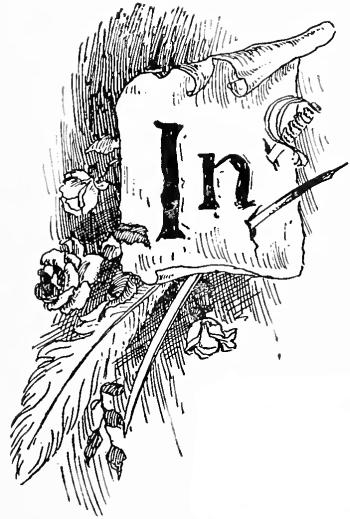
writing the history of a regiment formed not more than nine years ago, the advantage lies in the abundance of the material at hand. Brief the period may be, and uneventful the record, but the whole story is still fresh in the memory, and no fact of interest or importance need be overlooked. On the other hand, it is a matter of constant regret with respect to some of the old regiments—particularly some of the old Highland regiments—that so little is definitely known of the details of their organization, and much would be given if the neglect of the time long ago could be repaired. In entering upon the last year of its first decade as a military organization the time seems opportune to place on permanent record in a worthy and befitting form the interesting story of the origin and growth of a regiment occupying so conspicuous a place in the Active Militia of Canada as does the 48th Highlanders of Toronto.
Though one of the latest battalions added to the Canadian Militia, it is one of the most distinguished, efficient and popular of them all. Wearing the Highland uniform, and headed by a band of pipers, it is a gallant corps, of which members of all nationalities, but especially those of Scottish connection, are justly proud. It has attracted to its ranks an excellent body of men, who have at all times taken a pride in maintaining the honour of the regiment worthily, and a morale of the very highest character. This was to have been expected from the history of Highland regiments in the past, when, under all circumstances, duty and discipline have ever been the watchword and motto of the Highland soldier, and the gallant 48th has shown itself to be mindful of the glorious traditions of its predecessors.
While this work is essentially a history of the 48th Highlanders, it is but natural to suppose that the idea such a corps represents is wider and touches interests beyond the regiment itself which are dear to the Scotchman the world over, and are appreciated wherever the true military spirit exists. The martial ardour of the Gael, his aptitude for soldiering, and his services in the field have been the subject of fitting, though necessarily brief, reference in these pages. The association of Highland regiments of the regular army with Canada has been also briefly noticed, and an unbroken connection from Quebec to the present day traced between the Highland soldier and the Dominion.
The official documents from which the information was drawn were placed in the hands of Mr. Alexander Fraser, the well-known journalist and Scottish author, who was Secretary of the Citizens’ Committee which carried the movement for the establishment of the 48th Highlanders to a successful issue. He is thoroughly conversant with all the details of the formation of the regiment from the inception of the movement, and with the record of the corps up to the present. He received all necessary assistance from the officers of the regiment, so that this work may be taken as accurate and complete.
The Publisher.
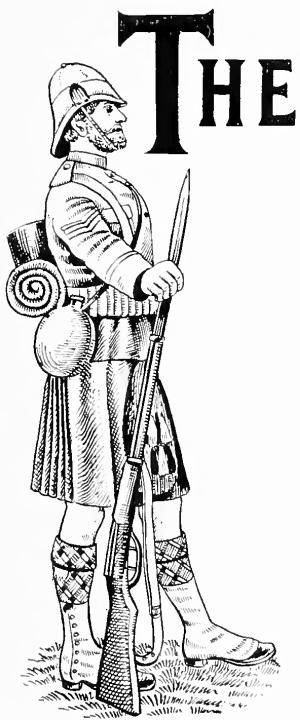
greatest misfortune that can happen to any people is to have no noble deeds and no heroic personalities to look back to; for as a wise present is the seed of a fruitful future, so a great past is the seed of a hopeful present.” So wrote Professor Blackie, having in mind the courage and the martial fervour of the Scottish people. From the dim beginning of history the Celt reveals himself as a mighty man of war. Heroes lead him in the fight, and bards celebrate his victories in song, accompanied by the stringed harp and the tuneful lyre. In Europe he faced the Roman legions, and when the long galleys lay-to off Dover, the chalk-white cliffs were crowned by a resisting and resolute people in which the Celtic blood still predominated. Generations passed after Cæsar, and the eagles waved triumphantly over the rich southern plains, but the northern fastnesses were held against the Roman arms by the prowess of the Gael, to whose martial genius is due the fact that “Caledonia, stern and wild” has never yielded to the invader’s power, nor to this day has been conquered. Very early in the annals of Rome, a victory by the Celtic leader, Brennus, over the Romans is recorded. From classic story we also learn of a Roman defeat at Allia, B.C. 391, by the Celts of Gaul. From these early days until the present the Gael has shown a natural aptitude for war, and in modern times it is needless to say no braver soldiers face the field than the kilted lads who dare a Dargai, an Atbara or a Modder River. It was the same spirit that made a Bannockburn possible, which stirred the Border Clans in their forays, and the Hebridean oarsmen in their birlinn raids—“dhain deoin co theireadhe”—that responded to the call to arms when the British Government was controlled by the wise policy of the elder Pitt, whose words in reference the Highland regiments are worth remembering. It was after Culloden. Britain was deeply involved in war, and a scheme to embody the Highlanders in regular corps, suggested first by the sagacious and statesmanly Duncan Forbes to Walpole, was taken up by Pitt. Speaking of the experiment, Pitt said: “I sought for merit wherever it could be found. It is my boast that I was the first minister who looked for it, and found it, in the mountains of the North. I called it forth, and drew into your service a hardy and intrepid race of men; men who, when left by your jealousy, became a prey to the artifices of your enemies, and had gone nigh to have overturned the state in the war before last. These men, in the last war, were brought to combat on your side, they served with fidelity, as they fought with valour, and conquered for you in every quarter of the world.”
The history of the Scottish Highlanders during the last 150 years proves that national sentiment is of inestimable value in military enterprise. From the time when the Black Watch and other Highland regiments became a part of the British Army the importance of well-managed and easily controlled individuality, as against a blind uniformity, has been gradually recognized, and practical conviction has been followed by beneficial results. To-day national sentiment is accordingly encouraged. Scottish, Irish and English corps vie with each other in their zeal to uphold the prestige of their country on the field of battle. This quality is forcibly stated by General David Stewart in his rare book, in which he thus describes the difference between the soldiers of three great countries:
“The German soldier considers himself as a part of the military machine and duty marked out in the orders of the day. He moves onward to his destination with a well-trained pace, and with as phlegmatic indifference to the result as a labourer who works for his daily hire. The courage of the French soldier is supported in the hour of trial by his high notions of the point of honour, but this display of spirit is not always steady; neither French nor German is confident in himself, if an enemy gain his flank or rear. A Highland soldier faces his enemy, whether in front, rear or flank, and if he has confidence in his commander, it may be predicted with certainty that he will be victorious or die on the ground which he maintains.”
Why? General Stewart’s answer is:
“He goes into the field resolved not to disgrace his name.”
The greatest British generals are among those who acknowledge the military value of a sentiment that inspires such determination and gives an impetus to native valour.
A monopoly of this quality is not, of course, claimed for Highland soldiers, but the Highland regiments, without exception, have shown themselves to possess this high character in a marked degree; and it is all-important that the reason why should not be forgotten. The inborn military ardour of the Scottish Highlander is kept alive by cherishing his racial characteristics. First and foremost is the native love for his country. No people is more rooted in the soil than the Celt. With all his love for pioneering, for leading the way to new countries and settling down in them as his permanent home, it is nevertheless true of no one more than it is of the Celt that he dearly loves the glen or mountain side where first he saw the light. For his country’s sake he will willingly die. Then, there is the deep-seated love for clan and kinsmen, and the sacred regard for the family ties. It is difficult for a stranger to appreciate this phase of the Highlander’s character; it is the key to much of his life, which, without it, cannot be understood. Love for the traditions of the fathers, jealousy of their good name, pride in their historical achievements, and a desire to emulate them, all combine to give force to his native courage and to give him an exalted impression of his duty. As to the ancient Roman, so to him also the creed can be applied which these lines contain:
“And how can a man die better
Than facing fearful odds.
For the ashes of his fathers
And the temples of his gods.
“And for the tender mother
Who dandled him to rest.
And for the wife who nurses
His baby at her breast.”
The natural aptitude which the Highlander has for war is also stimulated by the regimental accompaniments of music and dress. The martial music of the bagpipes has stirred the Highland soldier’s blood in many a hard-fought battle, and its influence has been so great that no Highland regiment would claim to be complete without its band of pipers. The Highland uniform is not only attractive in itself, it has the merit of being a rational as well as a national costume. It permits ease of movement and conduces to superior health. Highland soldiers love it as the costume of their country from the olden time, and its use is a constant monitor to wear it worthily. The “garb of old Gaul and the fire of old Rome” have been coupled together not without good cause, but that need not be entered upon here. While the “bonnet, kilt and feather,” and the bagpipes remain there will be no lack of Scotsmen to maintain the strength of the Highland regiments.
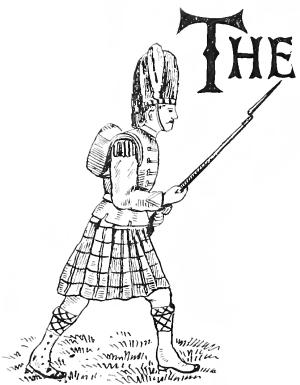
first of the old Highland regular regiments to have been established was the “Black Watch”—the famous Forty-Second—regimented from six companies of military police, which were formed in 1729, to keep the peace in the disturbed portions of the Scottish Highlands. It is interesting at this lapse of time to note that about one hundred and seventy years ago the duties of this military police were the enforcement of the Disarming Act, the overawing of the disaffected, the prevention of convocations of the people, and “to check plunder and reprisals of cattle between rival clans, and more particularly the depredations committed on those of their more peaceable neighbours of the plains.” These and four additional companies were formed into a regiment of the line in 1739, and the first muster took place in 1740. With the formation of the “Black Watch” into a regular regiment came the introduction of the Highland uniform into the British Army. The Highland uniform is a modification of the national costume of Scotland, suited to the arms and accoutrements of the soldier.
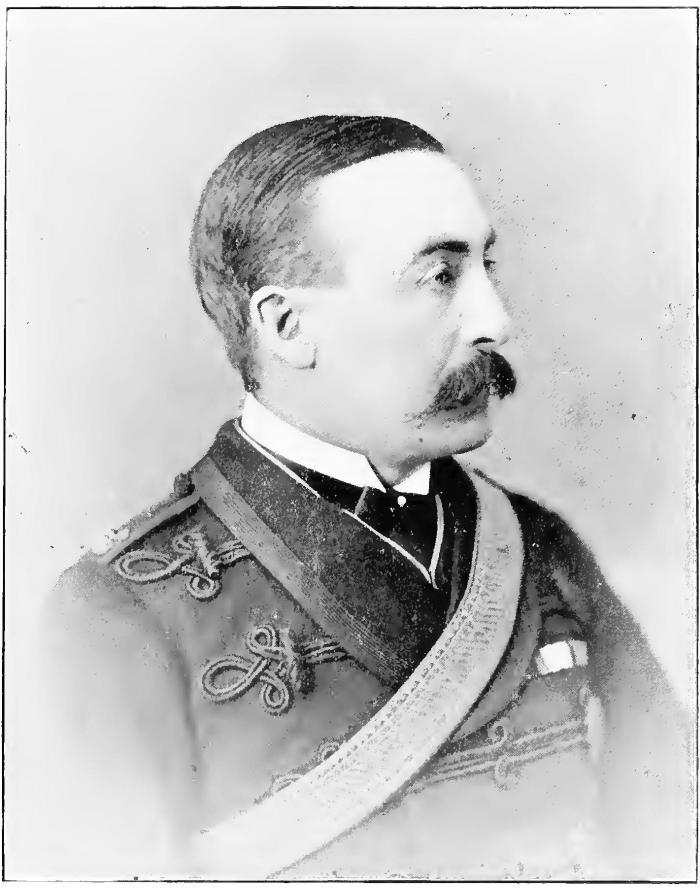
His Excellency The Governor-General of Canada. The Earl of Minto, D.C., K.C.M.G.
A description of that worn at first by the “Black Watch” cannot fail to be of interest to the Highland soldier of to-day. The uniform was a scarlet jacket and waistcoat, with buff facings and white lace, tartan plaid of twelve yards plaited round the middle of the body, the upper part being fixed on the left shoulder ready to be thrown loose and wrapped over both shoulders and firelock in rainy weather. At night the plaid served the purpose of a blanket. These were called belted plaids, from being kept tight on the body by a belt, and were worn on guards, reviews, and on all occasions when the men were in full dress. On this belt hung the pistols and dirk when worn. In the barracks, and when not on duty, the little kilt or philabeg was worn. A blue bonnet, with border of white, red and green, arranged in small squares to resemble the fess chequey in the arms of the different branches of the Stewart family, and a tuft of feathers, or sometimes a small black bearskin. Tartan hose with buckled shoes were worn, and sporrans of badger skins. The arms were a musket, a bayonet, and a large basket-hilted broadsword. Such of the men as chose to supply themselves with pistols and dirks were allowed to carry them, and some had targets. The sword belt was of black leather, and the cartouch-box was carried in front, supported by a narrow belt round the middle. The officers’ dress-coats were slightly embroidered with gold; the sergeants’ jackets were trimmed with silver lace, which they provided for themselves.
In the spring of 1756 the 42nd (Black Watch) Highland Regiment, under Lieutenant-Colonel Francis Grant, embarked from Ireland for New York, to take part in the struggle for supremacy in North America, between France and Great Britain. Col. Francis Grant was a son of the Laird of Grant, and had joined the Forty-Second as a lieutenant in 1739, on the formation of the regiment. He was so popular with the men of the 42nd, that when a vacancy occurred in that regiment, on the promotion of Lieut.-Col. John Campbell, who afterwards became the celebrated Duke of Argyle, to the command of another regiment, they raised money to purchase for Major Grant the vacant colonelcy. He was, however, promoted without purchase and commanded the regiment in America until 1762, when he was transferred to the command of the 90th Irish Light Infantry. He subsequently rose to the rank of Lieutenant-General.
The 42nd formed part of Major-General Abercromby’s division which reached Halifax in the summer of 1757 in the first expedition for Louisbourg, which was abandoned in consequence of the strength of the French force there. In the year following they made the memorable charge at Ticonderoga, described by an officer of the 55th thus:—“With a mixture of esteem, grief and envy, I consider the great loss and immortal glory acquired by the Scots Highlanders in the late bloody affair. Impatient for orders, they rushed forward to the entrenchments, which many of them actually mounted. They appeared as lions breaking from their chains. Their intrepidity was rather animated than damped by seeing their comrades fall on every side. . . . By their assistance we expect soon to give a good account of the enemy and ourselves.” It was in this action that Major Duncan Campbell, of Inverawe, fell, whose premonition of death has formed the subject of eerie legend for the prose of Sir Thomas Dick Lauder, Bart., and the poetry of Robert Louis Stevenson. The regiment, 1,300 strong, lost in that engagement, 8 officers, 9 sergeants, and 297 men, killed; 17 officers, 10 sergeants, and 306 men wounded. The King conferred the honour of “Royal” on the regiment at this time.
The Second battalion of the 42nd was raised in 1758 and joined the First battalion in 1759, the combined regiment taking part under General Amherst, in the operations ending in the capture of Montreal and the end of the war. After the Revolutionary War in which the 42nd bore a distinguished part, it served in Nova Scotia, remaining there until 1789. On New Year’s day, 1785, new colours were presented to the regiment by Major-General Campbell, commanding in Nova Scotia. The last visit of the regiment to Canada was in 1851-52, when it again settled in Nova Scotia, Cape Breton and Prince Edward Island. The officers and the band assisted at the annual meeting of the North British Society; and a minute of that old institution records a donation of £7 10s. by the band and pipers to the charity fund of the society.
So far as actual service is concerned no Highland regiment has been so closely identified with Canadian history as Fraser’s Highlanders, the old 78th regiment. It is in connection with this body of men that Pitt’s famous utterance regarding the Highland regiments, is most often quoted. Pitt’s speech was delivered in the House of Lords in 1766, but nine years before that time—in 1757—he made a recommendation to King George II. that he appoint the Honourable Simon Fraser, the eldest son of Lord Lovat (beheaded on Towerhill), as Lieut.-Col. Commandant of a battalion, to be raised on the forfeited estate of his own family, and on those of his kinsmen and clan. “Without estate, money or influence; beyond the influence which flowed from attachment to his family, person and name, this gentleman,”—writes General Stewart—“in a few weeks, found himself at the head of 800 men, recruited by himself. The gentlemen of the country and the officers of the regiment added more than 700; and thus a battalion was formed of 13 companies of 105 rank and file each, making in all 1460 men including 65 sergeants and 30 pipers and drummers.” The men wore the full Highland dress, with musket and broadsword. The bonnet was raised or cocked on one side and had two or more black feathers. Stewart remarks that the ostrich feathers in the soldiers’ bonnets were a modern innovation. The regiment embarked at Greenock, in company with Montgomerie’s Highlanders, and landed at Halifax in June, 1757. Every account of its conduct in garrison and field agrees as to the courage and soldierly bearing of the men. At Louisbourg they bore themselves with distinction, and won the confidence and praise of General Wolfe of whose army they formed an important part. It was at Quebec, however, that the regiment found its great opportunity, and its name will go down with Wolfe’s immortal victory. At the critical point in the attack on Quebec, Wolfe decided on scaling the woody precipices above the city, so as to occupy the Plains of Abraham. The Highlanders were, as they were wont to be, at the front, and to Captain Simon Fraser of Balnain, belonged the honour of leading the advance, and first encountering the French sentinels. Smollett gives the following interesting note: “The French had posted sentries along the shore to challenge boats and vessels, and give the alarm occasionally. The first boat that contained the British troops being questioned accordingly, a captain of Fraser’s regiment, who had served in Holland, and who was perfectly well acquainted with the French language and customs, answered without hesitation to Qui vive?—which is their challenging word—la France; nor was he at a loss to answer the second question, which was much more particular and difficult. When the sentinel demanded, à quel regiment? the captain replied, de la reine, which he knew, by accident, to be one of those that composed the body commanded by Bougainville.” The boats proceeded without further question. The Highlanders and light infantry were soon at the top of the cliff, and the sentries slain or captured. The part played by the 78th on the eventful battlefield is history. The Canadian poet, Duncan Anderson, describes it:
“And the shrill pipe its coronach that wailed
On dark Culloden moor o’er trampled dead,
Now sounds the “Onset” that each clansman knows.
Still leads the foremost rank, where noblest blood is shed.”
After the surrender of Quebec, General Townshend embarked for England, leaving an effective force of 5000 men in command of General the Hon. James Murray. Fraser’s Highlanders formed part of that force, and in the subsequent fighting Colonel Fraser commanded the left wing of the army, and his Highlanders behaved with valour and generally lost heavily. The regiment, remained in Quebec until the summer of 1762, when it joined the expedition to retake St. John’s, Newfoundland, and the year following it was disbanded, many of the officers and men remaining as settlers in Canada.
During their stay in Quebec the Highlanders became favourites with the people, but their national garb was not viewed with favour. The Gray Nuns especially, considered that the limbs should be covered during the severe cold of winter, and they improvised garments for them accordingly. The idea took hold of some of the officers in high authority and a proposal was seriously made to change the uniform. But the officers and men so strenuously opposed the change that the commander-in-chief agreed to allow the Highland dress to be worn, and this is the testimony of the regiment: “We were allowed to wear the garb of our fathers, and in the course of six winters, showed the doctors that they did not understand our constitutions, for in the coldest winters our men were more healthy than those regiments who wore breeches and warm clothing.” From 1758 to 1762 Fraser’s Highlanders lost 4 captains, 10 subalterns, 4 sergeants, 2 pipers, 103 rank and file, killed; and 2 field officers, 9 captains, 35 subalterns, 17 sergeants, 383 rank and file, wounded. The battles they were engaged in were Louisbourg, Montmorency, Plains of Abraham, Quebec, and St. John’s.
The connection of Fraser’s Highlanders with Canada is also interesting from the Masonic standpoint. The first military lodge which sprang into existence at Quebec was St. Andrews’, established October 20th, 1760, in the 78th Highlanders, by Colonel Simon Fraser, then Provincial Grand Master Mason of Canada, to which position he was elected on the 24th June previously. He was the second Provincial Grand Master in Canada.
In 1775 Fraser’s Highlanders was reorganized in two battalions consisting of 2,340 officers and men. The Colonel-in-chief was the Hon. Simon Fraser, of Lovat, the Lieut.-Colonel of the first battalion, Sir William Erskine, of Torry, and of the second battalion, Archibald Campbell. It was numbered the 71st, and served with conspicuous distinction in the Revolutionary War, but did not fight on Canadian soil.
This regiment was named after the Hon. Archibald Montgomerie, son of the Earl of Eglinton, to whom letters of service were issued in 1757 for recruiting it. The regiment was thoroughly Highland, and embarked for Halifax with Fraser’s Highlanders. They were attached to General Forbes’ corps, and operated against Fort du Quesne (now Pittsburg), Little Keome, Estatoe, Martinique, Havannah, and St. John’s. They were ably commanded and had a full share in the onerous work of Indian warfare, as well as in the conflicts with the regular troops of the enemy. Quite a number of the men settled in Nova Scotia and the Eastern States and fought in the 84th regiment in the Revolutionary War.
The Royal Highland Emigrants, or the old 84th regiment, should possess a special interest to Scottish-Canadians, for of Scottish-Canadians—Scottish settlers in Canada—was it formed. After the peace of 1763, a considerable number of the men and offices of Fraser’s Highlanders (78th batt.), Montgomerie’s Highlanders (77th batt.), and of the 42nd Highlanders (Black Watch), were allowed to remain in North America, obtaining substantial grants of land according to rank. At that time there was but limited emigration from the Highlands, but the veterans of the regiments named and other Highlanders in Canada and the eastern States were embodied as the Royal Highland Emigrants in 1775, afterwards numbered the 84th. The regiment was made up of two battalions—the 1st raised and commanded by Lieut.-Col. Allan Maclean, of Torloisk, and the 2nd by Captain John Small, a native of Strathardle, in Athole, a splendid soldier, who rose high in the service and died a Major-General and Governor of Guernsey in 1796.
Colonel Maclean’s battalion was raised mainly in the States, that of Major-Commandant Small in Nova Scotia. In April, 1775, Col. Maclean went secretly into Carolina, and with the assistance of Capt. Alexander MacLeod, formerly of Fraser’s Highlanders, he raised a company, which he left under the command of Capt. MacLeod to bring North, while he went to other parts of the intervening States to arouse the old soldiers. When all the companies met, Col. Maclean marched with his regiment to Quebec, and to him and his command have been credited the chief honour of saving that ancient fortress from the arms of Generals Arnold and gallant Montgomery. The skill and generalship of Maclean were conspicuous throughout the siege, and his services have been placed by military writers among the most distinguished of the Revolutionary War. The 2nd battalion also made a fine record in Nova Scotia, where five of the ten companies composing it remained during the war, the other five joining Lord Cornwallis in his operations to the southward. In 1778 the two battalions were designated the 84th regiment, and Sir Henry Clinton was appointed Colonel-in-Chief, the two commandants remaining as before. The uniform was the full Highland garb, with sporrans made of racoons’ instead of badgers’ skins. The officers wore the broadsword and dirk, and the men a half-basket sword. In 1783, on the conclusion of the war, the regiment was disbanded, and the soldiers again became settlers. The most of Colonel Maclean’s battalion (the 1st) settled in Ontario, while that of Colonel Small preferred Nova Scotia and settled in the township of Douglas. The captains obtained grants of 3000 acres of land each, the subalterns 500 acres, the sergeants 200 acres, and the privates 100 acres each. Many of the most prominent public men in Canada during the century can trace their origin to the veteran soldier-settlers of the Royal Highland Emigrant Regiment.
The old Seventy-Fourth regiment or Argyle Highlanders were embodied in 1778, having been raised by Colonel John Campbell, of Barbreck, a distinguished soldier of the Seven Years’ War. The regiment was 960 rank and file, and formed part of Brigadier-General Francis Maclean’s command in Nova Scotia in the fall of 1778. They served at Charlestown and Penobscot, and shared in the brilliant campaign conducted in these sections by General Maclean until the peace, when they were disbanded at Stirling, Scotland.
The foregoing are the old Highland regiments who, in active service, touched Canada. Other Highland corps of last century, but not coming within scope of this sketch, as they did not serve in Canada, were:—
Loudon’s Highlanders (1745-1748), which gave the famous Colonel Allan Maclean his first experience in the Army, he having joined it as a lieutenant.
Old 87th and 88th Keith’s and Campbell’s Highlanders (1775-1783), which saw service on the continent of Europe only.
The 89th Highland Regiment (1759-1765)—service in the East-Indies only. Various reasons are sometimes assigned for the raising of regiments of soldiers other than those of patriotism and the public weal. The motive assigned for the offer to raise the old 89th is thus given by a credible writer: “At the solicitation of the Dowager Duchess of Gordon, Major Staates Long Morris, to whom she had been lately married, was appointed to raise the regiment, and to strengthen his interest amongst the youth of the North, her eldest son by her former husband, the late Duke of Gordon, then a youth at college, was appointed a captain; his brother, Lord William, a lieutenant, and his younger brother, Lord George, an ensign. The object of the duchess in obtaining these appointments was to counteract the political influence of the Duke of Argyle during the minority of her son. Major Morris was so successful that, in a few weeks, 760 men were collected at Gordon Castle.” The regiment had a brief but brilliant career in India.
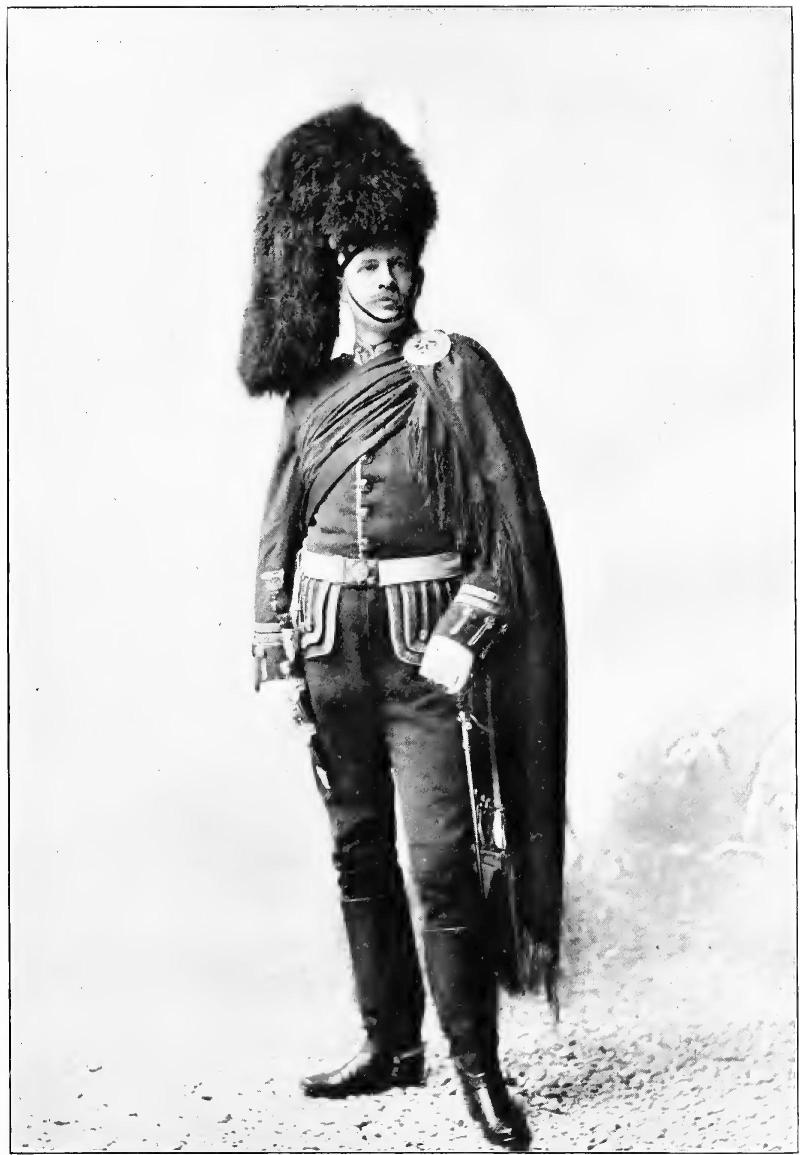
Lieut.-Col. John I. Davidson, First Commanding Officer 48th Highlanders. Now Honorary Lieut.-Colonel.
Johnstone’s Highlanders—101st (1760-1763)—embodied at Perth, and named after Sir James Johnstone, of Westehall, major-commandant of the regiment. They saw no active service.
Macdonald’s Highlanders, Old 76th (1777-1784). Raised by Lord Macdonald, in the Highlands and Isles. The first lieutenant-colonel was Major John Macdonald, of Lochgarry, from Fraser’s Highlanders. They served in the Revolutionary War, in New York and Virginia.
Athole Highlanders, Old 77th (1778-1783). Did garrison duty only in Ireland.
Aberdeenshire Highland Regiment, Old 81st, (1777-1783). Garrison duty only in Ireland.
These regiments were disbanded when the purpose of their organization had been accomplished. The Highland regiments succeeding them, which remain to the present day are ten in number, viz.:—
The 71st Highland Light Infantry, formerly Lord McLeod’s Highlanders (73rd).
The 72nd, Duke of Albany’s Own Highlanders, formerly Seaforth’s Highlanders and the 78th regiment.
The 73rd Regiment.
The 74th Highlanders.
The 75th Regiment (Stirlingshire).
The 78th Highlanders, or Ross-shire Buffs.
The 79th Cameron Highlanders, at first named the “Cameronian Volunteers.”
The 91st Argyle Highlanders, formerly the 98th Highlanders.
The 92nd Gordon Highlanders.
The 93rd Sutherland Highlanders.
Before these comes the 42nd Black Watch, the oldest Highland regiment in the British Army, making in all eleven Highland regiments in the Imperial service. They are regimented thus:—
The Black Watch (Royal Highlanders)—Depot, Perth.
42nd—1st Battalion of the Black Watch (Royal Highlanders).
73rd—2nd Battalion of the Black Watch (Royal Highlanders).
The Highland Light Infantry—Depot, Hamilton.
71st—1st Battalion of the Highland Light Infantry.
74th—2nd Battalion of the Highland Light Infantry.
Seaforth Highlanders—Depot, Fort George.
72nd—1st Battalion of Seaforth Highlanders (Ross-shire Buffs, Duke of Albany’s).
78th—2nd Battalion of Seaforth Highlanders (Ross-shire Buffs, Duke of Albany’s).
The Gordon Highlanders—Depot, Aberdeen.
75th—1st Battalion of the Gordon Highlanders.
92nd—2nd Battalion of the Gordon Highlanders.
The Queen’s Own Cameron Highlanders—Depot, Inverness.
79th—1st and 2nd Battalions of the Queen’s Own Cameron Highlanders.
Princess Louise’s (Argyle and Sutherland Highlanders)—Depot, Stirling.
91st—1st Battalion of Princess Louise’s (Argyle and Sutherland Highlanders.)
93rd—2nd Battalion of Princess Louise’s (Argyle and Sutherland Highlanders.)
It now remains to refer briefly to the Highland regiments which were stationed in Canada from the earlier part of this century down to the time when the Imperial forces were practically withdrawn from the Dominion. Following the numerical order consecutively, we have, first, the
Seventy-First Regiment—Highland Light Infantry. After a career of exceptional brilliancy from the time of its organization in 1777, as Lord MacLeod’s Highlanders, this regiment rested in Ireland for three years before 1824, when it embarked at Cork for Canada. It landed at Quebec, where the establishment was augmented from eight to ten companies (six service and four depot) and where headquarters were fixed. Companies were stationed at Sorel and Three Rivers. In 1827 the headquarters were removed to Montreal, and remaining there one year, were transferred to Kingston in 1828, and to Toronto in 1829, that city being then known as York. From Toronto headquarters, one company was stationed at Niagara, one at Amherstburg, one at Penetanguishene, and a small number of men occupied the naval port at Grand River, Lake Erie, occupying these stations for about two years. Sir Gordon Drummond was then colonel of the regiment, and was succeeded by Major-General Sir Colin Hackett. In 1831 the regiment moved to Quebec and embarked for Bermuda. Passing thence to Britain and thence to Ireland, the six service companies embarked again from Cork to Canada in 1838. In 1840 the six service companies were at St. John, New Brunswick, whence they went to Montreal in 1842, where they were joined by the reserve companies of the regiment, under Lieut.-Colonel James England, the six service companies being under the command of Major William Denny, who, upon the arrival of Lieut.-Colonel England, took command of the reserve companies and took up quarters at Chambly. The service companies, now forming the 1st battalion of the regiment, left almost immediately afterwards for the West Indies, leaving the reserve companies, or 2nd battalion, at Chambly. The movements of Major Denny’s command were frequent. In 1845 the headquarters and three companies were removed to Kingston; in 1846 from Kingston to La Prairie; in 1847 from La Prairie to Chambly; same year from Chambly to St. John, N.B.; in 1849 from St. Johns to Montreal; in 1850 to Toronto, where a year was spent; and in 1852 to Kingston, where Lieut.-Colonel Sir Hew Dalrymple, Bart., who had been in command, retired from the service, and was succeeded by Lieut.-Colonel Nathaniel Massey Stack. In 1854 the battalion in Canada returned to Great Britain, and took part in the Crimean War.
The Seventy-Third Regiment was stationed in Nova Scotia in 1838, remaining in garrison until 1841, when it was withdrawn.
The 74th Highlanders—whose distinguished services are second to none—embarked at Cork for Halifax in 1818. Companies were stationed at St. John’s, Newfoundland; St. John, New Brunswick, with headquarters and five companies at Fredericton, N.B. In 1823 headquarters were removed to Halifax, remaining until 1828, when the regiment embarked for Bermuda, whence in 1830 it reached Ireland. In 1841 it was once more stationed in Canada, with headquarters at Quebec, Montreal, and La Prairie. It moved to Nova Scotia in 1844, and left for Britain in 1845, and in 1846 the tartan was restored to it for trews, and the plaid cap became the head-dress.
The Seventy-Eighth Highlanders.—That so distinguished a Highland regiment as the 78th, Ross-shire Buffs, should receive a most cordial welcome to Canada, from the enthusiastic Scottish clansmen, is only what might have been taken for granted. The patriotic, yea, the old national feeling was fairly roused. The regiment under the command of Lieut.-Colonel Alexander Mackenzie, of Belmaduthy, arrived at Montreal from Gibraltar in July, 1867. A course of musketry instruction was taken at Chambly and work was put on the fortifications at Quebec. An event of interest in the military history of Canada and of the regiment took place on the 30th of May, 1868, when new colours were presented to it on the Champ de Mars, Montreal. The old colours bore the stain and tatters of many a hard-fought field, in which the fate of the day was not seldom sealed by the bravery of the regiment, and the new colours did not take their place in succession without due homage and ceremony. The presentation was made by Lady Windham in the presence of ten thousand spectators. The Rev. Joshua Fraser offered the consecration prayer, after which the colours were handed over to Ensigns Waugh and Fordyce. Lieut.-General Windham, the Commander-in-Chief, addressed the regiment in terms of the highest praise. The 78th Highlanders, he said, had always conducted themselves bravely and with unsullied loyalty. The old colours were sent to Dingwall, Ross-shire, to be there preserved. In May, 1869, the regiment left Montreal for Halifax. Before leaving Montreal an address, couched in complimentary terms, was presented to the regiment by the St. Andrews Society, of Montreal. The regiment remained in Nova Scotia until 1871, companies doing duty regularly at St. John, N.B., and in November of that year it embarked for Britain.
The Seventy-Ninth, Cameron Highlanders.—Embodied in 1793, the Cameron Highlanders, when it arrived in Canada in 1825, had already a long and distinguished career behind it,—the glories of Waterloo, immortalized by Byron:
“And wild and high the ‘Cameron’s Gathering’ rose,
The war-note of Lochiel, which Albyn’s hills
Have heard, and heard too, have her Saxon foes:—
How in the noon of night that pibroch thrills
Savage and shrill! But with the breath that fills
Their mountain pipe, so fill the mountaineers
With the fierce native daring which instils
The stirring memory of a thousand years
And Evan’s Donald’s fame rings in each clansman’s ears.”
Dr. A. Anderson, regimental surgeon, tells that in 1809 “the 79th did what no other regiment did. In January of that year they were in Spain at the Battle of Corunna and returned to Britain in February, when 700 men and several officers suffered from a dangerous typhus fever, yet not a man died. In July they embarked 1002 bayonets for Walcheren, were engaged during the whole siege of Flushing in the trenches, yet not a man wounded, and whilst there lost only one individual in fever—Paymaster Baldock, the least expected of any one. During the three months after their return to Britain, only ten men died, and in December of that same year again embarked for the Peninsula, 1032 strong.” Men with such impervious constitutions and good luck “were not born for nothing,” and the Camerons well-merited the application of the adage.
In the spring of 1825 the 79th embarked at Cork for Canada under command of Colonel Sir Neil Douglas. Headquarters were fixed at Quebec, where the regiment remained until 1828, when they removed to Montreal. On the anniversary of Waterloo, the 18th of June, 1828, the regiment was presented with new colours at Montreal, the gift of Lieut.-General Sir R. C. Ferguson, who had succeeded Lieut.-General Sir Alan Cameron in the colonelcy of the regiment. The ceremony was performed by Lady Douglas, on the Champ de Mars, in the presence of a vast concourse of people. In 1833 headquarters were removed to Quebec, where the regiment was stationed during its further stay in Canada—until 1836. The 79th was again stationed at Quebec from July, 1848, until August, 1851, when before leaving, the mayor and council in a letter addressed to Lieut.-Colonel the Honourable Lauderdale Maule, bears testimony to the excellent conduct of the men. The officers and men erected in St. Andrew’s Church, a marble tablet to the memory of the non-commissioned officers and men who died during the period of service in Canada.
The Ninety-Third, Sutherland Highlanders.—The 93rd was ordered to Canada in December of 1837, co-incident upon the rising of 1837, there. In January, 1838, the regiment, in two divisions, embarked at Cork, one under Lieut.-Colonel Duncan MacGregor, and the other under command of Major Arthur. Both divisions were united at Halifax. During the troubles in Canada the regiment had not an opportunity of meeting the enemy except at Prescott, at the attack and capture in the Windmill. At this period the regiment was very much divided, but before the end of the year, 1838, the companies came together at Toronto, where Lieut.-Colonel Spark took command in succession to Lieut.-Colonel MacGregor. Its stay in Canada extended over ten years. It remained in Toronto from the beginning of 1838 until the 17th June, 1845, with the exception of one year—May, 1840, to May, 1841—when it was stationed at Drummondsville, near Niagara Falls. While in Toronto in 1842 an order from the Horse Guards pays a high tribute to its morale, and by implication the reverse of a compliment to that of the Toronto of those days. It runs: “This fine regiment still continues to maintain its character for comparative sobriety and good order amidst the dissipation with which it appears to be surrounded, and that it is as remarkable for its splendid appearance in the field, and the correctness of its evolutions, as for the quiet and orderly habits of its men in their quarters.” In May, 1845, the 93rd proceeded to Montreal, where it was joined by a part of the regiment which had been stationed for several months at Kingston. About a year was spent at Montreal and nearly three in Quebec, when in 1848 it returned to Scotland, later on to win the undying glories of the Crimea and India.
From the ranks of these regiments Canada drew not a few citizens who have distinguished themselves in every line of enterprise, in commerce, finance, the professions and in public life. Men who having the hardy training of soldiers, and the sterling character of their race, have done incalculable service in laying the foundations of this young country and in building upon them a superstructure of which their descendants need not feel ashamed.
Some of the officers and men who came to Canada with the Highland regiments above referred to settled down to the peaceful avocations of life in the new land instead of accompanying their regiments back to the land of their fathers for their discharge there. We find them turning their military knowledge to the advantage of Canada in connection with the militia of the country. Those with strong Highland proclivities naturally favoured corps on the plan of the Highland regiments in which they had served, even to the dress and name. Evidences of their activity are to be met with at Quebec, Montreal, Ottawa, Kingston, Toronto, Whitby, Hamilton, and London, Ont., where Highland Companies were formed, but they had had precedents to go by in the far past. One of the earliest is the Highland Company which composed the left of the Queen’s Rangers, commanded in the Revolutionary War by Colonel Simcoe. Colonel Stephen Jarvis says of it: “I was eye witness to a very brave exploit performed by the left division, the Highland Company, under the command of Captain, afterwards Major-General Æneas Shaw. One of the field pieces belonging to the Light Infantry had got fast in a quagmire, and at last was abandoned by the artillery attached to it. The rebels gave a shout: ‘Huzza! the cannon is our own,’ and advanced to take possession when Captain Shaw ordered his division to the right about, charged the enemy and brought off the cannon, which was ever after attached to the regiment.”
Highland Company of Montreal. The Highland sentiment so unmistakeably traced in the military life of Montreal, at an early date manifested itself in the formation of a Highland Company which became a part of the Prince of Wales Regiment. This regiment was the first which was formed under the Militia Act of 1859, having been constituted on the 17th of November, 1859, and therefore, having the honour of being named the “First Battalion,” Canadian Militia. The regiment was formed of companies which had been in existence previously as independent rifle companies of volunteers. The first of these companies was organized on the 31st of August, 1855, and the others between that date and the 4th of April, 1857, when the ninth company was formed. Two and a half years later they were united in a battalion. No. 7 Company was raised on the 16th October, 1856, and was authorized as a Highland Company. The command of the company was entrusted to John Macpherson, a member of No. 1 Company, the first lieutenant being George McGibbon, and the first ensign Peter Moir. On the embodiment of the battalion Captain John Macpherson continued in command of the Highland Company, with Peter Moir as lieutenant, Duncan Macpherson as ensign, and George Brown as supernumerary ensign. The dress was a green coat faced with red and gold, tartan MacKenzie trousers, tartan shoulders plaid, Highland bonnet with ostrich plumes and red feather. The officers wore the dirk and broadsword, and the piper, the full Highland costume, the kilt and its accoutrements. The members of the company were described, on the occasion of a visit to Portland, Maine, in 1858, “thoroughly Scotch in features, spare and sharp, and in their native tartan, like true followers of the Bruce.”
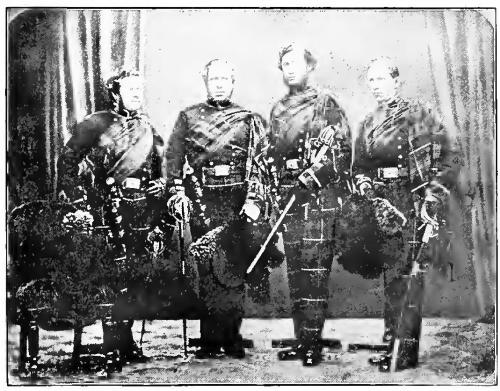
Officers of the Highland Company of the Prince of Wales Regiment, 1859.
In 1860 the Commissioned Officers were: John Macpherson, Captain; Peter Moir, Lieutenant; George Brown, Ensign; Alex. Graham Lindsay, Supernumerary Ensign. Non-Commissioned Officers: Colour Sergeant, James Stenhouse; Sergeants, Thomas McWilliams, David Laurie, W. G. Slack, James Scott, John Willock, James Ridley; Corporals: Walter McGrath, Murdoch McKenzie, John Buchanan, Robert Slater, Donald Hamilton; Pipers: James Macdonald and Archibald McGinnis; Bugler, Ashley Cole.
The Company afterwards joined the 5th Royals, which later became the 5th Battalion Royal Scots of Canada.
Among the things around which military memories linger in Toronto is the Company of Highland Rifles, at one time attached to the Queen’s Own Rifles. The veterans of to-day delight, as veterans only do, in reminiscences of the time when they served in its ranks, and to them it is a source of regret that no adequate account of it has been preserved.
Within the scope of this work only a brief notice is permissible; yet, as a company in which the Highland idea of soldiering was enthusiastically upheld and exemplified, a short sketch is obviously in place in this volume.
The company was raised on the 18th of September, 1856, those chiefly instrumental in its organisation being: A. M. Smith, at one time in the 93rd Sutherland Highlanders; A. T. Fulton, merchant; John Gardner, at one time in the 71st Highland Light Infantry; Robert Sutherland and Mr. R. H. Ramsay. The first officers were: A. M. Smith, Captain; A. T. Fulton, Lieutenant; John Gardner, Ensign; Francis McMannus Russell, Surgeon. It was then known as No. 3 Independent Volunteer Rifle Co. of Toronto. When the independent companies were formed into No. 2 Battalion Queen’s Own Rifles, the Highland Company was designated No. 4 (Highland). At that time Captain A. M. Smith was appointed Major in the Queen’s Own Rifles, and his place was taken in the captaincy of the Highland Company by Lieutenant Fulton, Ensign Gardner becoming Lieutenant, and John Sheddon, Ensign. This was in May, 1860. Captain Fulton is said by Mr. Chadwick to have been “a splendid drill, and aided by the natural steadiness of the Highlanders, soon obtained a reputation for his company which they ever afterwards maintained.” In 1863 Captain Fulton retired, and Lieutenant John Gardner was, on the 21st August of that year, appointed to the command of the company, with R. H. Ramsay as Lieutenant, and Donald Gibson as Ensign. In 1866 Captain Gardner retired from active command and was succeeded by Lieutenant Ramsay as Captain, with Ensign Gibson as Lieutenant, and Mr. Henry Scott as Ensign. These were the officers of the company at the time of its dissolution.
Although No. 4 of the Queen’s Own Rifles, at first, the company was, being dressed in the kilt, always placed on the left of the line of the parade, and for this reason the number was changed from 4 to 10, the latter number being the one by which it is familiar to the survivors of those connected with it.
In 1866 Captain Gardner was associated with Captain Ramsay in the Fenian Raid expedition, and commanded at Ridgeway. It is related with pride how the Highland Rifles was the last to retire from the field. Mr. Matheson, druggist, Toronto, acted as company bugler that day, and when the “retreat” was sounded he did not interpret it as a retire call. Some one from the ranks called out to Captain Gardner that he had heard a retire call. That officer was enraged at the idea and shouted back: “If you say it again I’ll cut you down with my sword. It’s a charge. Are you ready?” Pouches were examined and those who had three or more cartridges left had to share one or more of them with those who had only one or none. The ammunition was nearly all spent. These are said to have been Captain Gardner’s orders: “We are now to charge. Steady men! Go forward at the double, keeping steady as if on parade. You know how to do it, you’ve done it often at drill. Keep steady as you march on, but cheer for all you’re worth.” The company advanced about twenty paces at the double when an officer rode up and shouted “Halt! where are you going with these men, sir? Can’t you see the line has retired?” The order was then given: “The shortest way to the reserve,” and the company retired. Among those wounded were John Whyte and Forbes McHardy.
The company lay at Stratford for some weeks, and there a photograph was taken of the company, with its officers in front, which is a much cherished relic in many homes now scattered over Canada and the United States, for members of the Highland Rifles have followed Fortune wherever her smile beckoned. On the 1st of October, 1868, the company disbanded because the Government refused to grant an allowance in lieu of the ordinary uniform; or perhaps it would be more correct to say that for the sake of uniformity the military authorities insisted upon the company adopting the same uniform as the other companies of the regiment wore, and as the Highlanders were not permitted to wear the kilt, they declined re-enrollment under the Militia Act of 1868, and so became extinct.
The members continued to meet at their old rendezvous, and not having now the bond of military duty to keep them together, the idea occurred to some of them that they should form themselves into a Scottish society. About that time the old Highland Society of Toronto was less active than usual, and an amalgamation was brought about between it and the members of the Highland company, the combined body being named the “Caledonian Society of Toronto,” including Highlander and Lowlander, under the Gaelic name “Caledonia,” usually derived from “Coille daoine,” “Woodlanders.” It is interesting to note that the society thus formed, should, twenty-three years afterwards, in 1891, have retained so lively a recollection of the experiences associated with the old Highland Rifles as to be among the most enthusiastic promoters and generous donors of the 48th Highlanders at the period of its organization.
The interesting list of the original members is as follows: the officers as already mentioned; Quarter-Master-Sergeant George Ocil, Col.-Sergeant Robert Sutherland, Sergeants Robert Morrison and James Gray, Corporals Robert Jaffray and Wm. Ramsay, Piper Donald MacRae, Bugler Wm. Wallace, Privates Archie McFarlane, Wm. Bansley, Alexander Barrie, Henry Braid, John Calver, William Cos, Nicholas Cumming, Andrew Fleming, Peter Gardner, George Gilchrist, William Goldie, George Gratton, Alexander Gray, Allan Walker, Walter Wilson, Daniel Rose, James Mowatt, John Atchison, Neil Johnston, Wm. G. Kemp, Alexander Moodie, Malcolm Morrison, Joseph McGeorge, Wm. McGeorge, Alaistair MacDonald, Thomas MacIntosh, Duncan MacKinnon, Alistair M. Oliphant, Henry McLeod, Robert H. Ramsay, Adam Reid, David Ross, Alexander Thorburn, George Wills, James Wilson, and Sam. Hutcheson.
The uniform was the same as that of the 93rd Sutherland Highlanders, with the exception of the feather bonnet—the glengarry being worn—and the tunic, which was of green material with red facings.
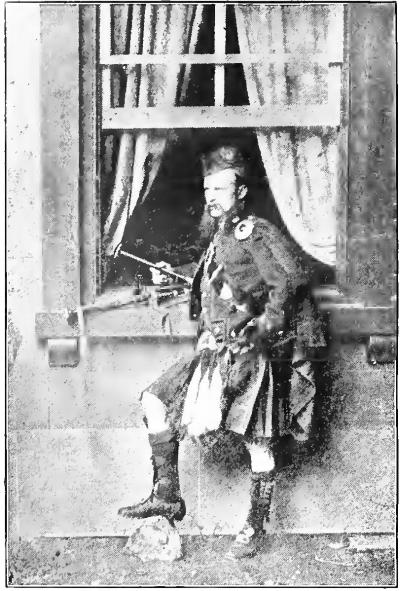
Alexander M. Oliphant. Pipe-Major, Highland Rifles, Toronto, 1865.
Another Highland company which was connected with the Queen’s Own Rifles, Toronto, was “F” or No. 6 company of Whitby. It was incorporated with the Queen’s Own on the formation of the latter in 1860. It does not appear to have ever paraded with the regiment although not gazetted out until November, 1862. It is now No. 1 Company of the 34th regiment.
The 5th Battalion “Royal Scots of Canada,” Montreal, need merely be mentioned. They were embodied in 1862, as the 5th Royals, with six companies. They now wear full Highland uniform (kilts). The badge is the popular clan badge, a boar’s head, and the motto “Ne obliviscaris,” the same as those of the 91st Princess Louise’s (Argyle and Sutherland Highlanders).
The 20th, “Lorne Rifles,” Halton, under Lieut.-Colonel Allan, an enthusiastic Highland soldier, wore tartan trews and diced bonnets. Except the name, nothing now remains to indicate the Highland influences which at one time dominated it.
The 15th, “Argyle Light Infantry,” Belleville, bears a Highland name, and as a badge has the Campbell Boar’s Head, with the motto, “Nulli secundus.”
The 78th battalion, “Colchester, Hants and Pictou,” headquarters, Truro, Nova Scotia, has the title “Highlanders” after their designation, evidently in honor of the number 78th, though there should be no lack of good Highland material in Pictou to fill the ranks of the regiment.
So with the 79th battalion, Shefford, Waterloo, Quebec. The word “Highlanders” is used in the name, and more pronounced still are:
The 94th, “Victoria” battalion, “Argyll Highlanders,” with headquarters at Baddeck, Cape Breton, where men of Highland blood, aye and speech too, are numerous, and the Celtic sentiment strong.
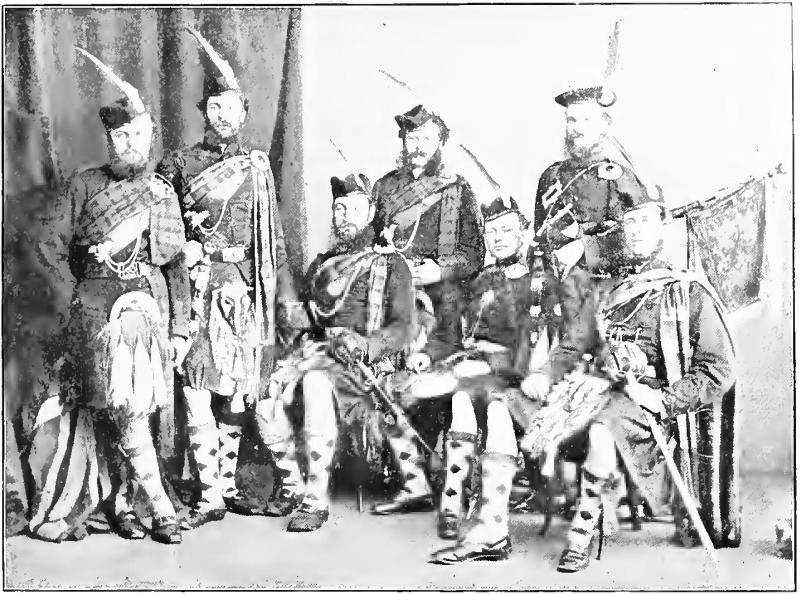
Officers and Non-Com. Officers Highland Company, Q.O.R., 1868.
Capt. Robert H. Ramsay.
Pipe-Major A. W. Oliphant.
Col.-Sergt. Robert Bain.
Sergeant Grassick.
Lieut. Donald Gibson.
Ensign Henry Scott.
Sergeant J. MacDonald.
A few years ago a few Highlanders in Hamilton, Ont., headed by Mr. John Niven Macdougall, made an effort to raise one or two Highland companies, which it was proposed should be attached to the 13th Regiment. The object in view was maturing, it was thought favorably, when some unaccountable obstacle arose in connection with the relation which the company should have to the 13th, and the project was, for the time being, abandoned. But the money for the uniforms and the men to wear them, were then available.
Recently the movement has been launched on a more ambitious plan. The idea now is to organize a battalion, and the following gentlemen are acting as a committee for the promoters:—Messrs. Colin MacLeod (chairman), George Upsdell, H. Ward, J. Eves, J. Coombes, W. G. Reid, J. R. Graham, and Dr. Gibson. It is said that public feeling in Hamilton is strongly in favour of the formation of a Highland regiment for that city, and no insuperable difficulty seems to stand in the way of accomplishing their desire.
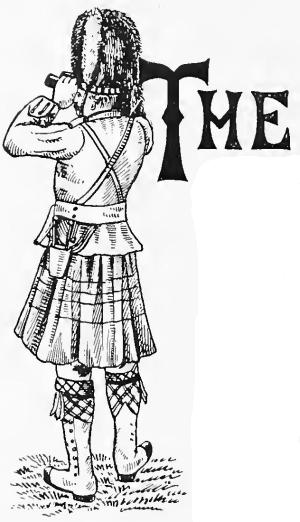
steps leading to the formation of the 48th Highlanders must, naturally, occupy an important place in this brief sketch. The organization of such a regiment—a militia corps mainly composed of Scotsmen, wearing the Highland dress, and having a band of pipers—had been discussed occasionally for some years prior to 1891, when the idea took definite form. The existence of the 5th Royal Scots in Montreal was a constant incentive to Toronto, and the visit of that corps to Toronto in 1884 stirred the desire for a like regiment there. In the Minutes of the Toronto Gaelic Society for 1884, reference is made to a discussion of the subject at a meeting of the society, when an enquiry was ordered as to the cost of raising and equipping a Highland regiment, but the subject does not appear to have been revived. A few years later a proposal was made to form a uniformed corps in connection with the Sons of Scotland Association, which, while it did not secure the support necessary to carry it through, was the real stepping-stone to the larger movement resulting in the formation of the 48th Highlanders.
Early in 1891 the question was taken up by Captain Wilbur Henderson and Alexander Fraser, and a meeting of Scotchmen was called by circular, and invitation to the various Scottish societies in Toronto, to convene at Temperance Hall, the meeting place of Burns’ Camp, Sons of Scotland, Toronto. The announcement of the meeting was well received by the Scottish societies, and the attendance was fairly representative of the Scottish community. Sixteen of those present agreed to sign a provisional roll, the first to sign his name being Mr. James Henderson; thus the nucleus of the regiment was formed. Mr. D. M. Robertson, Barrister, acted as secretary of the meeting, keeping a record of the proceedings, and Captain Henderson was asked to take charge of the informal enrolment of the men. Some time having passed without further action, the Gaelic Society moved in the matter, instructing its officers to co-operate with Messrs. Robertson, Henderson, and Fraser. Accordingly, a meeting of the officers was held on 31st May, 1891, at Ardchronie, the residence of Mr. William Innes MacKenzie, president of the society, and it was there agreed to invite representatives of the St. Andrews, the Caledonian, and the Sons of Scotland Societies to meet representatives of the Gaelic Society at Oakville, Ont., on the 27th June, the occasion of the annual excursion of the latter society, there to devise means for the furtherance of the movement. The meeting at Oakville took place, but the attendance being small, Mr. Alexander Fraser, the secretary of the Gaelic Society, was instructed to call another meeting at the Queen’s Hotel, Toronto, on an early day. Three days later, on the 30th June, this meeting was held, and at that meeting the movement was formally launched.
A full abstract of the Minutes of the Meeting will be interesting:—
“First Meeting of the Standing Committee.
“Queen’s Hotel, Toronto,
“30th June, 1891.
“Convened: In response to an invitation sent by the officers of the Gaelic Society of Toronto to the officers of the St. Andrew’s and Caledonian Societies, of Toronto, and to the Grand Chief of the Sons of Scotland, the following gentlemen convened at the Queen’s Hotel, Toronto, on the above date, for the purpose of considering the question of the formation of a Highland regiment (to wear the kilt) in Toronto, viz:— From
“The St. Andrew’s Society, Dr. Daniel Clark, President; Dr. James Thorburn, George Kennedy, LL.D., Secretary.
“The Caledonian Society, Messrs. Robert Swan, President, and William Adamson, Secretary.
“The Gaelic Society, William Innes MacKenzie, President; John Cattanach MacMillan, Donald M. Robertson, David Spence, and Alexander Fraser, Secretary.
“The Sons of Scotland Association, Mr. J. M. Wingfield, J.P., Grand Chief.
“There were also present, Messrs. Hugh Miller, J.P., Wilbur Henderson, Kenneth Miller and George MacKenzie.
“On the motion of Mr. William Adamson, Dr. Daniel Clark was appointed chairman, and Mr. Alexander Fraser, secretary of the meeting.
“At the request of the chairman, Mr. Fraser explained the object of the meeting and then moved:
“That those present constitute themselves a standing committee, with power to add to their number, for the purpose of bringing about the formation of a Highland regiment in Toronto, the uniform of which would be after the pattern of a Highland regiment in the British army; that in furtherance of this object steps be taken to obtain the consent of the Government; and, as far as possible, to raise the money necessary for preliminary and regimental purposes.
“This resolution was unanimously carried, and the chairman declared the meeting to be then one of the Standing Committee on the Highland regiment, and asked that the officers of the Committee be appointed.
“It was moved by Mr. Wm. Adamson, and seconded by Mr. Hugh Miller, J.P., that Dr. Daniel Clark be chairman of the Standing Committee. This was unanimously agreed to.
“It was moved by Dr. George Kennedy, and seconded by Mr. David Spence, that Mr. Alexander Fraser be secretary of the committee. Unanimously agreed to.
“On the motion of Mr. Alexander Fraser, it was decided to meet on call, to consider what steps should be taken to obtain the consent of the Government; and in the interval that members of committee should report to their respective societies, asking their assistance in popularizing the movement with the citizens, and should in other ways help it forward.”
From this date the movement was pushed forward with great energy. Meetings were sometimes held daily but interest did not flag, and in the brief period of little more than one month, the Government’s consent to the formation of the regiment had been obtained. Not without much hard work, however. Immediately after the organization of the Standing Committee had been announced communications from military men and from citizens were received warning the promoters against proceeding on account of the large expenditures and the heavy responsibilities the project would involve. These warning notes were useful in leading the committee to adopt larger measures, and to lay a broader basis for their plans than they might otherwise have done; but they had no discouraging effect, nor did they shake the determination to bring the matter to a successful conclusion. In preparing the estimates of the expenditure which the formation of the regiment would entail the committee received valuable help from Lieut.-Colonel Hamilton, Queen’s Own Rifles, and from Captains John Bruce and J. D. Hay, of the Royal Grenadiers.
On the 3rd July, 1891, the question of who should be offered the command of the regiment, provided it should be established, was for the first time considered. The secretary was able to state that he believed Captain John Irvine Davidson would be available, and it was unanimously agreed to offer the command to Captain Davidson, whom failing, the same to be offered to Mr. D. R. Wilkie, Banker. The committee appointed to wait on Captain Davidson in this matter consisted of Messrs. D. M. Robertson, Alexander Fraser and Dr. Kennedy. Captain Henderson was, at the same meeting, requested to call a meeting of the men who had been provisionally enrolled, to whom Capt. Davidson’s name would be submitted for approval. The committee reported at a meeting held on the 6th July that Capt. Davidson had accepted of the command, and the secretary was able to report at the same meeting promises of liberal financial support from many leading Scotsmen of whom the following, among others, having been the first to come forward, deserve to be placed high on the roll of honour, viz.: Hon. Sir D. L. Macpherson, K.C.M.G., Paul Campbell, Hon. Senator John Macdonald, Hon. Senator Allan, Mr. D. R. Wilkie, Mr. Frederick Wyld, Mr. John Kay, Mr. W. H. Beatty, Mr. Wm. Christie, Mr. Robert Jaffray, Mr. Donald McKay, Mr. J. K. Macdonald, Mr. J. L. Morrison, Mr. Robert Swan, Mr. Wm. Mortimer Clark, Mr. Charles Walker, and Dr. Andrew Smith.
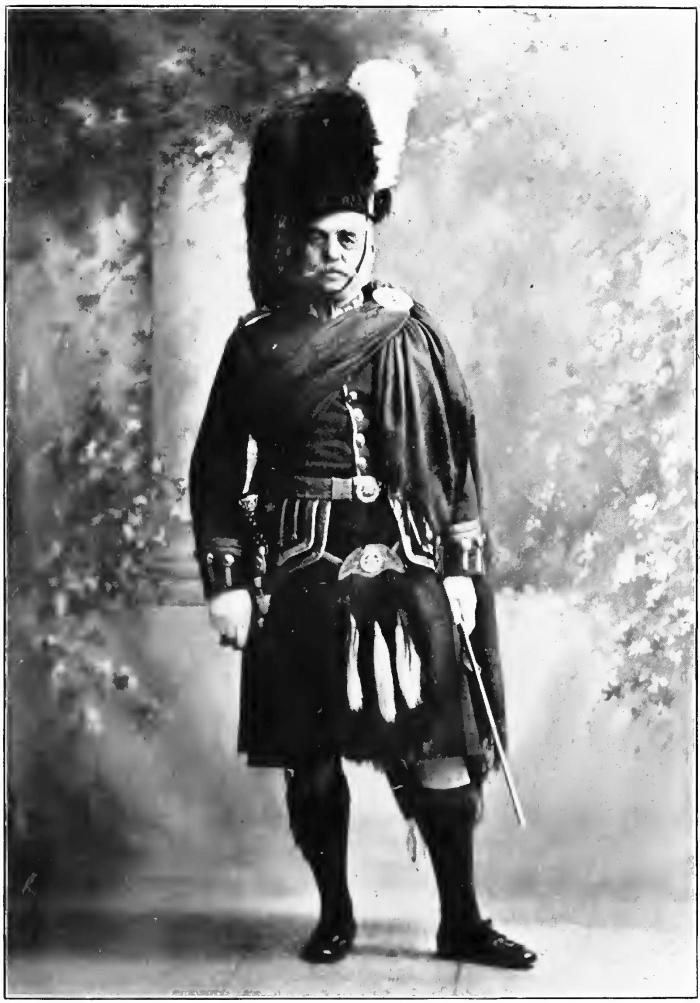
The Late Lieutenant-Colonel A. M. Cosby.
Commanded 48th Highlanders from 1898 to 1900.
At this time the chief difficulty appeared to be to secure the consent of the Canadian Government to the proposal. The first deputation to the Government consisted of Messrs. D. M. Robertson and Alexander Fraser. On the 10th July they reported the result of their visit to Ottawa. The Government refused to sanction the formation of a new regiment on the ground of expense, and because they had refused that year to add to the strength of the militia in the provinces of Quebec and British Columbia. The Government consented to receive another deputation but would hold out no hope of success. The Senators and Members of Parliament who actively assisted Messrs. Robertson and Fraser in their interview were Senator G. W. Allan, Toronto; Senator Donald Macmillan, Alexandria; Lieut.-Colonel Roderick R. MacLennan, Glengarry; Hugh John Macdonald, Winnipeg; Arthur W. Ross, Lisgar; Lieut.-Colonel Tyrwhitt, Simcoe; D’Alton McCarthy, Simcoe; G. H. Macdonell, Algoma; Hon. G. A. Kirkpatrick, Kingston; and Geo. Monteriff, Petrolia; Senator McInnes, British Columbia; and Dr. Bergin, M.P., Cornwall. Shortly after the first interview the Minister of Militia wrote stating that the Government had not altered its view that a Highland regiment should not be formed in Toronto, and in consenting to receive a deputation a second time, it must be clearly understood that such consent was not to be taken as an encouragement to persist in the movement. Doggedly the Standing Committee set about to overcome the Government’s objections. The city Council of Toronto was approached and passed a resolution in favour of the movement, and a deputation consisting of Messrs. D M. Robertson, Alexander Fraser, and Frederick Wyld, visited Ottawa, on the 24th of July, to forward the cause. At Ottawa they were joined by Mayor Clarke and Alderman Saunders, Toronto, who strongly urged the Government to yield to the wishes of the Toronto Scots. At this interview Hon. Geo. E. Foster, the Minister of Finance, manifested a deep interest in the proposed regiment, and stated that with the consent of his colleagues he would remove the financial difficulty, whereupon the other ministers present consented to sanction the formation of a Highland regiment in Toronto, and Sir Adolphe Caron, Minister of Militia, at once gave formal notification of this decision. The news was received in Toronto with great rejoicing, and satisfaction was felt in the Scottish settlements throughout the Province of Ontario, for the plucky fight made at Ottawa had attracted the attention of the press and of the country.
The work of the Standing Committee now began in earnest, for the undertaking to which they had pledged themselves was one of no small magnitude. Further details, however, need scarcely be narrated here. The subscriptions to the Regimental Fund were on a princely scale in many instances, and in many more they were the small donations of patriotic enthusiasts. On the 6th August, 1891, the Standing Committee was reorganized to stand as follows:
The Presidents and Secretaries of the Scottish Societies in Toronto, viz.:
St. Andrew’s Society, Dr. Daniel Clark and Dr. George Kennedy; Caledonian Society, Messrs. Robert Swan and William Adamson; Gaelic Society, Messrs. William Innes MacKenzie and Alexander Fraser; Sons of Scotland, Messrs. J. M. Wingfield and William Banks; Caithness Society, Alderman Geo. MacLean Rose; Orkney and Shetland Society, Mr. Wm. Houston, M.A.; and
Messrs. Frederick Wyld, A. M. Cosby, D. M. Robertson, A. M. Smith, John I. Davidson, D. R. Wilkie, Thos. McCracken, Hugh Miller, Robert Barron, James Massie, J. K. Macdonald, Dr. Thorburn, John A. Currie, Dr. W. Theophilus Stuart, Paul Campbell, George MacKenzie and J. Wilson Gray.
From this general committee sub-committees were appointed, viz.:
Regimental Committee, to decide upon the name of the regiment, the uniforms to be worn, etc., consisting of Capt. John I. Davidson, Frederick Wyld, Dr. Kennedy, D. M. Robertson, George MacKenzie, J. A. Currie and Alexander Fraser, with Mr. Frederick Wyld as chairman.
Committee on Finance, to arrange the details of collecting the necessary funds, consisting of Messrs. Frederick Wyld, A. M. Cosby, Thos. McCracken, Paul Campbell, J. A. Currie, Dr. W. T. Stuart, D. M. Robertson, Dr. Kennedy, Wm. Adamson and Alexander Fraser, of which also Mr. Wyld was chairman.
The first meeting of the Regimental Committee was held on the 11th of August, 1891, at which some important business was transacted. It was decided, on the suggestion of Captain John I. Davidson, the commanding officer, designate, that the name of the regiment be “The Queen’s Highlanders,” should permission be obtained. Mr. Fraser submitted patterns of the following clan tartans from which to choose one for the new regiment:—Cameron, Gordon, MacKenzie, Davidson, Macdonald, and Hunting Stuart, with a recommendation in favour of the Old Davidson tartan in honour of the first C.O. of the regiment. Dr. Kennedy moved, seconded by Mr. John A. Currie, that the Old Davidson tartan be adopted as the tartan of the regiment, and this was unanimously agreed to. On the motion of Mr. Fraser the motto “Dileas gu brath” was chosen, also a falcon’s head, erased, as the regimental crest.
Correspondence was opened with the Militia Department, Ottawa, with respect to the number by which the regiment should be known, and the number of one of the Highland regiments of the British army was suggested, but that suggestion could not be acted upon, and there being a vacancy in the number 48, that number was given to the regiment with the word “Highlanders” to designate it, the name “Queen’s Highlanders” not being considered available by the Department.
Among the first donations to the funds was one of five hundred dollars from the Caledonian Society of Toronto, and the equivalent in money of seven stands of pipes from the Gaelic Society of Toronto.
The regiment was gazetted on the 16th October, 1891, and Captain Davidson’s appointment as Lieut.-Colonel was gazetted (provisionally) on the 20th November, 1891. The general committee, however, continued in existence till the 28th of March, 1892, giving special attention to the finances of the organization. A number of the officers having then been selected, the Committee was dissolved, a few of the more active members acting with the officers for a short time longer in financial matters.
During the early part of the Fall the men were regularly drilled by Captain Henderson, who in the latter part of October gave place to Captain J. C. Macdougall, of the Royal School of Infantry, the latter having been appointed to act as interim adjutant by the Major-General commanding the militia.
The General Order embodying the corps read as follows:—
Militia General Orders.
Headquarters, Ottawa, 16th October, 1891.
General Orders 19.
No. 4. Increase of Establishment of Active Militia.
Authority having been granted for the raising in the City of Toronto of eight companies of Active Militia of the strength of 42 non-commissioned officers and men per company, to be formed into a battalion wearing the Highland Dress the Deputy Adjutant-General of Military District No. 2 will submit service rolls of those persons volunteering for service in those companies.
By Command,
Walker Powell, Colonel,
Adjutant-General of Militia, Canada.
Acting upon this order, the men were sworn in by Lieut.-Colonel Otter, D.A.G., in St. Andrew’s Hall, Toronto, on the 22nd of October, 1891, when 152 men signed the roll and were taken on the strength of the regiment. The oath of service was taken on a Gaelic Bible furnished by the writer, which he values as a memento of an interesting and historic ceremony. The regiment having been thus formed, took up quarters in the vacated buildings of Upper Canada College, King Street west, where, until the occupancy of the new Armories in 1894, it found a convenient and a comfortable home.
Following are the names of the men who joined the regiment in 1891-2 and were on its first pay roll in the summer of 1892. The Regimental numbers indicate priority of enlistment.:—
“A” Company—No. 1 Private J. R. Graham, 2 J. W. Grant, 3 R. W. Emslie, 4 R. McNeill, 5 N. D. Shaw, 6 Jas. Barrie, 7 Duncan MacKinnon, 8 Piper Robert Drummond, 9 Private A. G. Robertson, 10 Geo. Simpson, 11 J. D. Henderson, 12 G. A. Harris, 13 E. T. Wilson, 14 J. A. Milne, 15 W. Lamont, 16 J. Blackball, 17 A. Henderson, 18 A. McEachern, 19 F. Anderson, 20 J. Tait, 21 J. Lawrence, 22 J. Davidson, 23 D. McEachern, 24 W. H. Stewart, 25 W. Manson, 26 J. Graham, 190 G. Barlass, 202 William Harp, 205 S. F. Carmichael, 206 John C. Hill, 207 John Shand, 209 W. McIntosh, 211 Geo. L. Bailey, 215 E. T. Adams, 218 James Coutts, 219 Geo. Docter, 234 R. J. Brown, 241 R. J. Henderson, 244 Bugler Chas. Macdonald, 245 Bugler E. F. Burnham, 257 Private D. Ross, 263 Private A. Mishaw, 264 D. McCutcheon, 265 W. Fenning, 266 W. Robertson, 267 John Caskie, 268 Jas. Barritt, 269 A. W. Mishaw, 270 D. Mathieson, 293 H. L. MacKay, 326 D. A. Burgess, 341 A. W. Mack, 342 E. J. Fawke, 343 H. M. Dixon, 344 John Robertson, 345 Geo. W. Lee, 346 D. Graham.
“B” Company—No. 27 Private E. Sutherland, 28 Victor Pattullo, 29 Jas. Manson, 30 Wm. Milne, 31 Thos. S. Muir, 32 E. Cowper, 33 A. E. Bennett, 34 J. G. Macdonald, 35 Jas. McKay, 36 Jas. Florence, 37 David Scott, 38 A. Beattie, 39 A. M. Harper, 40 J. R. Fergusson, 41 John Langskill, 42 Hy. E. Beattie, 43 Donald Scott, 44 J. K. B. Turner, 45 Thos. Mills, 161 Piper Wm. Currie, 162 Private Wm. Brown, 163 R. E. Minister, 164 Jos. Crapper, 186 Wm. Bell, 213 D. R. Hamblin, 214 Robert Ireland, 227 W. Florence, 231 John Hollinger, 246 Bugler H. Illingworth, 258 Private A. Wilson, 259 W. H. Tovell, 314 J. Everett, 315 J. W. Kirkness, 316 Jas. Tait.
“C” Company—No. 46 Private George Stewart, 47 Harold Mitchener, 48 R. G. Ewing, 49 Jas. Forbes, 50 David Adam, 51 W. A. Pollock, 52 G. M. McBean, 53 Alex. Rose, 54 G. M. Rose, 55 Alex. Rose, 56 David Aitchison, 57 W. L. Connell, 58 John McBain, 59 Robert Robertson, 60 Neil MacKinnon, 61 J. W. Davidson, 62 J. R. Ross, 63 Geo. A. Cockburn, 64 George Robertson, 65 Robt. Roger, 66 D. C. Petrie, 185 Andrew G. Ross, 187 R. J. McPherson, 188 Piper Alexander McNaughton, 196 F. B. Linden, 197 Robert Somerville, 208 Frank Ogilvie, 220 John Trenholm, 247 Bugler A. Munro, 251 Private W. Charlton, 253 J. C. Tisdale, 254 Geo. Garlic, 279 John McLean, 280 John O’Brien, 281 K. McIver, 317 H. Sheppard, 318 J. Young, 319 Thos. Allen, 320 Hy. Kerr, 321 Geo. Booth, 328 Geo. Reid.
“D” Company—No. 67 Private Angus MacKay, 68 H. J. C. Smith, 69 G. B. Hunter, 70 Jas. Gordon, 71 Daniel Sinclair, 72 John Ogilvie, 73 Jas. Spears, 74 Jas. A. Glendinning, 75 Geo. Webster, 76 Jas. Ogilvie, 77 Alex. Ogilvie, 78 Alfred Mackie, 153 A. Murdoch, 154 Peter Smith, 155 R. B. Cromarty, 156 M. P. MacKay, 165 W. Gilroy, 166 D. Alexander, 167 Wm. Fidge, 168 R. J. Barthwick, 169 Jas. Miller, 170 John Edwards, 171 Jas. Cook, 172 E. Martin, 173 Jas. Cameron, 174 Alex. Fiddes, 191 T. Drummond, 193 J. W. King, 199 Thos. Bennett, 200 John Reid, 203 T. Faulkner, 222 Frank Aitken, 248 Bugler J. Chambers, 260 Private W. Wilson, 271 George Fraser, 272 Robert Fraser, 273 Gordon Smith, 274 W. Robinson, 276 J. Eddie, 277 W. Gordon, 278 W. Watts, 295 S. H. Dye, 324 A. Lindsay, 325 T. Sanford.
“E” Company—No. 79 Private G. T. Kyle, 80 David Rae, 81 Jas. D Legg, 82 David Legg, 83 W. C. Laing, 84 Wm. Bruce, 85 D. W. Smith, 86 Donald Morrison, 87 Wm. Davidson, 88 James Rae, 89 James Craig, 90 R. Henderson, 91 J. Birnie, 92 T. Couloquoy, 93 Alex. McTavish, 94 Wm. Craig, 95 R. MacLennan, 96 Jas. Headridge, 97 D. S. Johnson, 175 Angus MacLeod, 176 Wm. Grant, 228 Jas. F. Macdonald, 233 Piper John Sharp, 235 Private R. W. Crouch, 249 Bugler J. Fiddes, 261 Private D. Marshall, 306 J. M. Ewing, 307 H. McKay, 308 George Mowatt, 309 Wm. Barlow, 310 L. Hoskins, 311 J. N. Jeffrey, 312 J. A. Macpherson, 313 E. A. Lowndes, 323 F. W. Duncan.
“F” Company—No. 98 Private J. C. MacLellan, 99 J. Templeman, 100 G. W. Murray, 101 Alexander Cameron, 102 J. C. Hackland, 103 John Smeal, 104 C. Horne, 105 Andrew Fraser, 106 Arch. Stewart, 107 A. L. Trueman, 108 D. W. Batchelor, 109 G. Humphrey, 110 W. A. Munro, 111 John MacKenzie, 157 Wm. Richardson, 158 Jos. Little, 159 Wm. J. Hamilton, 160 A. C. Munro, 177 A. G. MacLean, 178 A. Robb, 189 R. Macdonald, 204 John Richardson, 221 Thos. Douglas, 225 D. McConnell, 229 Jas. L. Anderson, 242 A. Kennedy, 243 D. A. Macdonald, 250 Bugler W. Brown, 262 Private (Amb.) J. A. Wilson, 294 Piper Fred. Riddell, 296 Private W. F. Jamieson, 297 G. Graham, 298 J. Adam, 299 Jas. Clunas, 300 Edward Major, 301 F. D. Cockburn, 302 W. B. Reid, 303 W. Wilson, 304 M. Gordon, 305 Ransbury.
“G” Company—No. 112 Private John Fraser, 113 A. C. Milne, 114 J. W. Mathieson, 115 J. Macdonald, 116 A. Florence, 117 Chas. Low, 118 Piper George Murray, 119 Private T. F. Andrew, 120 Donald McArthur, 121 D. Woods, 122 R. McRae, 123 R. MacLeod, 124 W. B. S. Coutts, 125 M. McBain, 126 W. P. Oldright, 127 M. T. Stewart, 128 Jas. Munro, 129 W. Sutherland, 130 W. A. Graham, 131 D. Sutherland, 132 G. Stewart, 192 G. McKelvie, 195 M. McRae, 201 James Porter, 252 Bugler W. Oldbury, 256 Private Hy. Libbey, 275 Bugler T. Timpson, 322 James Hamilton, 329 J. Alexander, 330 W. Hall, 331 G. Marlborough, 347 H. Murphy, 348 D. Turner.
“H” Company—No. 133 Private Chas. MacKenzie, 134 Jos. W. Bruce, 135 Ben. Cameron, 136 Jos. Thompson, 137 George Thompson, 138 W. L. Smellie, 139 Wm. Roy, 140 H. G. Brown, 141 Thos. Guthrie, 142 Geo. Patterson, 143 Geo. G. Taylor, 144 John Dandie, 145 J. C. Stamm, 146 Hugh Rose, 147 T. H. Smellie, 148 John A. Nelson, 149 John G. Martin, 150 Adam Graham, 151 William Clerihue, 179 John McIntosh, 180 Magnus Sinclair, 181 C. H. Forster, 182 Wm. Stewart, 183 John Moore, 184 Edward Grant, 198 James Shaw, 210 F. G. Mitchell, 216 Arthur McEvoy, 217 Andrew G. Fraser, 223 Lauchlan MacNeil, 224 Chas. Johnston, 226 A. Berrill, 230 John MacLean, 232 Thomas Reynolds, 236 Thos. Cavanagh, 237 W. J. Bartram, 238 A. Smith, 239 H. McKay, 240 Chas. Cowie, 253 Wm. Johnston, 282 John Macdonald, 283 Fred. Yeomans, 284 H. Sutherland, 285 G. C. Brown, 286 Jas. Ross, 287 D. J. MacKay, 288 D. J. Proctor, 289 Geo. Allan, 290 G. F. Robinson, 291 D. H. MacDougall, 292 W. Hood, 350 A. Fawcett.
Bugle Band—No. 327 Private Jas. D. Thompson, 333 Bugler E. Robertson, 334 W. L. Smellie, 335 T. E. Cooper, 336 Alex. Anderson, 337 J. H. Matheson, 338 F. Barnett, 339 H. H. Evans, 340 W. McKim. Ambulance No. 332 Private J. D. McGill.
All of these men, up to No. 152, were sworn in at St. Andrew’s Hall, by Lieut.-Colonel Otter, on the 22nd October, 1891. From 152 to 350, the men came in gradually until discontinuance of battalion parade on 27th May, 1892, when the first strength of the regiment was returned.
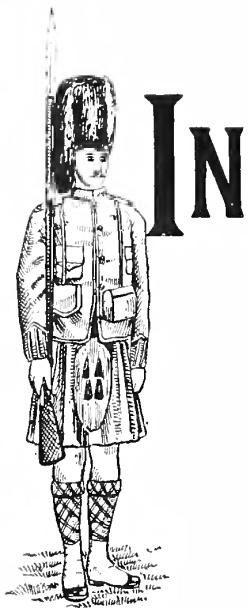
the spring of 1892 the regiment had emerged from its chrysalis, and had the appearance of a completed organization. The uniforms had been by this time received—modelled on that of the Gordon Highlanders, and manufactured in Inverness, Scotland. The strength of the battalion had reached about 350, and much hard work had been put on drill. The first officers were:—
Staff.
Lieut.-Colonel Commanding, John Irvine Davidson. Majors, Alfred Morgan Cosby, William Campbell Macdonald. Surgeon, William Theophilus Stuart, M.D. Assistant Surgeon, Alexander Anthony Dame, M.D. Chaplain, the Reverend Daniel James Macdonnell, B.D.
Adjutants (Acting), Captain C. J. MacDougall, R.S.I.; Captain Walter Macdonald.
Quarter-Master, James Adams.
Company Officers.
Captains: Donald Murdoch Robertson, Dugald MacGillivray, Wilbur Henderson (Captain and Bt.-Major), William Hendrie, Jr., John Allister Currie, Charles Albert Hunter, John Forbes Michie, Richard Scougall Cassels.
Lieutenants: George MacLean Rose, Duncan Donald, Donald Hector MacLean, William House Orchard, John Frederick Ramsay, Charles Alfred Campbell, John Æneas Thompson, Hugh Cameron MacLean.
John Irvine Davidson was born on the 17th November, 1854, at Wartle, Aberdeenshire. His father was Dr. Samuel Davidson, of Wartle. He was educated at Aberdeen, and as a young man began his business career in London, England. Coming to Canada shortly afterwards he rose rapidly in business, and besides becoming the head of the firm of Davidson & Hay, merchants, he soon occupied other important business and public positions. He was president of the Board of Trade 1890-91, was vice-president of the Canadian Bank of Commerce, is president of the St. Paul’s Mining Company, and a director of several commercial and financial institutions. His military career has been varied and uniformly successful. It began by a service of two and one-half years as a private in the 7th Aberdeenshire Volunteers. He next served as a private for one and one-half years in the London Scottish; one year in the Uxbridge yeomanry, and six years as lieutenant and captain in the 10th Royal Grenadiers. He holds a R.S.I. first-class certificate, and was formally confirmed in the command of the 48th Highlanders on the 25th March, 1892. No happier choice could have been made. His experience, his great capacity for work, his knowledge of human nature, his judicious management, are qualities he possesses more than ordinarily, and from which the organization of the regiment had every advantage. When he retired from the command in 1898 he was made honorary Lieut.-Colonel of the regiment.
Alfred Morgan Cosby was Canadian born. He was the eldest son of John Cosby, of Pelham, County Welland, Ontario, and was born on the 11th September, 1838. He was educated in Toronto, and entered the service of the Bank of Toronto in 1861. He was promoted to be manager of the branch of that bank at Port Hope, and in 1876 became managing director of the London and Ontario Investment Company, Toronto, a position he held until the year of his death (1900). He was one of the chartered directors of the Gooderham & Worts Company in 1882. He was a public-spirited citizen and among the institutions to whose success he contributed were the Upper Canada College, of which he was a trustee; the Toronto Conservatory of Music, of which he was honourary treasurer. He was also president of the Toronto Cricket Club, of the Canadian Cricket Association, and of the St. Andrew’s Society of Toronto. His connection with the organization of the 46th Highlanders began early in August, 1891, and he joined the regiment on its formation in the fall of that year as senior major. He had no previous military experience, but obtained a first-class R.S.I. certificate after his appointment. In everything connected with the regiment he took a leading part. On the retirement of Lieut.-Colonel Davidson, he succeeded to the command on March 16th, 1898, and held office until his lamented death on the 12th May, 1900. During his command the regiment maintained its high state of efficiency, and its high place in public favour, and few memories will cling longer to those early days than the appearance of the gallant Colonel and his two sons, one a captain and the other a lieutenant in the same corps, as they came and went on parade.
Commanding the 48th Highlanders.
William Campbell Macdonald comes of good Highland stock, and has inherited in no small degree the leading traits of the clans whose names he combines in his own—the splendid supremacy of the Macdonalds—“dhaindeoin co theireadh e,” and the undying tenacity of the Campbells. His grandfather was Daniel Macdonald, a native of Caithness-shire, who was engaged in business in Edinburgh, where his son Benjamin, Colonel Macdonald’s father, was born. He came to Canada with his family and settled in the township of Chinguacousy. Benjamin Macdonald married Dorothy Campbell, and to them among others was born William Campbell Macdonald. He has for many years occupied the important position of Actuary to the Confederation Life Association of Toronto.
Lieut.-Colonel Macdonald enlisted in the Queen’s Own Rifles in March, 1878; 2nd Lieutenant, March 1881; Lieutenant, November, 1881; Captain, February, 1884. He served during the North-West Rebellion of 1885 as Captain of No. 3 Service Co., Queen’s Own Rifles; was appointed Adjutant of the Regiment in 1886, and continued to serve in that capacity, holding the rank of Captain, until transferred to the 48th Highlanders as Major upon the organization of the regiment, February, 1892, and was gazetted Lieut.-Colonel Commanding the regiment June 8th, 1900. He has always taken an active interest in Militia affairs, particularly in matters pertaining to the encouragement of rifle shooting, and for many years has been a regular attendant at the rifle matches of the Ontario and Dominion Rifle Associations. He has been for years a member of the Council and also of the Executive Committee of the Dominion Rifle Association. Also a member of the Council and Chairman of the Executive and Finance Committees of the Ontario Rifle Association. He was a member of the Bisley Team in 1896, and served as Adjutant of the Team in 1892. Since the organization of the Highlanders he has been Chairman of the Regimental Rifle Committee and Captain of the Rifle Teams. He has served on various occasions on the Staff of the District Camps of Instruction at Niagara in the several capacities of Instructor in Musketry, Brigade Major, and Chief Staff Officer, and was acting in the latter capacity at the Divisional Camp at Niagara this year when gazetted to the command of the regiment. He is a vice-president of the Canadian Military Institute. He holds first-class Royal School of Infantry and Equitation Certificates.
Surgeon-Major Stuart, is the son of the Rev. James Stuart, Presbyterian minister at Markham at the time of Dr. Stuart’s birth. He was educated at Brantford and Upper Canada College, and is a graduate of Trinity Medical College and Toronto University. He holds the position of Professor of General and Practical Chemistry in Trinity Medical College, and of Anatomy and Chemistry at the Royal College of Dental Surgeons, Toronto. He holds certificates from the old Military School, under Col. Denison, and an R.S.I. certificate for Equitation. He was a member of the committee of citizens who formed the Forty-Eighth, and joined it as surgeon-major on its formation. He is an enthusiastic and progressive officer of the regiment.
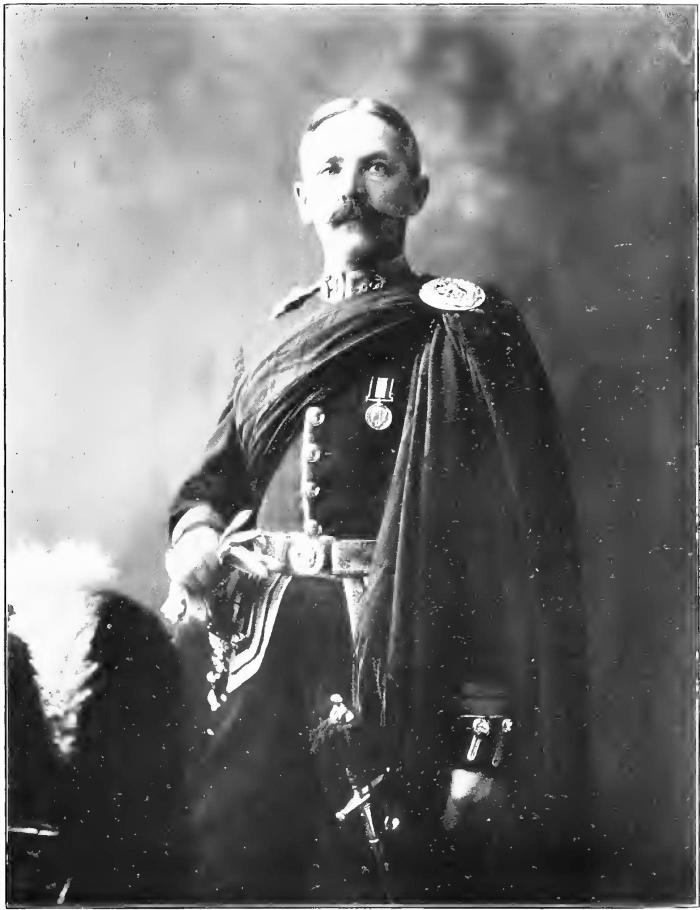
Lieutenant-Colonel W. C. Macdonald.
Commanding 48th Highlanders.
The Chaplains.—The Rev. Daniel James Macdonnell, B.D., the beloved minister of St. Andrew’s Church, Toronto, and the first Chaplain of the 48th Highlanders, was the son of the Rev. George Macdonnell, and was born at Bathurst, New Brunswick. He was minister at Peterborough, Ont., before coming to St. Andrew’s, in which he spent the remainder of his life. His patriotism and interest in military service had long been established, and in accepting the chaplaincy he brought strength to the regiment at a time when his help was most needed and opportune. He associated himself closely with the regiment, and not only when church parade necessitated his special services, but on every convenient occasion did his deep interest in the welfare of the corps show itself. His death, in February, 1896, left a blank which was not filled until the appointment in the fall of 1899 of Dr. Black.
Rev. Dr. Armstrong Black was his successor in the pastorate of St. Andrew’s, Toronto, as well as in the chaplaincy of the regiment. Dr. Black is a Scottish Border man, born at New Castleton, Liddesdale. Though but recently settled in Canada, he has entered with a true soldier’s readiness and spirit on the duties of his office, winning the esteem of officers and men, and exercising an influence which makes for a high conception of the citizen soldier’s duty.
Major Robertson.—Major Donald Murdoch Robertson, was one of the band of Scotchmen who witnessed the birth of the movement which resulted in the formation of the 48th Highlanders. When officers were selected he was appointed senior captain, provisionally, on February 19th, 1892, with confirmation on February 29th, 1892. He qualified in the Royal School of Infantry, Toronto, with 2nd class and 1st class certificates, and a first for equitation. He was posted to “A” company, and continued in that position, taking a lion’s share of regimental committee work, until his promotion to be junior major on 31st March, 1898. In June, 1900, he assumed the position of senior major on the promotion of Major Macdonald to the command of the regiment. Major Robertson is a native of Glengarry, Ont., a Scotsman of the Scots, and a devoted citizen soldier.
Major Henderson.—Major Wilbur Henderson is of Canadian birth, of Scottish parentage. He was born at the village of Brooklin, Ontario, Oct. 3rd, 1856. He was educated at Brighton Grammar School and Upper Canada College. He joined the 34th battalion as 2nd lieutenant on the 24th June, 1880, was captain in 1882, and brevet-major March 3, 1892. He was one of the first to advocate the formation of a Highland regiment in Toronto. He attended the very first meeting held in connection with the movement, and since then until now he has been indefatigable in the discharge of his duties. He joined the Forty-Eighth as captain of “H” company, holding at that time a military school certificate. He attained brevet major’s rank in the militia by service, on March 3, 1892, and takes the place of junior major of the Forty-Eighth in succession to Major Robertson.
Major Orchard.—Major William House Orchard is a native of Devizes, Wiltshire. He served during 1866 and 1867 as a private in the 2nd Batt. Wiltshire Regiment, and in 1868 and 1869 as a private in the 3rd or Prince of Wales Dragoon Guards, Imperial Army. He was for two years in the Montreal Engineers, one year as sergeant in the 16th Batt., about six years in the 4th Cavalry, Kingston, as cornet and lieutenant; and captain and brevet-major in the 16th Battalion Infantry. He joined the Forty-Eighth May 13th, 1892, retiring from combative rank in 1898, and rejoining as quarter-master and honorary major at the same time. He has devoted great attention to the shooting practice of the regiment.
The first march-out of the regiment took place on the 21st of April, 1892, from Old Upper Canada College. Lieut.-Col. Davidson was in command, and the parade mustered 250 officers and men. The regiment was formed into column of route, and headed by the pipers, marched on King, York, Wellington and Church Streets, returning to barracks by King Street. The steadiness of the marching was very gratifying, and was favorably commented upon by the officers of the other city regiments, who were spectators of the march, while the delight of the populace was expressed in enthusiastic cheering which was indulged in at various points of the route.
On the Sunday following, April 24th, the regiment paraded for the first time for church service. The day was one long to be remembered in Toronto. Public enthusiasm rose to a high pitch. The day was fine, and more than 50,000 people assembled in Queen’s Park, where the regiment paraded, and along the line of march. By the kind permission of the lieut.-colonels commanding the Queen’s Own Rifles and the Royal Grenadiers, the bands of these corps were in attendance, in addition to the pipe band under Pipe-Major Robert Ireland. The following notes made by the writer at the time are quoted in order to show the pride taken in the new regiment by the citizens and the unusual enthusiasm which their appearance in full uniform evoked.
“As the regiment wheeled round into College Avenue, which was lined on both sides with thousands of spectators, the crowd in the park closed behind them, while at all intersecting streets carriages of every description took up a stand, and it appeared as if every available vehicle in the city was being utilized by sightseers. In spite of the excitement attendant upon the occasion the regiment, which numbered over 300 officers and men, made a very creditable appearance. A large proportion of the men were much above the medium height, ‘A’ Company, especially, being composed of stalwart Scotchmen. The same can be said with almost equal justness of the other seven companies which form the battalion. When the pipers struck up the historic ‘Bha mi air banais a’m baile Ionaragha,’ the men overlooking the point conveyed in the time, lengthened step and strode proudly along, while the crowds expressed their admiration.” The service was held in St. Andrew’s church. Rev. D. J. Macdonnell, chaplain of the regiment, preached from the text, Joshua 1., 9:—“Have not I commanded thee? Be strong and of good courage; be not afraid, neither be thou dismayed, for the Lord thy God is with thee whithersoever thou goest.” The opening words of the address were: “You have come to the house of God to join for the first time as a regiment in the worship of God, to seek His blessing and to listen to His word. Your thoughts have been unavoidably occupied a good deal with the externals that belong to a church parade. Let me ask you to forget these things for a little and to open your hearts to the influences that come from the unseen, while I seek to utter the message contained in this portion of God’s word. I speak to you as one of yourselves, and desiring to be thoroughly identified with you in your work, and to be of such service to you as I may as a minister of Jesus Christ, which, I take it, is the duty of a chaplain of a regiment. What does your coming here to-day mean? It means that you acknowledge God as your God, and the God of your country. It means that you desire that His blessing may rest upon you as volunteers in whatever duty may be assigned you. It means that you believe that God cares for this land, that He has to do with the defence of Canada against whatever enemies that may threaten it, and that in serving your country you are doing the will of God.”
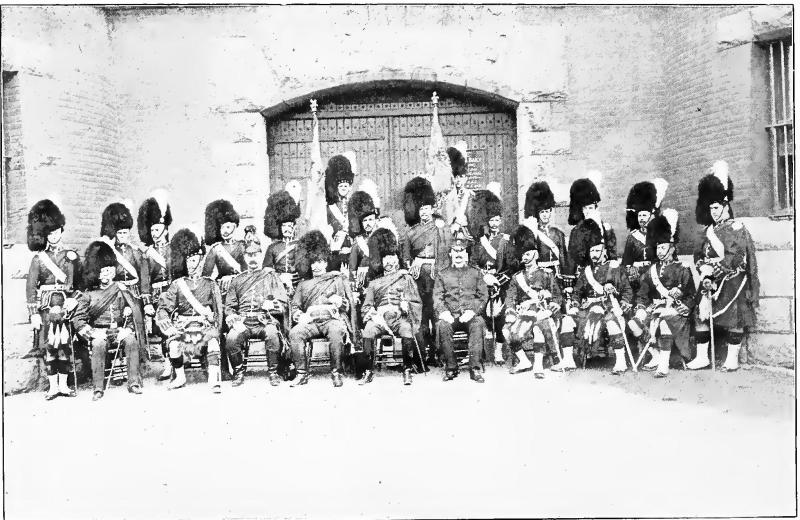
Officers of 48th Highlanders. May 24th, 1900.
Lieut.-Colonel Davidson was in command. The staff officers were Majors Cosby and Macdonald; Captain Macdougall, Acting Adjutant; Surgeons, W. T. Stuart and A. A. Dame; and Captain Walter Macdonald. The companies were under the commands of Captains D. M. Robertson, Dugald MacGillivray, John Allister Currie, J. Forbes Michie, R. S. Cassels, W. Hendrie, C. A. Hunter, Wilbur Henderson; Lieutenants D. H. MacLean, Geo. M. Rose, and Duncan Donald.
The first annual meeting of the officers was held on the 13th of May, under very bright and promising auspices. To some of the officers the experience was new, this being the first meeting of the kind they had ever attended, but to all the welfare of the regiment was supreme and the future had no looming cloud on its horizon. The committees struck and their chairman were: Rifle Committee, Major Macdonald; Band Committee, Major Cosby; Mess Committee, Captain Hendrie; Regimental Committee, Captain Robertson.
Queen’s Birthday, 1892, was an eventful day in the history of the young regiment. It has been usual on the 24th May for the Toronto regiments to make a trip to some neighbouring city or town and spend the day in a pleasant outing and military demonstration there. But the first anniversary of the Queen’s birthday since its organization was spent differently by the Forty-Eighth. They remained at home and had the honour of receiving the gift of the Queen’s and regimental colours from the ladies of Toronto, at the hands of His Excellency Lord Stanley of Preston, the Governor-General of Canada. The ceremony was most impressive, and was witnessed by a vast concourse of citizens and people from neighbouring towns who visited Toronto in order to be present on so interesting an occasion. The Thirteenth Battalion, of Hamilton, was present to take part in the proceedings. It was commanded by Lieut.-Colonel the Hon. J. M. Gibson, and the regiment paraded 427 strong,—a neighbourly act by which was commenced a friendship between these battalions which has been delightful and interesting to both.
The morning of the 24th dawned brightly and the streets were alive with people at an early hour. The Thirteenth Battalion arrived by steamer at about half-past eight o’clock, and, forming on the Esplanade, marched by King Street to Simcoe Street to meet the 48th Highlanders. Lieut.-Colonel Gibson was supported by the following officers: Major McLaren, Adjutant J. Stuart, Quarter-Master J. J. Mason, Surgeon Griffin, Assistant Surgeon Rennie, Chaplain Forneret, and the company officers. The staff officers of the Forty-Eighth in attendance were: Lieut.-Colonel Davidson, Major Cosby, Major Macdonald, Captain-Adjutants Macdougall and Macdonald, Surgeons Stuart and Dame, Quarter-Master Adams, and Chaplain the Rev. D. J. Macdonnell. Column of route was formed, and the battalion marched out. The Thirteenth received the Forty-Eighth for the first time as comrades-in-arms with the band playing a selection of Highland music, and each company of the Forty-Eighth as it passed the Thirteenth saluted the colours by coming to the shoulder. When the Highlanders had passed, the Thirteenth took up the line of march, the pipers, the buglers and the brass bandsmen playing in succession. The pipers began with the regimental march of the Black Watch,—“The Garb of Auld Gaul.” The ceremonies of the day were held on the old cricket grounds, behind the Toronto University buildings, and there an immense crowd was assembled, including, within the special enclosures, the members of the Citizens’ Committee which organized the regiment, a number of contributors to the regimental funds and many representative citizens, not only of Toronto but of the Dominion, among them being Sir David and Lady Macpherson, the Hon. Geo. A. Kirkpatrick, M.P., and Mrs. Kirkpatrick, Lieut.-Colonel Fred Denison, M.P., C.M.G., Lieut.-Colonel Grasett, Mr. Frederick Wyld, chairman of the promoters of the regiment, Mr. Thomas McCracken, treasurer, Mr. Alexander Fraser, secretary, and Mrs. Fraser, Mr. Robert Swan, Mr. Wm. Adamson, Mr. W. I. Mackenzie, Mr. David Spence, Miss Spence and Miss Beaton, Mr. D. R. Wilkie, Mr. Geo. A. Cox, Lieut.-Colonel G. T. Denison, Dr. Wylie, M.P.P., Rev. J. G. Stuart, Mrs. (Dr.) Stuart, Miss Gibson, Alderman Lindsey, Mr. Chas. Holland, Dr. Daniel Clark, James Massie, Sir Wm. P. Howland, W. D. Matthews, Mr. George MacKenzie, Wm. Campbell, Mrs. Campbell, Bard Evan MacColl, Ian MacKenzie, Hamilton.
The Governor-General’s party consisted of His Excellency, Lord Stanley of Preston, Major St. Aubyn, Lord Kilcoursie, and Captain Walsh.
The Thirteenth and the Forty-Eighth were brigaded under the command of Lieut.-Colonel Otter, D.A.G. with Major Buchan as Brigade-Major, and Captain Hendrie, of the Hamilton Field Battery, as Orderly Officer.
After the general salute, the Governor-General and Staff inspected the regiments thoroughly, making a complete round of the ranks. Then the Highlanders were formed up in three sides of a square for the ceremony of presenting the colours. The drums were piled in front of the regiment and the colour’s uncased. The colour party consisted of Lieutenants D. H. McLean and Duncan Donald, Colour-Sergeant Simpson, “C” Company, and Colour-Sergeant Alexander Rose, of “A” Company. Majors Cosby and Macdonald took post on the right and left respectively.
The ceremony was begun by the dedicatory prayer offered by Rev. D. J. Macdonnell, chaplain of the regiment. It was as follows:—“Eternal, immortal, invisible God, we worship Thy great name. Thine, O Lord, is the dominion and the power and the glory, and the victory and the majesty, for all that is in heaven and earth is Thine. Thine is the Kingdom, O Lord, and Thou art exalted high above us. Lord of the nations, we bless Thee for the goodly land which Thou hast given us, and for the blessings which have come to us as a heritage from our fathers. We bless Thee for the preservation of our gracious Sovereign the Queen to her faithful subjects this day. We commend her and them to Thy providence, beseeching Thee that the remaining years of her life may be filled with prosperity. We pray for Thy blessing on the Royal Family, and upon all who bear royal command under our Queen and over us. We commend to Thee Thy Servants the Governor-General, the Lieutenant-Governor, and all judges and magistrates throughout the land. We pray for Thy blessing upon the whole body of the people. May we learn that the true greatness and majesty of a nation is in loyalty to Thee and those in authority under Thee. Our own arm cannot save us, but Thine arm and light of Thy countenance. We would go forward to our duty in Thy strength. Trusting in Thy guidance we would be strong and of good courage. In the name of our God will we set up our banners. Grant, we beseech Thee, O God, that these colours which we dedicate to Thee to be used in the service of this land, may never be unfurled in an unrighteous cause, but ever and only in the cause of right and freedom and the weal of our country. Grant that if Thy servants are called to fight in defence of their country that they may ever do so as good soldiers of Jesus Christ, seeking to maintain consciences void of offence toward Thee and toward man. Give peace in our time, O Lord, the peace that is based upon righteousness. Hasten the time when the Prince of Peace shall reign over all the earth, when men shall be bound together in a brotherhood of all nations, and when wars shall cease unto the ends of the earth. Hear us in these our prayers.”
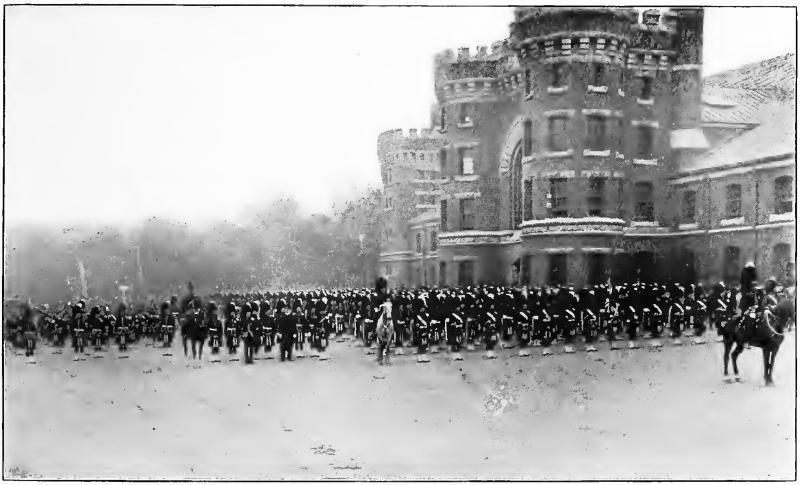
48th Highlanders on Parade at Armouries. May 24th, 1900.
Major Cosby, on behalf of the ladies of Toronto who donated the colours, placed the Queen’s colour in the Governor-General’s hands, and he in turn handed it to Lieutenant McLean. Major Macdonald handed the regimental colour to Mrs. Henry Keble Merritt, who was present as the representative of the lady donors of the colours, and she gave it to the Governor General, who handed it over to Lieutenant Donald.
The Governor-General, facing the regiment, then addressed them as follows:—“Colonel Davidson, officers, non-commissioned officers and men of the Forty-Eighth Highlanders,—It has been the custom from early times that every body of armed men should carry with them some flag, eagle, or colour, which should represent at once the authority under whom they are enrolled, and also to form a rallying point either for attack or defence. Although modern warfare has lessened the use of colours on the field, still they are not without a great value in encouraging that which is best in the spirit of the regiment. These colours, presented by the ladies of Toronto, I now commit to your charge as the representative of our Sovereign the Queen. May they remind you of the loyalty which is due to her person and her throne, a loyalty, which, I am sure, least of all will be forgotten on this day. And may they also remind you of the duty which you owe to your regiment as loyal soldiers and servants of the Crown. I trust that you may not have occasion to be called out in active defence of your hearths and homes, but should it be so, remember the inscription on these colours, the old motto of Scotland, ‘Nemo me impune lacessit,’ (‘No one attacks me with impunity’)—a motto, let me say, as fitting for a citizen soldiery as is, at home, the motto of the British volunteers, ‘Defence and not Defiance.’ But though you may not have the opportunity of displaying on active service those qualities which make a good soldier, there are often in times of peace occasions on which you can uphold the pride of your regiment and your determination to be an example to those with whom you serve and to those who come after you. Cheerful and unquestioning obedience to orders, devotion and loyalty to the Crown and the country, a determination to do your best in all circumstances, these are some, though by no means all, of the qualities which we sum up as the highest praise in the one word, soldierlike. I trust that every one of you, when he looks on these colours, will determine to uphold the honour of his regiment, and that you will at no time forget those who have been kind enough to do you honour as the ladies of Toronto have done of presenting you with these colours this day. The commencement of your regiment has shown a spirit of zeal and a power of organization which does you the highest credit, and I am sure, Colonel Davidson, that I am only paying you your due in saying that it is greatly owing to your own care, as well as that of your officers, that this fine regiment appears to-day on parade although its formation was consummated only something like six months ago. You form a body of men who, I am able to say, would bear comparison with many fine regiments in Her Majesty’s service. I trust you will always do your best to uphold the character of your regiment, to honour all officers and one another, and to be true to the colours which, in the Queen’s name, I have now the honour to present to you.”
In reply to his Excellency, Lieut.-Colonel Davidson said: “My Lord and ladies of Toronto,—The regiment which I have the honour to represent must feel highly flattered by the distinguished honour you have conferred upon them by presenting these colours. I trust we shall bear out the motto ‘Dileas Gu Brath,’ (‘Faithful For Ever,’) which we bear, towards you and Her Majesty the Queen, whom we are pleased to serve.”
At the conclusion of the ceremony the bagpipe band struck up “Highland Laddie,” for the march past, His Excellency receiving the salute. The Highlanders then formed in line and saluted the colours. A march past by the brigade, and the ceremony was at an end. The veteran officers present paid high tribute to the steadiness of the marching and the beauty of the movements of the new regiment.
In the orderly room, after the parade, a pleasant function took place, when Captain J. C. MacDougall, of the Royal School of Infantry, who from the formation of the regiment had acted as its adjutant and rendered valuable services to it, was made the recipient of a gold watch, suitably inscribed, from Lieut.-Colonel Davidson, and of a handsome gift from the officers on behalf of the regiment.
In the evening the officers of the Thirteenth and the Forty-Eighth were entertained at dinner by Lieut.-Colonel Davidson. Major Macdonald and Adjutant Macdonald presided as president and vice-president of the officers’ mess.
In the course of embarking on the steamer for Hamilton that evening, a private in the Thirteenth missed his footing and fell into the water of the bay at Yonge Street wharf. He would have been drowned but for the gallantry of Corporal Mills, of the Forty-Eighth, who, in uniform, plunged into the water and effected a difficult rescue, winning thereby the Royal Humane Society’s medal, which was presented to him on the 16th of September succeeding.
On the 15th of June, 1892, the following District Memorandum was published in orders:
“From His Excellency the Governor-General.
To Major-General Herbert, C.B., commanding the Canadian Militia:
Sir,—By direction of His Excellency the Governor-General, I have the honour to convey to you the expression of His Excellency’s approval of the arrangements made for the inspection of the 13th and 48th Battalions at Toronto on the 24th ult., which were well and ably carried out by Lieut.-Colonel Otter, D.A.G., who commanded the parade.
His Excellency is pleased to be able to state his appreciation of the appearance and bearing of all ranks of both battalions. He remarked the steadiness under arms of the Thirteenth, especially after their early start from Hamilton and their trying morning’s work.
Having regard to the short time the 48th have been enrolled, he considered there was evidence of great pains having been taken by all ranks to become efficient, and that the result was most creditable to all concerned.
(Signed) J. St. Aubyn, Major,
Military Secretary.”
On the 10th of June, 1892, Captain Walter Macdonald appears in orders as Acting Adjutant of the regiment, taking the place so well filled by Captain Macdougall from the month of October of the previous year. On the 25th of August, 1892, Captain Macdonald was gazetted Adjutant of the regiment.
On the 13th of August, “C” Company, commanded by Captain Currie, obtained permission to visit Collingwood. They were accompanied by a number of men from “G” Company, under Captain Hunter. The officers and men received a most cordial welcome from the citizens of Collingwood, who entertained them in Camp from Saturday until the following Monday.
The fall drill for 1892 opened on the 9th of September with a good attendance, and the record is one of hard, steady work by all concerned during the season. The approach of the cold weather is indicated by an order taking effect on the 14th of October, that the regiment would parade in trews instead of in kilts as previously. From the 21st to the 28th of October, the Company inspection in connection with the efficiency competition was held, and the results were very satisfactory to the regiment. On the 29th of the same month the Annual Rifle Match of the regiment took place, at which an attractive programme and excellent shooting were combined, giving a foretaste of the honours the regiment was to win in days to come.
On the 10th of November, the Thanksgiving manœuvres were arranged for, in which the 48th was assigned an important part, but the inclemency of the weather caused the sham fight to be called off.
The courtesies so generally extended to the regiment by the officers of the Toronto Garrison were acknowledged by a smoking concert and supper, given by the officers of the 48th to the garrison on the 8th of November, 1892. The invitation was accompanied by the following card:
“Wi’ this ye’ll ken ye’re speired to crack and smoke wi’ us, and eat a bit haggis on Tuesday nicht, November, 8th, at half-past eight, at the Auld Upper Canada College Buildins.
If ye canna come, dinna, bit let’s ken.”
The response was highly flattering, the senior officers of the garrison being present, including Lieut.-Colonel Otter, Lieut.-Colonel Gray, Lieut.-Colonel G. T. Denison, Lieut.-Colonel Dunn, Surgeon-Major Grasset, the commanding officers of city corps, and seventy-five other officers. Representing the civilians, Mr. Frederick Wyld, Chairman, and Mr. Alexander Fraser, Secretary of the Citizens’ Committee, were guests.
The officers’ messroom had in the meantime been handsomely fitted up, Mrs. Davidson contributing largely to the furnishing. The quarters were commodious and comfortable, and pleasant recollections will always linger around the evenings spent at the “Old Barracks” in the early days.
The closing function of 1892 was the presentation to Mr. Alexander Fraser of a copy of a book, “The Costume of the Clans,” by John Sobieski Stolberg Stuart and Charles Edward Stuart, the reputed grandsons of Prince Charles Edward Stuart. The inscription explains why the presentation was made:
“Presented to Alexander Fraser, Esq., M.A., by the Officers of the 48th Highlanders, in appreciation of his assistance in the formation of the regiment.
On behalf of the Officers,
(Signed) John I. Davidson, Lieut.-Colonel,
Commanding the 48th Highlanders.”
Toronto, Dec. 23rd, 1892.
In making the presentation, Lieut.-Colonel Davidson referred to the part taken by Mr. Fraser in the formation of the regiment. The officers, he said, had always felt they ought to acknowledge his services in some appropriate way, and they had decided it should take the form it had assumed, believing they had made a selection congenial to Mr. Fraser’s tastes as a Highland antiquarian. He hoped the gift would be cherished as a precious heirloom, and that the bond between the recipient and the regiment would not be terminated, by this acknowledgement, but strengthened and renewed.
In the course of his reply, accepting the gift, Mr. Fraser stated that when the authors of the book came to Scotland they were hospitably received by quite a number of the Scottish nobility and gentry as the descendants of the exiled Stuarts. Lord Lovat, the chief of the clan Fraser, built a mansion for them on “Eilean Aigais,” an island romantically situated on the River Glass, within sight of his (the speaker’s) father’s door. Here, amid surroundings perfectly familiar to him, the descendants of Prince Charlie compiled the work which was now, through what happy thought he knew not, presented to him.
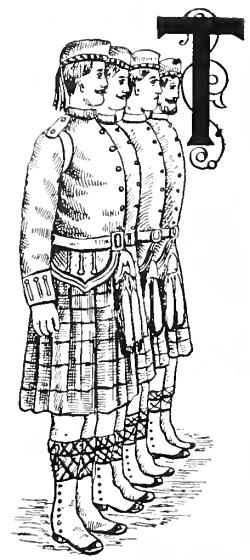
HE spring drill of 1893 was uneventful. The regiment upheld its good name for efficiency, the ranks were well recruited by a desirable class of young men, and the standard aimed at was placed at a high mark. The record gives evidence of constant drilling and of steady progress.
On the 7th of April Captain Macdonald resigned the position of Adjutant, reverting to the retired list of Captains, to the great regret of the officers and men, who appreciated his abilities and his complete devotion to duty. Major Macdonald filled his position temporarily.
On the 24th of May (Queen’s Birthday) a return visit was made to Hamilton, the Thirteenth Battalion having visited the Forty-Eighth at Toronto on the occasion of the presentation of colours on the Queen’s Birthday of the previous year. The regiment entrained at 8 a.m. and reached Hamilton early in the forenoon, under command of Lieut.-Colonel Davidson, with a full complement of officers. The day was an ideal one for an outing, and on the arrival of the Highlanders at 10.40 a.m. thousands of citizens were at the railway station to give them a “Highland” welcome. The Thirteenth Battalion escorted the visitors to the Drill Hall, where, after a brief rest, preparation for a street parade to Dundurn Park began. The parade started about half-past eleven and reached the park after less than half-an-hour’s march. The “feu-de-joie” was fired, and luncheon was then served to the men on the grounds. The Thirteenth and Forty-Eighth formed a brigade under Lieut.-Colonel Gibson, and marched past the saluting point amid the cheers of the assembled crowd. The trooping of the colours followed; also physical drill and bayonet exercise. When the military part of the proceedings were over, some members of the Forty-Eighth gave exhibitions of the Highland dances, which aroused the enthusiasm of the spectators to a high pitch. The citizens entered heartily into the spirit of the occasion, and entertained officers and men and other visitors most hospitably. Among those noticeable upon the grounds enjoying the sights was the venerable Sheriff Archibald MacKellar, the veteran Highlander, dressed in tartan, trews and vest and wearing a cockaded Glengarry bonnet. Officers and members of the Gaelic Society of Hamilton, and other Scottish societies of the city, also acted as hosts, keeping open house for the day. A band concert and fireworks were held in the evening, after which, at 11 o’clock, the regiment paraded to the railway depot for their home journey.
In the Regimental Orders of the 26th May, 1893, the Commanding Officer thus acknowledges the good work of the Regiment during this season:—
“The Officer Commanding the Regiment desires to express to the officers, non-commissioned officers and men of the Battalion his appreciation of their strict attention to duty, regularity in attendance at parade, and of the general interest manifested by all ranks in the welfare of the Regiment during the past season’s drill, and furthermore, wishes to acknowledge the general good conduct and esprit de corps of the Battalion during the trip to Hamilton on the Queen’s Birthday.”
At the annual meeting of the officers this year the thanks of the Regiment were placed on record to Mrs. Henry Keble Merritt and the ladies of Toronto for presenting the colours to the Regiment. Thanks were also tendered to D. Ritchie & Co., for the “Old Chum Tobacco” shooting trophy presented to the Regiment. These were the standing committees for the year: Regimental, Captain Robertson, chairman, Captains MacGillivray and Michie. Rifle Committee, Major Macdonald, chairman, Major Wilbur Henderson, and Lieutenant J. F. Ramsay. Band Committee, Major Cosby, chairman, Captains Cassels and Currie. Mess Committee, Captain Hendrie, chairman, Lieutenant D. H. McLean and Asst.-Surgeon Dame.
At a meeting held on the 29th June it was agreed to hold Scotch games, under the auspices of the Regiment, on the 19th August following, the general management of which would be undertaken by Chief Mackinnon, Hamilton. The event passed off successfully. The conditions were favourable and the crowd of spectators was very large. From a distance there came: Major R. R. MacLennan, M.P., Cornwall; Captain A. F. Milliken, Cornwall; G. M. Rose, Berlin; Kenneth Robertson, Montreal; Lieut.-Colonel Campbell, Milton; Kenneth Chisholm, ex-M.P., Brampton; J. Murchison, Lucknow; Lieutenant Weir, 37th Batt., Haldimand; Lieutenant Duncan, Hamilton Field Battery; Mr. William Hendrie, sr., Hamilton; Mr. A. G. Graham, Chicago; Mr. J. Ball Dow, Whitby; J. Cameron, Woodbridge; Wm. Campbell and A. Torrance, Markham; Captain Tidswell, 13th Batt., Hamilton; A. D. Braithwaite, Hamilton; Dr. Jackson, New York; Chief Garlow, Burlington; Sergt.-Major Williams, 36th Batt., Staff-Sergt. Mills, 13th Batt., Ian Mackenzie, Hamilton. Among the Toronto citizens were: Lieut.-Governor and Mrs. Kirkpatrick, Lieut.-Colonel and Mrs. Davidson, Lieut.-Colonel and Mrs. Hamilton, Major and Mrs. Cosby, Major and Mrs. W. Campbell Macdonald, Mr. and Mrs. Frederick Wyld, Mr. and Mrs. W. S. Lee, Miss Lee, Mrs. and Miss Beatty, Mrs. R. Myles, Mrs. and the Misses Taylor, Captain J. C. MacDougall, Captain Kirkpatrick, Surgeon Fred W. Strange, Hon. Mr. Justice Ferguson, Lieut. Colonel and Mrs. G. T. Denison, Mr. and Mrs. MacLean Howard, and Mr. and Mrs. MacLean, of Pennycross, Mull, Scotland, who were visiting Canada at the time.
During the afternoon the brass band of the Regiment under Bandmaster Griffin furnished a programme of music.
The programme of games was excellently composed. The numbers included athletic events, and contests for bag-pipe music, dancing, military events, and tug-of-war, and was divided into two parts, the first part being for professionals and the second part for amateurs. The professionals included some of the best athletes on the continent, and their performance was of a high order. The tug-of-war was between a team of the Royal Grenadiers and the Highlanders (who pulled in kilts), and, after an exciting contest, the Highlanders won.
In the evening the Gaelic Society of Toronto evinced its interest in the day’s proceedings by entertaining a large number of the visitors to a Highland entertainment in Victoria Hall, where songs, dances, and music were indulged in and on adjournment a number of the judges and prize winners of the day was entertained to supper at Webb’s restaurant. Mr. John Cattanach MacMillan, president of the society, occupied the chair, and Mr. Alexander Fraser, 1st vice-president, acted as croupier. A patriotic and appropriate toast list was honoured in true Highland style.
In the regimental orders of the 13th September, 1893, Captain Dugald MacGillivray is appointed to be Acting Adjutant, Captain Duncan Donald taking over the command of “B” Company, and on the 22nd of the same month authority is given for the wearing of white shell jackets by sergeants.
On the 6th of October the strength of the various bands was: Brass Band, Bandmaster Griffin and 32 bandsmen; Bugle Band, Bugle-Major Robertson and 22 buglers; Pipe Band, Pipe-Major Robert Ireland and 11 pipers.
The battalion cross guns and crown, for the five highest scores in rifle practice during the season, were won by Staff Sergeant Wm. Harp by a score of 320 points.
On the 13th of October Captain MacGillivray was gazetted Adjutant of the regiment, and Captain Donald was confirmed in command of “B” Company.
On Thursday, the 23rd of November, the Thanksgiving Day manœuvres took place, and the Forty-Eighth was brigaded with the Thirteenth and the Royal Grenadiers, forming the attacking force in the sham fight at Lambton Mills.
Based on the percentage of drills performed during 1893 and average attendances, the order of merit of the several companies was as follows:
| “H” Co.—88 | per cent.; | average, | 38-2/3—Capt. and Bt.-Major Henderson. |
| “D” Co.—70 | ” | ” | 33-1/2—Capt. Michie. |
| “A” Co.—76 | ” | ” | 30-1/3—Capt. Robertson. |
| “B” Co.—64 | ” | ” | 33-1/3—Capt. Donald. |
| “C” Co.—70 | ” | ” | 26-1/2—Capt. Currie. |
| “F” Co.—74 | ” | ” | 25-2/3—Capt. Hendrie. |
| “E” Co.—73 | ” | ” | 25-1/2—Capt. Cassels. |
| “G” Co.—64 | ” | ” | 26-1/5—Capt. Hunter. |
It is interesting to note the good standing of the various companies in the return of comparative efficiency, 1893:
| “A” Co. (Capt. Robertson) | 91 | |
| “B” Co. (Capt. Donald) | 80 | |
| “C” Co. (Capt. Currie) | 89 | |
| “D” Co. (Capt. Michie) | 86 | |
| “E” Co. (Capt. Cassels) | 85 | ¼ |
| “F” Co. (Capt. Hendrie) | 81 | ¾ |
| “G” Co. (Capt. Hunter) | 92 | |
| “H” Co. (Capt. and Bt.-Major Henderson) | 116 |
At the annual meeting for 1894, held on the 29th of January, the review of the work for the previous year was most gratifying. Substantial progress had been made in every department of the regiment and the prospects were bright. The following standing committee were elected for 1894. Regimental Committee, Captains Robertson and Macgillivray and Lieutenant Orchard; Band Committee, Major Cosby and Captains Michie and Hunter; Rifle Committee, Major Macdonald, Capt. and Bt.-Major Henderson, and Lieutenant Ramsay; Mess Committee, Captain Hendrie, Dr. Dame and Lieutenant Mitchell.
Spring drill was taken up on March 30th, but hard work had been done with recruits long before that date, in consequence, of which the regiment made a good showing from the first parade. The strength of the battalion was found to be increased, and the regiment settled down to the routine of drill, determined to do well on inspection day. White shell jackets were worn for the first time on the 20th of April, 1894, by the company sergeants, the bugle sergeant and pioneer sergeant, in drill order. On the 27th of April, Lieutenant Orchard assumed command of “E” company, vice Captain Cassels retired.
A call having been made upon the Toronto regiments for assistance to the “Volunteer Monument Fund,”—for defraying the cost of the monument erected in Queen’s Park to the memory of the volunteers who fell in the North-West rebellion—the Forty-Eighth donated the collection made at Divine Service on the 3rd of May, for that purpose.
The regiment was by this time so well-established that Scotchmen and the people generally in outlying towns were very desirous to have a visit from it on the Queen’s Birthday holidays. This year many invitations had been received, and that from Woodstock, the centre of Oxford County, was accepted. The regiment paraded at 7.15 a.m. on the 24th of May, entrained at the Union Station and proceeded to Woodstock, where they were welcomed with the greatest enthusiasm by the military corps and by the citizens. Proceeding to the park, manœuvres were gone through, the colour trooped, and afterwards various games were enjoyed. The Pipe Band was the recipient of much praise from the people, many of them of Highland descent, with the love for the music and traditions of the Highlands strong in them. A thoroughly enjoyable day was spent, every form of entertainment being suitable to the occasion, and the trip will be long green in the memory of the officers and men who participated in it. The conduct of the men, as always, was above reproach.
At the conclusion of the spring drill season Lieut.-Col. Davidson issued this order: “The officer commanding desires to express his high appreciation of the faithful work done throughout by all ranks. He, also, refers, with much satisfaction to the parade on the 24th May, and the excellent conduct of the members of the regiment on that occasion.”
Mr. Charles Allen Hugh Maclean’s appointment as lieutenant dates from the 18th of May this year. His connection with the regiment being somewhat exceptional, it may be briefly referred to. His father, Maclean of Pennycross, one of the oldest cadet houses of the Clan Maclean, visited Canada in 1893, and was much impressed with the excellent organization and efficiency of the 48th Highlanders. The military traditions of his family coincided with a military career for his son, and he decided that his preliminary training for the British Army should be through the Forty-Eighth and the Canadian military schools. Accordingly, Mr. Charles Maclean came to Canada, and joined the Forty-Eighth on November 3rd, 1893, as second lieutenant provisionally. On February 20th, 1894, his rank was confirmed, on a 1st Class R.S.I, certificate. He proceeded to the Royal Military College, Kingston, and took a brilliant course, qualifying for a commission in the British Army, and received an appointment to the 2nd battalion of the Argyle and Sutherland Highlanders, which regiment he joined in India.
The Annual Scottish Games, under the auspices of the regiment, were held on the Rosedale grounds on the 15th September, 1894. The weather was unsettled, and the cloudy sky of the forenoon was uninviting. Consequently the number of spectators was considerably less than that of the previous year. But the programme was quite as interesting and enjoyable. Many prominent Scotchmen from places outside of Toronto were present, as on the previous occasion, and from the city there was a fair representation. Major Macdonald was director of the proceedings, and was assisted in the Highland events—dress, dancing and bagpipe competitions—by Mr. Alexander Fraser, Toronto. A feature was a piobaireachd competition, in which written essays on that music were handed in by the competitors, the prizes for which were donated by the Gaelic Society of Toronto. While the financial success was not such as to encourage a continuance of Highland sports by the regiment—largely because of the weather—every one present could but feel that excellent sport had been provided, and that the regiment did itself credit by the excellent manner in which all the arrangements were carried out. Major Macdonald, Captains Robertson, Hendrie and Michie were specially instrumental in carrying through the arrangements for the day to a successful close.
The fall drill began early—on the 31st of August—and continued without interruption to the close of the season, on the 22nd of November.
An interesting ceremony which intervened was the unveiling of the statue of Sir John A. Macdonald on the 13th of October, at which a voluntary parade from the Forty-Eighth was permitted. A guard of honour was furnished, consisting of 100 officers and men, with the Band. Capt. and Bt.-Major Henderson was in command, with Lieut. C. A. H. Maclean and 2nd Lieut. Campbell and 2nd Lieut. Rainsbath (regimental colour).
Capt. Hunter resigned his company on the 2nd November, 1894, and was succeeded in command by Lieut. J. F. Ramsay.
That year a beautiful shooting trophy was presented to the regiment by the Caledonian Society of Toronto, in the form of a Border Tup’s head, heavily mounted in silver, with snuff mull on top. The presentation was made by a deputation consisting of Mr. William Simpson, president; Capt. Robertson, vice-president: Robert Barron, George Vair, Wm. Campbell and Alexander Fraser, members of the committee.
With the fall of 1894 the three year term for which non-commissioned officers and men had enlisted in 1891 came to an end, and it must have been gratifying to the officers and friends of the regiment that few of the original members,—the veterans, then retired. A “long service” badge was promised to those who would re-enlist in the service of the regiment, and at the opening of the season of 1895 the number of those who won the badge was large. Physical drill bulked largely in the duties of the regiment during the spring of 1895, and the routine work was uneventful but highly satisfactory.
The standing committees for the year 1895, were:—Regimental: Major Macdonald, Captain Michie, and Lieut. Scott; Mess: Captain Donald, Dr. Dame, and Lieutenant H. C. MacLean; Rifle: Major Macdonald, Major Henderson, and Lieutenant Mitchell; Band Committee, Major Cosby, Capt. Robertson, and Lieut. Hamilton. Captain Orchard was appointed Musketry Instructor for the year.
Quarters having been assigned to the regiment in the new Armories, the old Upper Canada College buildings were abandoned. Steps were taken to furnish the officers’ and the sergeants’ mess in the Armories, where since 1895 the regiment has had its home, and where many pleasant gatherings of friends of the regiment have been held.
The Queen’s birthday. 1895, was spent at Windsor, Ont. The invitation had been most cordial, and although the journey was long and the visit extended, the parade was a large one. This trip is probably the most notable made by the regiment on a Queen s birthday outing. The journey was begun at nine o’clock p.m., on the 23rd of May, by train from the Union Station. Early next day the regiment detrained at Windsor, marched from the railway to the camping ground, outside the city boundary, and camp was at once formed. It took but a short time to get the tents pitched and to serve breakfast. The daily routine of this camp was: 6 a.m., Reveille; 6.30 a.m., Guard Mounting; 8 a.m., Breakfast; 8.40 a.m., Sick Parade; 9 a.m., Orderly Room; 10 a.m., Forenoon Parade; 12.30 p.m., Dinner; 1.45 p.m., Afternoon Parade; 5 p.m., Tea; 6.30 p.m., Guard Mounting; 7.30 p.m. Retreat; 10.30 p.m., Tattoo, First Post; 11 p.m., Last Post; 11.15 p.m., Lights Out. The commanding officer impressed upon all ranks the necessity for the maintenance of discipline and good behaviour, and the importance of upholding the reputation of the regiment on and off parade. His wishes were most thoroughly respected; and it is stated to be the fact that there was no reported absence from camp without leave, nor was there an instance of any breach of discipline. Camped as the regiment was on the border of the United States, with the attractions of the city of Detroit so near, there was some apprehension as to a mishap, but none occurred. The men freely crossed the river to the American side, and they were most kindly received by the citizens there. The St. Andrew’s Society of Detroit not only sent a deputation to Camp, to welcome the regiment, but kept their rooms and hall open all day long for the use of any Highlander who might choose to “drop in” for rest or refreshment, and in the evenings Scottish entertainments were improvised for the benefit of the visitors. The officers were feted by clubs, societies and by individuals, and on every side the hospitalities were unbounded. The camp continued on Friday, Saturday, and Sunday, the regiment arriving home on Monday morning. On Friday afternoon a review was held in which regiments from neighbouring counties took part.
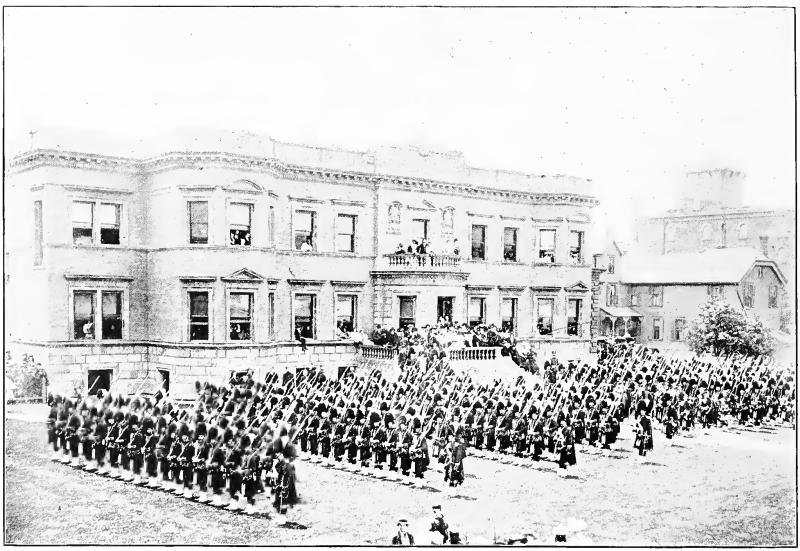
48th Highlanders at Walkerville, Ontario, 1895.
The concourse of people who witnessed the manœuvres was vast. Thousands crossed from Detroit, and special trains ran from London and Chatham. People travelled from points as far away as Kincardine, Lucknow, Stratford, and St. Thomas, and from Scotch centres in the State of Michigan. It was a gala day, and the evening was given over to public rejoicing. On Saturday the regiment visited Walkerville, on the invitation of Mr. Hiram Walker, whose works and warehouses were inspected. A photograph of the regiment was taken on the lawn in front of the Company’s offices. The officers and men were entertained at luncheon, and the officers and a number of friends had a sail on the river in Mr. Walker’s steam yacht. On Sunday there was a parade for Divine Service, and in the evening camp was struck and the regiment entrained for Toronto, concluding a trip, the pleasures of which have been seldom equalled in connection with regimental holiday outings.
As an instance of the interest taken in the regiment, an incident may be related. An old man from a city in Michigan was observed to follow the movements of the men with the keenest attention keeping always well to the front. When an opportunity presented itself he said to one of the staff-sergeants: “I have not seen Highland soldiers for many a long year, and I have come far to see your regiment. The sight of the kilts, the sweet sound of the pipes and the sleeping memories which they have awakened, have brought the tears I could not restrain from my eyes to-day.” Different, but equally characteristic, was an incident of the Woodstock outing of the year before. An aged piper, who wore a humane society’s medal on his breast for bravery, was much in demand for bagpipe music, outside the lines. The saying “Probair’ an aona phort” is a familiar one: here was a veritable instance. Taking a breathing spell in a quiet corner, he was espied by a few cronies who insisted that he should play to them another tune. “I’ll do nothing of the kind; do you think that I can endure to play all day long?” emphatically declared the son of Tubal. “Just another tune, only one more,” pleaded the Zorra boy in a coaxing tone suggestive of the mellifluent Gaelic. “Well, well, then, you must have your way,” said the vanquished piper, who, shouldering his pipes, played “A man’s a man for a’ that,” with great vigour. “O well,” said the man from Zorra, speaking half apologetically to a non-com. who was standing by, “he is not what you would call a bad piper, now; but he has only that one tune whatever.” But the piper played with a piper’s pride, unconscious of the sly criticism.
The regimental orders issued after the Windsor Camp contain the following paragraph: “The officer commanding the regiment cannot allow this occasion to pass without expressing in the most unqualified terms his appreciation of the conduct of the members of the regiment during the Windsor Camp period. The discipline and esprit de corps exhibited by all ranks merits the highest commendation.”
On the 30th of May, the 48th were called upon to furnish the guard of honour to His Excellency the Earl of Aberdeen, Governor-General of Canada, on the occasion of the laying of the foundation stone of the Foresters’ Temple, Toronto, erected by the Independent Order of Foresters.
Piper MacSwayed succeeded Mr. Robert Ireland as Pipe-Major of the regiment.
Fall drill commenced on the 30th of August. The recruit classes were well attended and the drill for the season elicited the commendation of the Inspecting Officers. Towards the end of the season the commanding officer authorized the wearing of a Long Service Badge by all non commissioned officers and men (Staff Sergeants excepted) whose term of service had expired, and who had engaged for a further term. The badge was of the following device: The Scottish Lion Rampant, encircled by a tressure in red on a shield of yellow 1-3/8 inches broad; to be worn on the right arm, below the elbow, and immediately above the good attendance badges.
The regimental best shot, winning the Gold Cross Guns and Crown this year, was Lance Corporal H. Kerr, “C” Co.
The year 1896 was begun by the appointment of the following Standing Committees:—Regimental: Major Macdonald, Captain Michie and Lieutenant Scott; Band: Major Cosby, Captain Robertson and Captain Hendrie; Rifle: Major Macdonald, Captain Orchard, and Lieutenant Mitchell; Mess: Captain Donald, Lieutenant Hamilton and Lieutenant Cosby. At the annual meeting of the officers, Colonel Davidson suggested that shell jackets should be obtained for the regiment; also, that an entertainment be given to those who had patronized the regiment by subscribing to the funds. A committee composed of Major Cosby, Captain Robertson and Captain Michie, was appointed to raise funds for the shell jackets, with power, if successful, to purchase them. The committee succeeded beyond their expectations, many of the ladies of Toronto being among the subscribers, and the shell jackets were thus purchased soon after, and the regiment paraded in them on the 8th of May following.
On the 27th of February, 1896, this tribute is met in Orders: “It is with regret that the Commanding Officer draws attention to the loss the regiment has sustained by the death of the Chaplain, the Rev. D. J. Macdonnell, who has been enthusiastically identified with the regiment from its inception.”
For the second time since its inception the regiment spent the Queen’s birthday at Hamilton, the guests of the Thirteenth Battalion. The regiment paraded nearly 450 strong on Saturday evening, the 23rd of May, 1896, and proceeded by train to Hamilton, where, on arrival, they took up quarters in Dundurn Park. They were quietly, but cordially received by the officers of the Thirteenth and a few representative citizens. Camp was continued over Sunday and Monday. On Sunday a church parade took place, the Thirteenth, the Hamilton Field Battery, and the Forty-Eighth taking part. The brigade was commanded by Lieut.-Colonel Gibson, the senior officer present, and numbered about 877 officers and men. Thereafter, the day was quietly spent, and the rest was greatly enjoyed. On Monday a great field day was held at the grounds of the Jockey Club, the feature being a sham battle. The Seventh Fusiliers, of London, the Thirteenth, the Thirty-Eighth, Brantford, the Forty-Eighth, Toronto, and the Hamilton Field Battery took part. The opposing brigades were: the attacking force, under Lieut.-Colonel Moore, consisting of the Seventh Fusiliers under Major Beattie, the Thirteenth under Major McLaren, and two guns of the Field Battery under Lieutenant Alexander Duncan: and the defence, under Lieut.-Colonel Davidson, consisting, of the Forty-Eighth, Thirty-Eighth, and two guns from the Field Battery, commanded by Major Hendrie. The movements were well executed, and the forces carried out the programme, which had been arranged in advance, with great accuracy. After the sham fight, the Forty-Eighth trooped the colours, winning the applause of the spectators. The evening was given over to a combined band concert at Dundurn Park, but before its completion the rain began to fall in torrents and the concert had to be stopped. This second visit was much enjoyed by the officers and men, and the good-will and friendship existing between the Forty-Eighth and the Thirteenth ever since the formation of the former was deepened and strengthened.
With the Queen’s Own Rifles and the Royal Grenadiers, the Forty-Eighth paraded on Saturday, June 27th, for the unveiling of the monument to the North-West volunteers, in Queen’s Park, Toronto, and the turnout was large.
Out of a total possible of 150 marks in the comparative efficiency of the companies, on June 1st, 1896, the regimental average was 99.84, the highest being 110.10, made by “B” Company.
On the 28th of August, 1896, Captain Dugald MacGillivray was gazetted Paymaster, with honorary rank of Captain, and was succeeded in the Adjutancy by Captain Duncan Donald, whose place was filled by Lieutenant H. C. MacLean, promoted to be Captain.
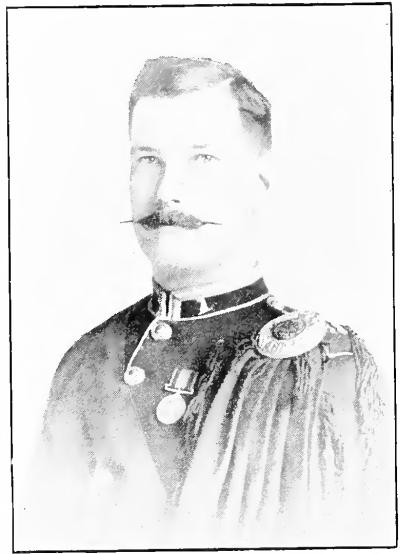
Alfred G. Robertson.
First Sergt.-Major of the Regiment.
Orderly-Sergeant Alexander Rose was promoted on September 25th, 1896, to be Sergeant-Major in the place of Alfred G. Robertson, who had occupied that position since the organization of the battalion.
In the marching and firing competitions on the 10th of October, 1896, the Forty-Eighth won the Gascoigne cup, with a score of 93 out of a possible 160 points, the next in order of merit being the Royal Grenadiers, with 85 points. This success, in a hard competition, in which eight veteran regimental teams were engaged, brought distinguished honour to the young regiment. Interest in the rifle practice rose to a high pitch this fall, and as one result a beautifully-mounted dirk was presented as a trophy by John Wanless & Son; the conditions of contesting for it was left to the commanding officer, who decided that the dirk should be regimental property, and granted the privilege of wearing it, in lieu of that usually worn, to the officer commanding the company obtaining the first place in the Regiment at the Annual Inspection.
The regimental drill was concluded on the 26th of November, Thanksgiving Day, by a practice in field manœuvres.
The Standing Committee for 1897 were:—Regimental: Major Macdonald, Captain Michie, and 2nd Lieutenant Harbottle; Band Committee: Major Cosby, Captains Robertson and Hendrie; Rifle Committee: Major Macdonald, Lieutenant Mitchell, and 2nd Lieutenant McDougall; Mess Committee, Captain Donald, Lieutenant Brooke, and 2nd Lieutenants Burnside and Cosby.
In the spring of this year (1897) the Regiment was equipped with Lee-Enfield rifles, and that arm was used in the rifle practice for the season.
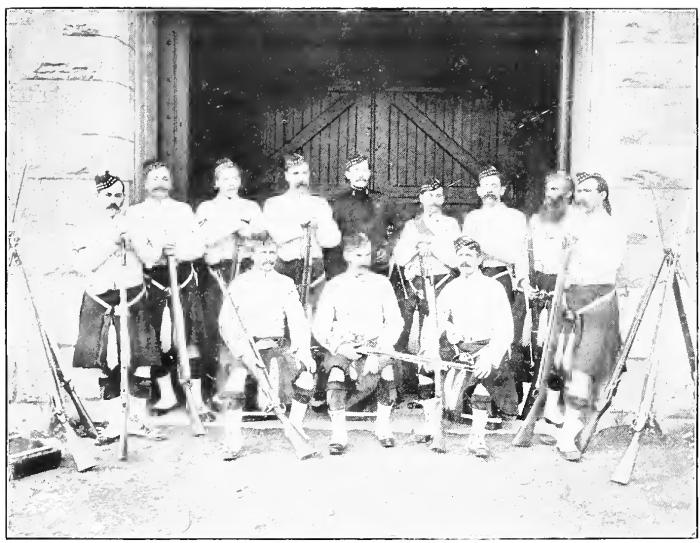
Winners of the Gascoigne Challenge Cup, for Marching and Firing, 1896.
An invitation from the Thirty-Eighth Batt., backed up enthusiastically by the citizens to spend Queen’s Birthday at Brantford was accepted. The regiment paraded on Saturday evening, the 22nd, at eight o’clock, and took train to Brantford, and camp continued until the evening of the Monday following. On arrival at Brantford, officers of the Thirty-Eighth were in attendance to extend a welcome and to escort the regiment to the camp prepared before-hand by Captain H. C. MacLean and his advance contingent.
An event which will go down in the annals of the Forty-Eighth Highlanders is the victory of the regimental team at the Islington Royal Military Tournament. The tournament, which is a military function of the highest importance, took place in June, 1897, and a team from the Forty-Eighth decided to cross the ocean to take part. It was a bold venture, but Sergt. Williams and his men felt confident that they would win honour for the Regiment. Great public interest was aroused by the event. The citizens of Toronto, the City Council, and the Ontario Government subscribed handsomely to the fund required to cover the expenses of the trip. The ten members of the team were: Sergt.-Instructor Williams, “H” Co., in command, Pte. Rankin and Pte. McCheyne, “A” Co., Pte. Campbell and Pte. Rae, “E” Co., Pte. Wallbridge and Pte. DeLisle, “G” Co., Pte. Stewart, Pte. J. McLean and Pte. Wasson, “H” Co. The team was accompanied by Major Wilbur Henderson, “H” Co. The contests were with bayonets, and though the Highlanders were in excellent form, few Canadians expected the victory would have been so complete and glorious. The Highlanders won in three contests.
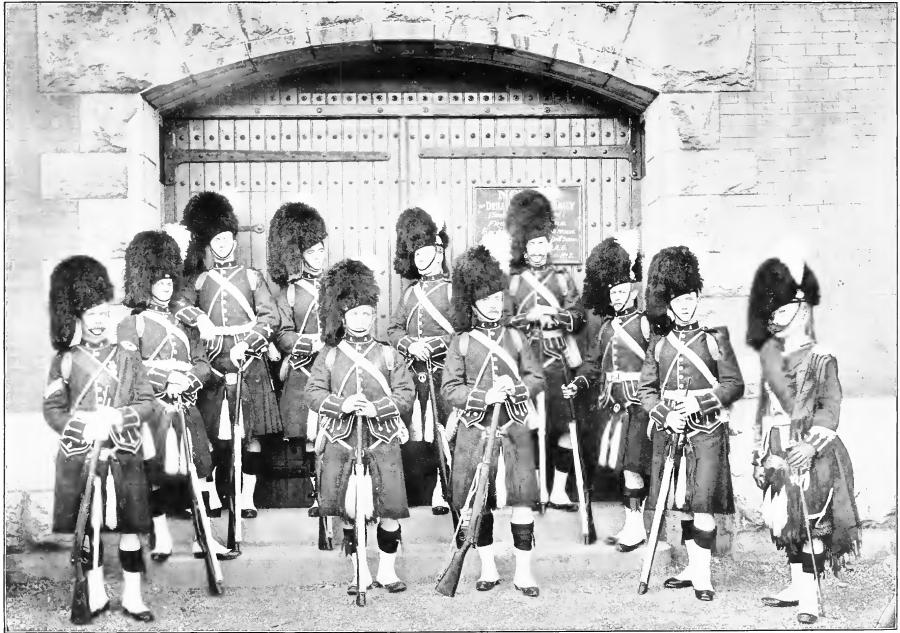
The 48th Highlanders’ Team at the Islington Tournament.
Winners of the Bayonet Championship of the British Forces, 1897.
First event:—The Colonial Individual Competition. Here four men were put against four men, and the Forty-Eighth men engaged were Williams, Wasson, McLean and Stewart. Their opponents were Australian volunteers, who had a number of teams represented. They were all beaten by the Forty-Eighth men, the result being: Stewart won first prize, Wasson 2nd, Williams defaulting to Stewart (his pupil) in the third round. The winner in the Colonial event had to fight off against the winner in the Regulars and in the Volunteers for the Championship of the Empire.
Second event:—The Regulars and the London Volunteers fought individually, and their first prize men had to fight with the Colonial’s first prize in the first contest. The first prize man of the Regulars was Col.-Sergt. Daniels, West Yorkshire Regiment, and of the London Volunteers, Pte. Hobbins, 12th Middlesex. With them Stewart had to fight. They drew for places and Stewart got the bye, leaving the first bout for the championship to be between Daniels and Hobbins. But Hobbins defaulted and Daniels and Stewart fought, Stewart winning the championship.
Third event:—A special match contest between (1) mixed teams from the London Regulars Brigaded Guards—1st and 2nd Life Guards, Grenadier Guards, Coldstream Guards and Scots Guards; (2) mixed teams from the different London Volunteer Corps; (3) and the 48th Highlanders’ team. The London Volunteer Corps team and that of the Brigaded Guards fought first. Corporal Fencing-Instructor E. Elliott was in charge of the Regulars and Pte. Hobbins of the Volunteers. The Regulars won by 5 to 4 points. The Regulars then fought the 48th Highlanders’ team, which was led by Sergt.-Instructor Williams, and the 48th Highlanders defeated the Regulars by a score of 5 to 4 points, securing a hard won victory.
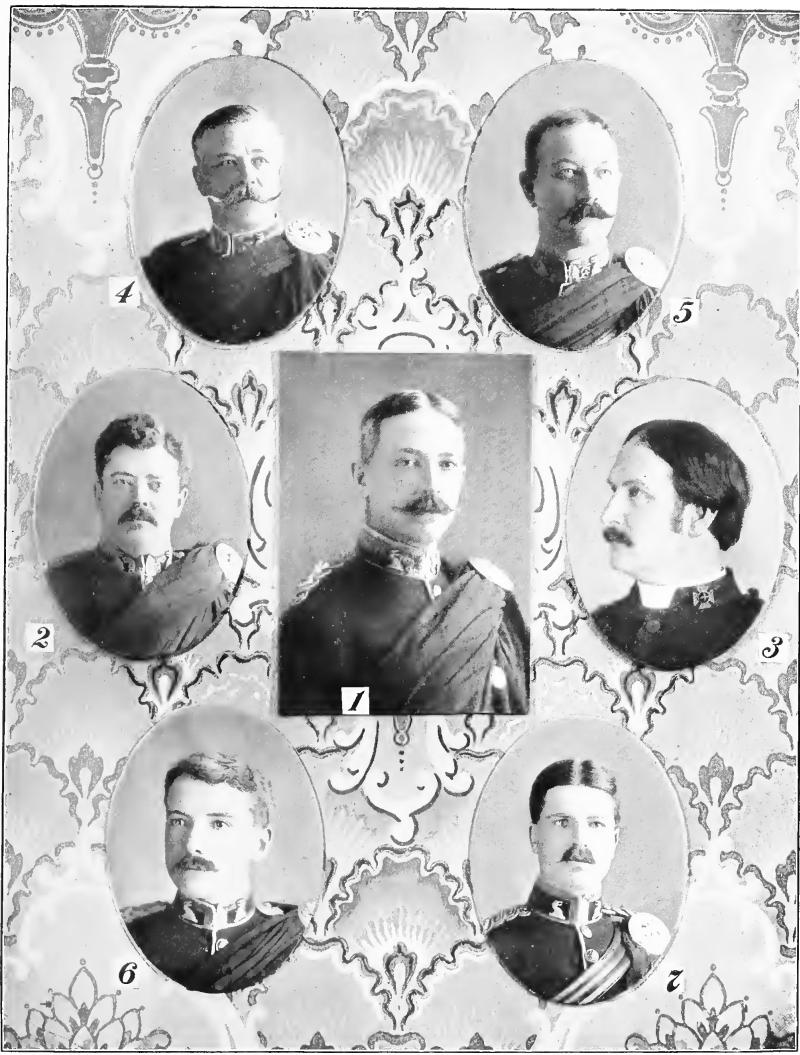
FIELD AND STAFF OFFICERS OF THE 48th HIGHLANDERS.
1. Lieut.-Colonel W. C. Macdonald, Commanding.
2. Major D. M. Robertson.
3. Rev. Armstrong Black, D.D., Chaplain.
4. Hon. Major W. H. Orchard, Quartermaster.
5. Surgeon-Major William T. Stuart, M.D.
6. Captain Duncan Donald, Adjutant.
7. Surgeon-Lieutenant D. King Smith, M.D.
Photographs by Mr. Lyonde.
Thus private George Stewart won the Championship, and Privates Rankin and Wasson also did brilliant work, while Sergt. Williams discharged his duty most creditably. Throughout military circles in Great Britain the success of the Canadian team was hailed as a sign of the growing importance of the premier colony, and coming as it did, almost at the same time as the Queen’s Jubilee celebration in London, in which the Canadian contingent took a distinguished part, it obtained considerable public attention. Canada was proud of her Highland soldiers. In Toronto the news of Stewart’s splendid victory was extremely well received. A Citizen’s Reception Committee was formed, and on the arrival home of the team it was met on the train some distance from the city by a deputation of citizens and escorted in triumph to Toronto. A military and civic parade was formed, and, amid the deafening cheers of thousands, a procession took place to the Queen’s Park where purses of gold, gold medals, and copies of an illuminated address of welcome were presented to the members of the team. To this reception men and women travelled from Hamilton and other places near the city, and some of these visitors, the members of the Citizens’ Committee and others were entertained at the Forty-Eighth Officers’ Mess after the proceedings had been concluded. Among those who had the honour of being invited were: His Honour the Lieutenant-Governor of Ontario, the Mayor of Toronto, the members of the City Council, the contributors to the team fund, the officers of Stanley Barracks, R.C.D. and R.R.C.I., officers of the city corps, members of the Citizens’ Committee, Lieut.-Colonel R. R. MacLennan, M.P. Lieut.-Colonel Moore, and a number of officers from Hamilton, accompanied by the famous band of the Thirteenth Batt., joined in the welcome.
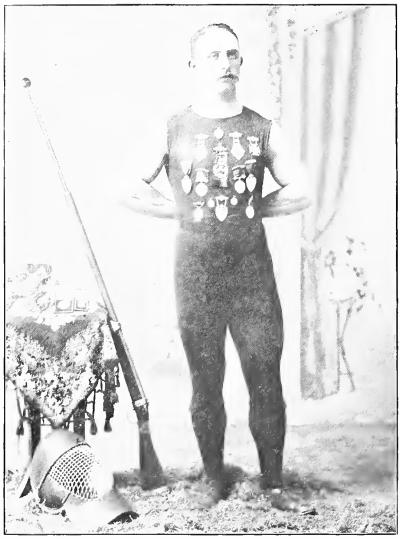
Private Geo. Stewart.
Winner of the Individual Bayonet Championship of the British Empire, 1897.
On the 22nd of June, 1897, Canada, in common with other parts of Her Majesty’s dominions, expressed its joy on the occasion of the Queen’s Diamond Jubilee. Toronto did nobly; and a feature of the day’s celebration was a grand military display. The Forty-Eighth bore a conspicuous part in the proceedings,—the street parade and in the movements at the Exhibition Grounds.
The regimental entertainment took place on October 22nd, 1897, when an immense success was attained.
In the marching and firing competition this Fall (1897) the second team of the Forty-Eighth took second place with only four points below the winning team, and with a better score than last year when they won first place.
The annual field manœuvres took place on Thanksgiving Day, the 25th of November, and in the work of the day the Forty-Eighth did their part extremely well.
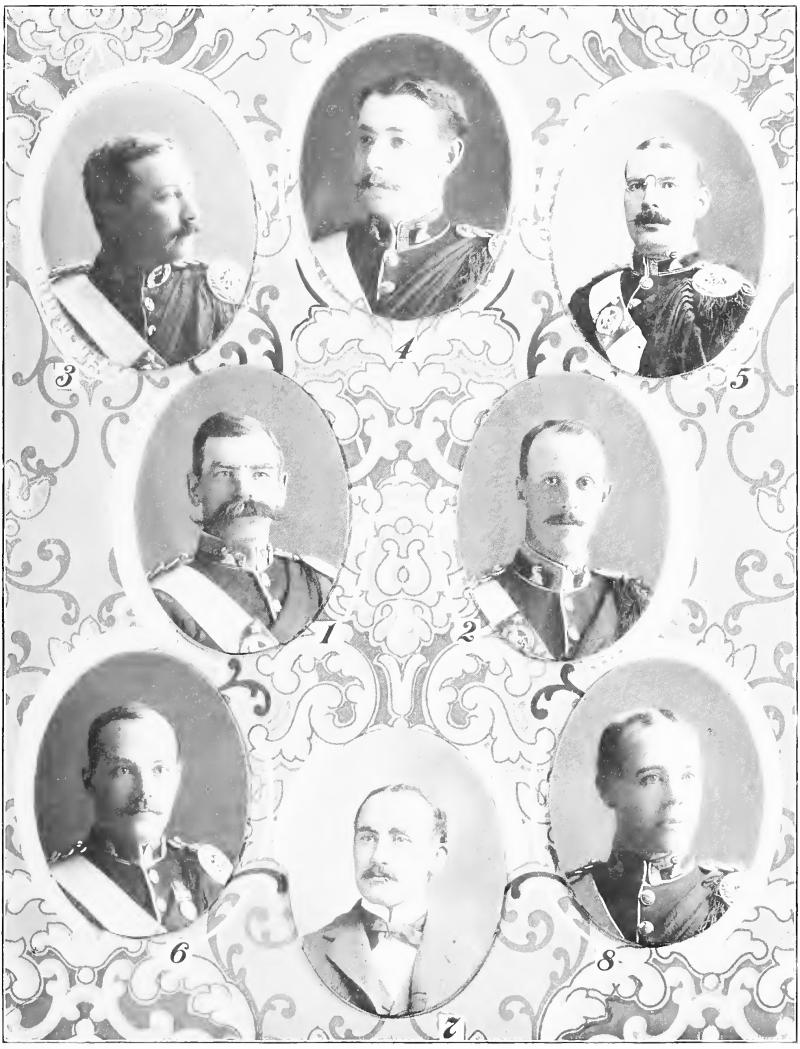
CAPTAINS OF THE 48th HIGHLANDERS.
1. Capt. and Bt.-Major Wilbur Henderson.
2. Capt. William Hendrie.
3. Capt. John A. Currie.
4. Capt. John F. Michie.
5. Capt. Hugh C. MacLean.
6. Capt. James H. Mitchell.
7. Capt. Frank M. Perry.
8. Capt. Charles A. Campbell.
The spring of 1898 ushered in an event of more than usual importance to the Forty-Eighth, viz., the retirement under the service limit of its first Commanding Officer, Lieut.-Colonel Davidson. His retirement and appointment in his place of Major A. M. Cosby are dated the 16th of March. The Regimental Orders following that date contain the following farewell from Lieut.-Colonel Davidson:—
“Lieut.-Colonel Davidson, in retiring from the command of the 48th Highlanders, desires to acknowledge the burden he is under to all those, both members of the Regiment (especially to the Adjutant, Captain Donald) and otherwise, who since the organization was authorized, have by their united efforts and hearty co-operation enabled him to accomplish the task allotted to him by the military authorities, and without which his best efforts must have been unavailing. The officers, non-commissioned officers and men who have by their untiring exertions, unwearied support, and uniform adherence to duty and discipline aided him in bringing the Regiment up to the high state of efficiency which it now occupies, would he have bear in mind that only in strict attention to duty, engendering that esprit de corps so essential, can there be success, and it rests with them to see that the same self-sacrificing devotion to the interests of the Regiment which has existed since the beginning is maintained and strengthened.
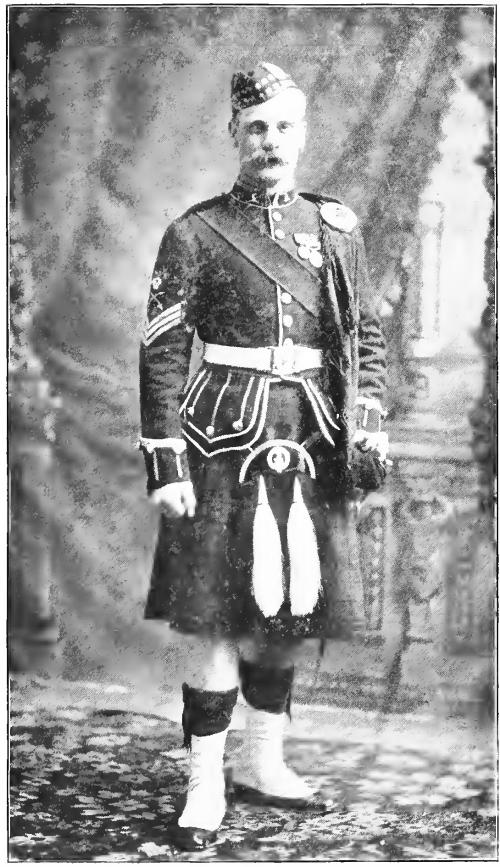
Sergt.-Instructor Alfred Williams.
Winner of the Bayonet Championship of India.
“Lieut.-Colonel Davidson bespeaks for his successor a continuance of the implicit confidence and support which has been extended to him; and with these few admonitions and acknowledgments he makes his farewell to the 48th Highlanders with every expression of gratitude for the past, well knowing they will continue in the path which they have carved out for themselves; that they will be loyal and true sons of Canada and of the majestic Empire of which we form a part; worthy of the time-honoured uniform they wear, and of their motto, ‘Dileas Gu Brath’.”
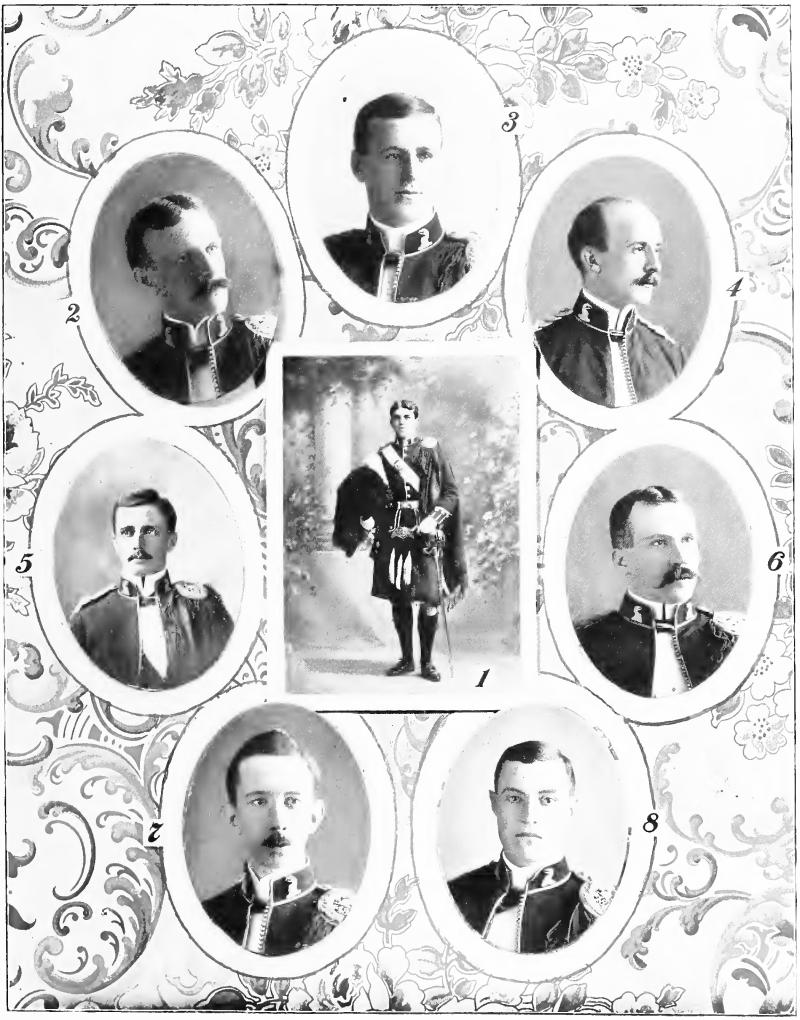
LIEUTENANTS OF THE 48th HIGHLANDERS.
1. Lieut. Norman W. Cosby.
2. Lieut. Harold J. Brooke.
3. Lieut. John T. M. Burnside.
4. Lieut. Colin C. Harbottle.
5. Lieut. Hubert V. Hamilton.
6. Lieut. Charles Catto.
7. Lieut. Arthur P. Taylor.
8. 2nd Lieut. O. L. Bickford.
Photographs by Mr. Lyonde.
The splendid condition in which Lieut.-Colonel Davidson handed over the Forty-Eighth to his successor may be gathered from the following remarks by the Inspector of Infantry at the time “Physique, excellent; drill, very good; clothing and accoutrements, excellent; arms, excellent; books, excellent; discipline, very good; general, a very efficient battalion, short in officers to the number of seven; over-strength in non-coms. and men; an excellent band, with a very good bugle and drum corps; also efficient bearers and stretchers.”
Lieut.-Colonel Davidson’s connection with the Forty-Eighth has been retained as Honorary Lieut.-Colonel.
Lieut.-Colonel Cosby, who now assumed command of the regiment, was, as has been stated previously, an active promoter of the regiment and an officer from the beginning. He took a deep interest in everything pertaining to its welfare, a course he pursued during the tenure of his command. The vacancy in the Majority, caused by Major Macdonald’s promotion to be senior Major, was filled by the appointment of Captain D. M. Robertson to be junior Major.
A regimental entertainment was held on the 15th of April, 1898, in the Grand Opera House. At the Military Tournament held in the Armories same month, the Forty-Eighth took a fair share of the honours.
The Queen’s Birthday trip, this year, was to Galt, where a cordial welcome awaited them. The manœuvres were the source of pleasure to a large number of Scotsmen who travelled to see the Forty-Eighth from the surrounding counties. Train for Toronto was taken in the evening of the same day, the outing being briefer than on any previous occasion.
The impetus caused by the success at Islington to physical drill and bayonet exercise resulted in the formation of a large class, of which Sergt. Alf. Williams was at the beginning of fall drill this year appointed Sergeant Instructor of Gymnastics. It is to be noted that the state of the parade shows excellent attendance at drill and at the rifle practices this fall. The Thanksgiving Day manœuvres were held on the 24th of November, the Thirteenth battalion taking part with the Toronto regiments. The Forty-Eighth was brigaded with the Queen’s Own Rifles, under Lieut.-Colonel Delamere, and acted their part very creditably in the field exercises of the day.
The retirement of Lieut.-Colonel Davidson was marked by the presentation to him of three valuable pieces of sterling silver plate in the form of loving cups, from the officers, non-coms., and men. The engravings were of chaste and beautiful design, the crest and motto of the Regiment being conspicuous. At the close of drill parade the Regiment was drawn up, forming three sides of a square, and Lieut.-Colonel Cosby made the presentation on behalf of the Highlanders, and alluded to the personal popularity of Lieut.-Colonel Davidson, and to his indefatigable energy in organizing and developing the Regiment. Honorary Lieut.-Colonel Davidson replied in terms of deep feeling. Thereafter a reception was held in the officers’ mess, at which, among others, the following were present: Lady Kirkpatrick, Mrs. Cosby, Mrs. Davidson, Mrs. Macdonald, Mr. Wyld, and Dr. Daniel Clark.
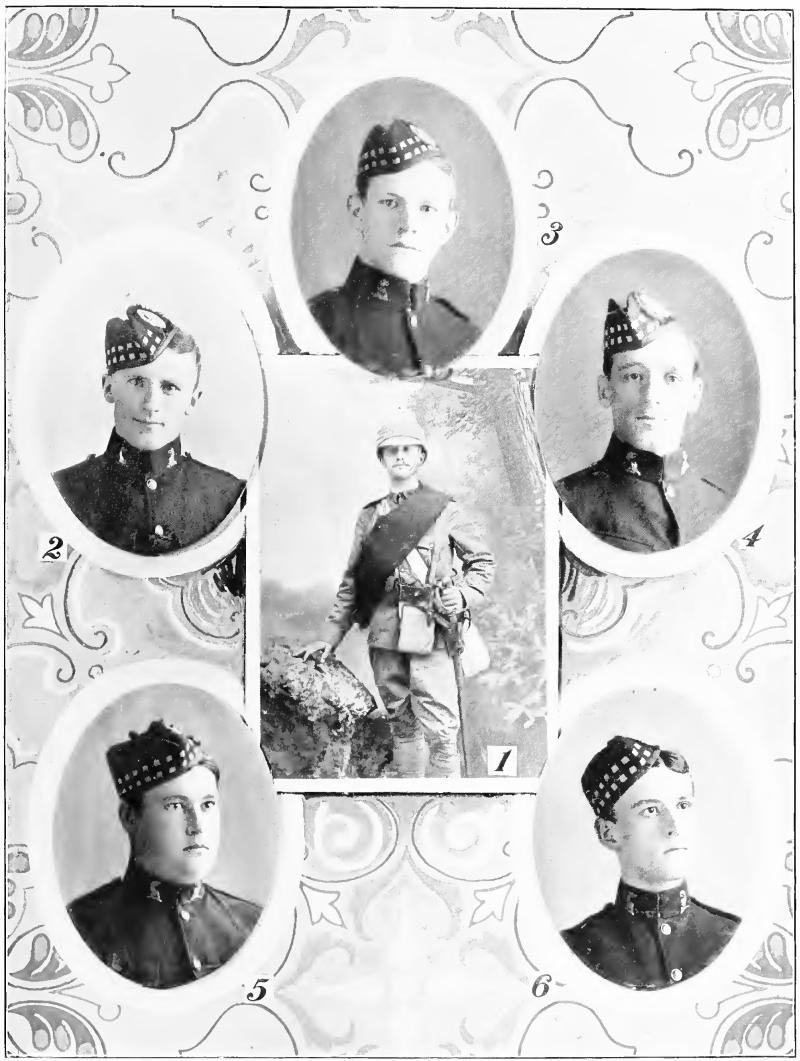
SECOND LIEUTENANTS OF THE 48th HIGHLANDERS.
1. R. H. M. Temple.
2. M. J. Woodbridge.
3. C. W. Darling.
4. Alex. W. MacKenzie.
5. O. E. McGaw.
6. L. McR. Somerville.
In Regimental Orders the following letter appeared:
“13th Nov., 1898.
My Dear Col. Cosby:
Would you kindly have conveyed to the officers, non-commissioned officers, and men of the 48th Highlanders, my deep appreciation of their kind thoughtfulness in presenting to me such a beautiful testimonial. I will ever cherish it in memory of six happy years spent with the Regiment, and will hand it down to my family with pride.
Yours very truly,
John I. Davidson,
Hon. Lieut.-Colonel 48th Highlanders.”
At the close of 1898, the condition of the Regiment was very gratifying. The general officer commanding the Canadian militia had inspected them, and made this flattering report: “General remarks 48th Highlanders; in excellent order. Remarks: Physique, excellent; clothing and accoutrements, very good; drill, very good; books, very good order; arms, excellent; discipline, very steady and quiet on parade. General: a very reliable and efficient battalion; complete in officers, and somewhat over strength in men; very keen and enthusiastic in all duties; an excellent band, with a very good bugle corps, as well as pipers; efficient bearer and pioneer corps.”
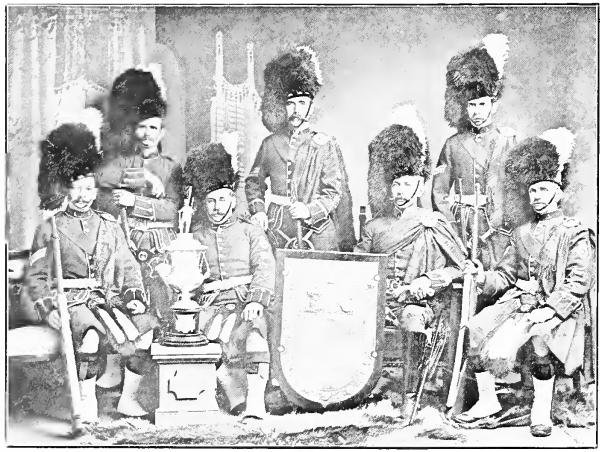
Winners of the Gzowski Challenge Cup and the British Challenge Shield.
The former presented by the late Sir Casimir Gzowski, K.C.M.G., A.D.C. to the Queen, for skirmishing, volley and independent firing; and the latter presented by the Auxiliary Forces of Great Britain to the Active Militia of Canada, for volley firing, at the D.R.A. Matches, Ottawa, 1899.
The Standing Committees for 1898 were: Regimental, Captain and Bt.-Major Henderson, Captain Michie and Lieutenant Catto; Band Committee, Major Cosby, Captain Robertson and Captain Hendrie; Rifle Committee, Major Macdonald, Captain Mitchell and 2nd Lieutenant Harbottle; Mess Committee, Captain Donald, Lieutenant N. W. Cosby, and 2nd Lieutenant Taylor; Athletic Committee, Major Henderson, Lieutenant Perry and Lieutenant Brooks.
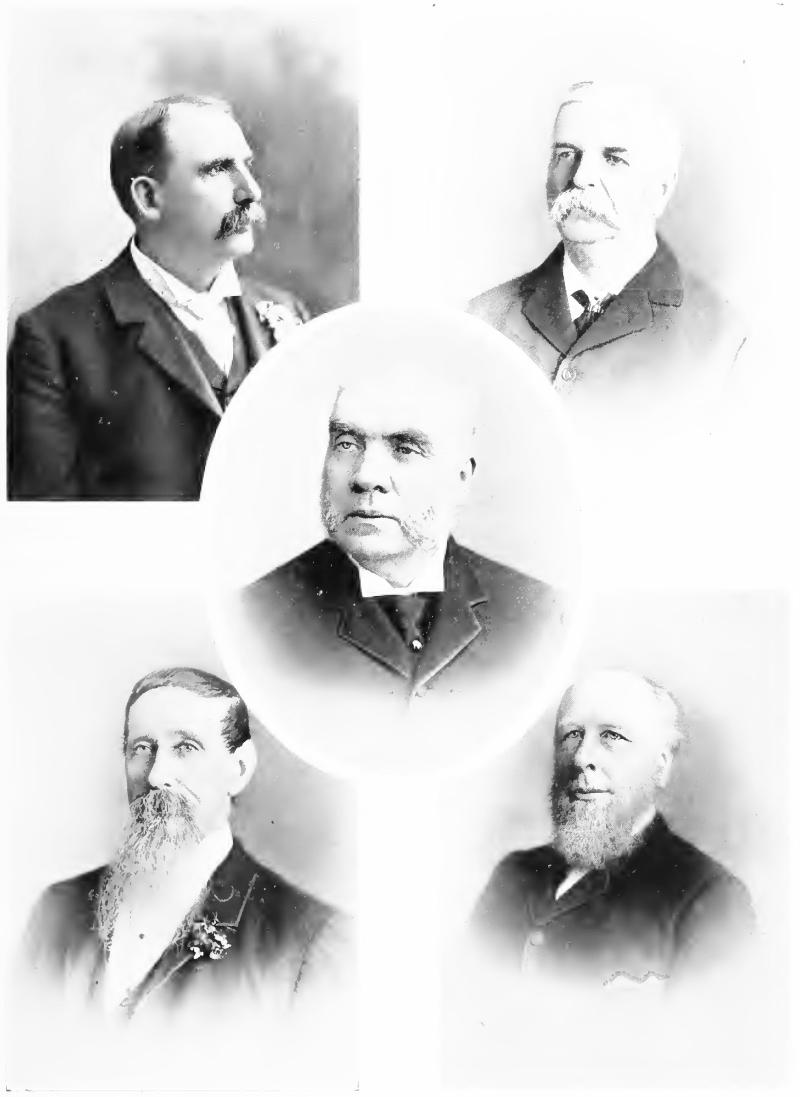
SOME CITIZENS WHO ASSISTED IN THE ORGANIZATION OF THE REGIMENT.
| E. F. Clarke, Esq., M.P., | Daniel Clarke, Esq., M.D., |
| Mayor of Toronto, 1891. | Chairman of Standing Committee. |
| Frederick Wyld, Esq., | |
| Chairman Finance Committee. | |
| Robert Swan, Esq., | The late Thos. McCracken, Esq., |
| President Caledonian Society. | Treasurer Citizens’ Committee. |
The annual meeting of the officers, held on the 3rd of February, 1899, foreshadowed an active spring in detail of regimental work. The various departments of the Regiment were well reported upon, and arrangements made for prosecuting the duties vigorously. The leading branches were placed under the following Standing Committees: Regimental, Major Henderson, Captain Michie, and Lieutenant Catto; Band, Major Robertson, Captain Hendrie, Lieutenant McDougall; Rifle, Major Macdonald, Captain Michie, Lieutenant Harbottle; Mess, Major Orchard, 2nd Lieutenant Woodbridge, Assistant-Surgeon Smith; Athletic, Captain and Bt.-Major Henderson, Lieutenant McDougall, 2nd Lieutenant Darling.
An event of interest in the history of this year was the encampment of the battalion at Niagara during the 30th of June and the 1st and 2nd of July. The Regiment paraded at 5.45 a.m., on the 30th of June, in Review Order, and proceeded to Niagara by steamer, returning therefrom on the evening of the 2nd of July. During camp the duties devolving on the regiment were calculated to be a useful experience, not as readily gained by the usual drill, and in the discharge of these the Forty-Eighth compared favourably with the other regiments forming the brigade.
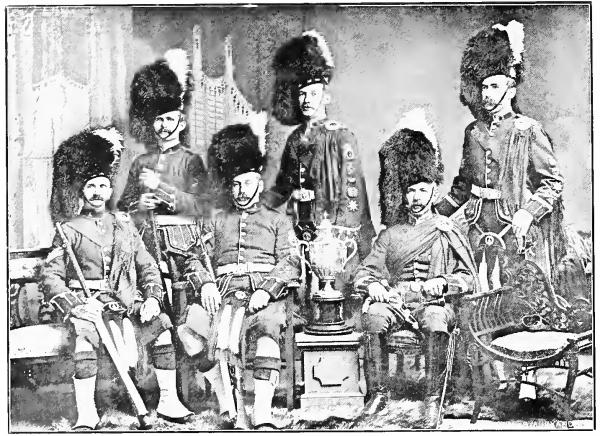
Winners of the Gillespie Challenge Cup.
Presented by T. G. Gillespie, Esq., late Secretary of the Canada Club, London, England, for team aggregate shooting, at the D.R.A. Matches, 1899.
At the Dominion Rifle Meeting, the Forty-Eighth were well represented, and its crack shots succeeded in making a brilliant showing, winning the British Challenge Shield, the Gzowski Cup, and the Gillespie Challenge Trophy; a list to be proud of, surely.
Thanksgiving Day, 1899, was observed fully a month earlier than usual, the date falling on the 19th of October. The sham fight was participated in by the Queen’s Own Rifles, the Royal Grenadiers, the Thirteenth Battalion the Forty-Eighth Highlanders, the 1st Prince of Wales Fusiliers, Montreal, the Royal Canadian Dragoons, and the 9th Field Battery. Lieut.-Colonel Henry McLaren commanded the attacking, and Lieut.-Colonel Delamere the defending force. The manœuvres exemplified quite a number of interesting tactics, and the Forty-Eighth maintained its reputation for reliability.
On the 15th of October the battalion attended divine service in St. Andrew’s church, when the Rev. Dr. Armstrong Black preached for the first time as Chaplain of the Regiment.
The interest aroused by the South African war was felt nowhere deeper than in Toronto, ever loyal to the British crown and to its imperial interests. As a matter of course, when permission was given to send a Canadian contingent to take part in the war the Forty-Eighth Highlanders responded with a will. Many applications were made for places on the contingent, but the number being restricted, the following only were taken:
“A” Company, Colour-Sergeant A. R. MacGregor, Corporal J. A. Smith, Privates Whitehead, Weller, Mitchell and Macpherson.
“B” Company, Private J. D. Spence.
“C” Company, Privates G. M. Smith and Hornibrook.
“D” Company, Privates A. C. McKenzie and McNish.
“E” Company, Sergeant W. H. Grant.
“G” Company, Colour-Sergeant Lorsch, Privates Dunham and F. K. Blain.
“H” Company, Corporals Hopeson and Banton, and Ptes. Baldwin and Morley.
Captain J. F. Ramsay, who had held the rank of Lieutenant and Captain in the Regiment, and had retired on leaving the limits, travelled from the Western States to Toronto in time to offer his services as a private in the contingent, and to be accepted. Captain F. L. Cosby and Lieutenant N. W. Cosby also went later, the former as an officer in the Canadian Mounted Rifles, and the latter as a private in the Canadian Field Artillery Corps. Lieutenant Temple went in connection with the Company from London, Ontario.
This year, 1900, opened auspiciously. The Regiment was in excellent condition, and the enthusiasm of all ranks boded well for the year. The committees struck on the 2nd of February were: Regimental, Captain and Bt.-Major Henderson, Captain Michie, Lieutenant Catto; Band, Major Robertson, Captain Hendrie, 2nd Lieutenant Mackenzie; Rifle, Major Macdonald, Captain Mitchell, Lieutenant Harbottle; Mess, Captain MacLean, Surgeon-Lieutenant Smith and 2nd Lieutenant Woodbridge; Athletic, Captain Mitchell, Lieutenant Harbottle, 2nd Lieutenants Woodbridge and Darling.
Early in the year, 1900, the Regiment was supplied with the “Oliver” equipment. In regimental orders of the 20th of April reference is made to the fact that Private Hornibrook, “C” Company, had been specially mentioned in the report of the officer commanding the 2nd (Special Service) Battalion, Royal Canadian Regiment, at Paardeberg. Col. Otter in his report said: “Another incident of coolness and pluck was that of No. 7347 Private Hornibrook, who, at daylight on the morning of the 19th instant was down to the extreme right of the lines occupied by the enemy the previous day. He was unarmed and came suddenly upon an armed Boer looking for a stray horse. With great presence of mind, Hornibrook pretended to be armed with a revolver and called upon imaginary assistance, at the same time demanding the man’s surrender. The Boer at once submitted, and on being brought in proved to be one of General Cronje’s adjutants and a most important officer.”
On the 11th of May, Major Macdonald assumed the command of the Forty-Eighth, owing to the illness of Lieut.-Colonel Cosby, and on the 12th of that month Lieut.-Colonel Cosby succumbed to that illness, at the comparatively young age of 62 years, to the deep regret of the officers and men and of the community by which he was highly esteemed. The regimental tribute reads: “It is with regret that the death is announced of Lieut.-Colonel Cosby, the late commanding officer of the Regiment, which took place on Saturday, the 12th inst. (May). Lieut.-Colonel Cosby had been actively connected with the Regiment since its organization, and took a deep interest in all matters pertaining to its welfare. As a mark of respect to his memory, officers will wear the usual mourning badge for a period of thirty days.” The spring season closed by the Forty-Eighth taking part in a garrison parade on the 24th of May, when if trooped the colours in honour of the Queen’s Birthday, and subsequently in the garrison parade and review. His Excellency, Lord Minto, the Governor-General, was present, and, himself a veteran soldier, he expressed his entire satisfaction with the excellent arrangements made for the celebration of Her Majesty’s birthday at Toronto, and his appreciation of the very smart appearance of the troops on parade.
On the 7th of June, 1900, Major Macdonald was appointed Lieut.-Colonel of the Forty-Eighth, and in his hands it is safe to say the honourable record set down in these pages will be more than fully maintained.
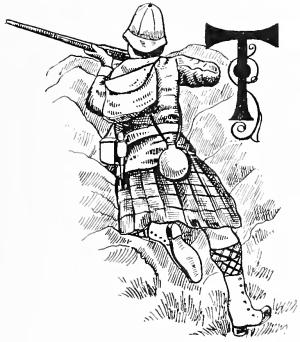
HE Forty-Eighth pleads not the excuse of youth for any shortcoming in efficiency. Nothing is more obvious than that a regiment makes progress towards a high standard of efficiency, with years. But the Forty-Eighth aimed high at the beginning,—the motto might have been, “Begin as you would wish to end.” This has been the case in an especial manner with respect to rifle shooting. From the outset the desire to become crack shots was strong, and year after year we find in the Annual Reports appeals to greater devotion to the rifle. Consequently it would not be surprising that good records should be met with, but few indeed would be prepared for the remarkable results obtained. The year 1892 gave no very favorable opportunity for rifle shooting. The question of the ranges was in an unsettled state, and but little practice could be indulged in. It may be passed over without details.
But when we come to 1893, which may be taken as the first shooting year of the Regiment, the record arrests attention. This year was the first year in which the Lake Shore Ranges were used, and that fact may to some extent account for the comparatively small attendance at the Saturday practices, which varied from forty to fifty men. The shooting at these practices, however, showed up well, and hopes were built on it which were well placed.
The Ontario Rifle Association Matches attracted a fair number of competitors from the Forty-Eighth, who, in addition to a gratifying share of individual prizes, won in these team competitions: Canada Company (Nursery) 3rd and 4th prizes; Tait-Brassey Match (Regimental teams of six) 3rd prize; Gzowski Match, prize in skirmishing, prize in volley-firing. It will be admitted that this is an excellent beginning, which drew attention to the Regiment as a new factor in the great rifle matches of the country.
Five representatives of the Regiment attended the Dominion Rifle Association Matches this year. No team victories came their way, but two members won places in the Grand Aggregate, and were entitled to take part in the final competition for the Bisley Team.
The Annual Rifle Match of the Regiment was held on the afternoon of Saturday the 7th of October. The attendance reached 125. The arrangements were complete, the weather fine, and the shooting excellent.
The Rifle Committee’s Report includes a high tribute to Major Henderson, and to the young but energetic Secretary of the Committee, Lieutenant (afterwards Captain) Ramsay, whose attention to the work of the Committee merited all praise.
1894.—In 1894 the Saturday practices were attended by an average of about fifty men, not so large a number as was to be expected from the privileges and encouragement afforded. Yet, the shooting was very good, and excellent results modified the disappointment felt at the comparatively small attendance. There were many keen shots in the Regiment, some of whom did not find it convenient to put in much time at the ranges, yet whose marksmanship was far above the average. This fact has to be taken into account when considering the attendance column in the shooting statistics. The Highlander naturally loves a gun, and it is no indifference, but business considerations that prevent the Highland volunteer from practising rifle shooting on every opportunity that offers.
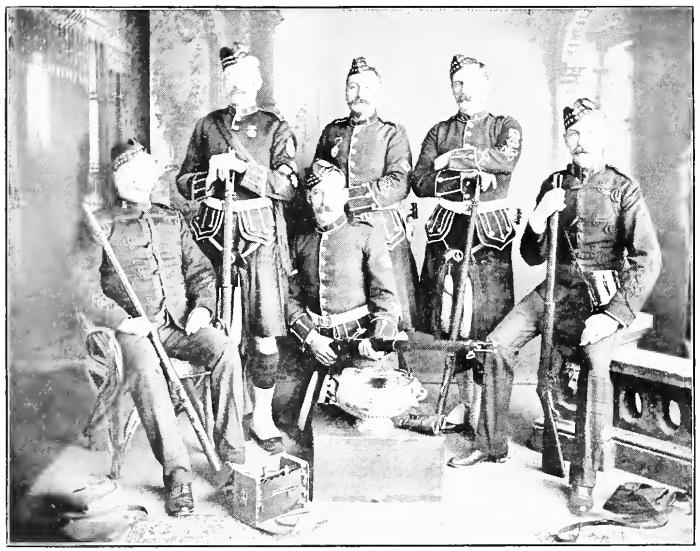
Winners of Walker Cup, D.R.A. Matches, 1894.
Two teams were entered in the Martini series of the Canadian Military Rifle League; one team was also entered in the Snider series, but was subsequently withdrawn, owing to the fact that there were not a sufficient number of eligible men to fill the places in the team. In the ten-men team series, the first team of the Forty-Eighth occupied 11th place. In the twenty-men series, the Forty-Eighth team occupied 8th place.
At the Ontario Rifle Association there were eighteen representatives of the Regiment who fired throughout the competition, besides a number of others who fired in several of the matches.
At the Dominion Rifle Association Matches, eleven men competed, a comparatively large number. A fair number of individual prizes was secured by members of the Regiment at both these competitions—the Ontario and the Dominion. At the former, Staff-Sergeant Wm. Harp and Major W. C. Macdonald secured places in the grand aggregate; occupying respectively 1st and 8th places. At the latter, the Dominion, Sergeant Adam Graham was fortunate in securing a place in the grand aggregate. In the team competitions the Regiment was very successful. In the Skirmishing and Volley Firing competitions at the Ontario Rifle Association, 2nd place was secured, and at the Dominion, the following record was made: 1st place in the Walker Match, which was open to battalion teams of six men, the number of entries being very large; 4th place in the Gzowski Military Match; tied for 3rd place in the British Challenge Shield Match. The capture of the 1st prize in the Walker Match was a victory for which the Regiment had every reason to feel proud. The score made was, it was said, the highest on record made by any regimental team in Canada, and it is doubtful if it had been excelled elsewhere under similar conditions. It was 539 points, or an average of 90 points per man. Members of the Regiment then at Ottawa were heartily congratulated, and the superb shooting evoked much popular praise.
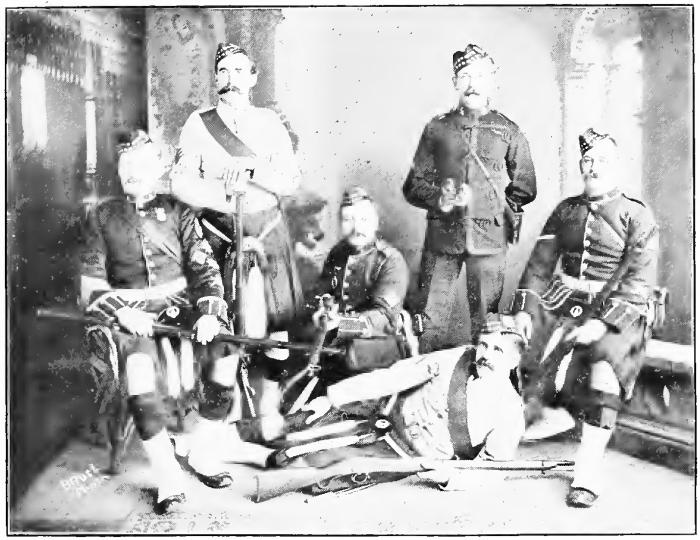
Winners of Skirmishing Team Competition, 1894.
The annual rifle match of the Regiment took place on the last Saturday in September of this year. The prize list was long and tempting, from the competitor’s point of view, the value of the prizes offered amounting to $1,500. Two hundred and fourteen men attended, and the weather being fine, the day was not only profitably, but enjoyably spent.
The Annual Report singles out “H” Company as specially worthy of commendation for its shooting during the season, and at the annual regimental match.
In this year Lieut.-Colonel Davidson was elected president of the Ontario Rifle Association.
1895.—The motto for this year’s work at the butts was the axiom of Lord Wolseley: “If a volunteer is to be worthy of his name, of the nation he serves, and of the Queen’s uniform, his first duty is to shoot well.” On this the committee, of which Major Macdonald was president, acted strenuously, and the reward of their efforts was a gratifying record for the year.
Beginning with the Canadian Military Rifle League, the Regiment entered two teams. In the ten-men series they secured 12th and 37th places in a competition with about seventy teams, a very good standing indeed, and an improvement on the year previous.
In the Ontario Rifle Association Matches, seventeen fired throughout the competition. The individual winnings were thirty-six prizes, amounting to $189. and including three firsts, viz.: the Gilmour, Gibson, and Macdonald Matches; and three team prizes: second in the Canada Company, $25; fifth in the Walker, $10; third in the Gzowski, $25; making the total winnings of the Regiment thirty-nine prizes, for $249. as against twenty-four prizes, for $147. in 1894.
But the year 1895 is famous in the annals of the Regiment chiefly on account of the magnificent shooting at the Dominion Rifle Association Matches. Sixteen competitors represented the Regiment. There were but eleven in the year before. The individual winnings were thirty-one prizes (including two firsts, viz.: the Hamilton Powder and Grand Aggregate), amounting to $258.40. Team prizes: Minister of Militia, third prize, $25; Lansdowne Aggregate, sixth prize, $18; British Challenge Shield, sixth prize, $20; a total of thirty-four prizes, aggregating $321, as against twenty-six prizes, aggregating $208.72 in 1894. Not only the total but the average winnings per man were greater than in 1894. Four members of the Regiment, viz., Staff-Sergeant Wm. Harp, Major Macdonald, Private McVittie, and Sergeant Milligan secured places in the hundred who were entitled to compete for Bisley, and two representatives were eligible for the Bisley team, viz.: Staff-Sergeant Harp and Major Macdonald, who occupied the first and the sixth place respectively. Special mention should be made of Staff-Sergeant Harp’s splendid shooting, inasmuch as the scoring made by him had not been equalled in any similar competition of a similar nature in Canada. He won the first prize in the Grand Aggregate, and occupied the first place on the Bisley team. In recognition of the honour he brought to the Regiment, and with which he crowned himself, the Caledonian Society and a few friends, led by the president, Mr. Wm. Simpson, an enthusiastic friend of the Regiment, and Mr. David Walker, presented Mr. Harp with a valuable and beautifully inscribed gold watch and chain, with a valuable pendant attached, on the occasion of the annual dinner of the Society in celebration of Hallowe’en.
The Annual Regimental Match was held on Saturday, the 28th September. The weather was fine, but not favourable to high scoring. About 200 competitors entered. The amount offered in prizes, including challenge cups, was $1465, and the shooting under the conditions existing was fairly creditable.
The services of Lieut. Mitchell, the Secretary-Treasurer of the Committee, were most valuable during the year and call for special mention.
1896.—The increasing interest in rifle shooting is to be seen in the additional facilities granted to the members of the Regiment this year, by a material reduction on the railway fare of those attending the ranges. Sergeant Hollinger had charge of the young shots, assisted by a non-commissioned officer detailed weekly, and this arrangement proved satisfactory.
Three teams were entered in the Martini series of the Canadian Military Rifle League. The standing of the twenty-men team and the thirty-men team was higher than that of former years, and evidenced a very marked improvement in team and individual marksmanship.
The individual winnings at the Ontario Rifle Association Matches were thirty-nine prizes, amounting to $229.16 and gold medal. Team: First prize City of Toronto Match, Ladies’ Challenge Cup and $30; fifth prize Gzowski Match, $15; making the total winnings of the Regiment forty-one prizes, for $274.16, and gold medal. The most valuable and important individual prize of the meeting, viz., the first in the City of Toronto Match, gold medal and $50, was won by Corporal Kerr.
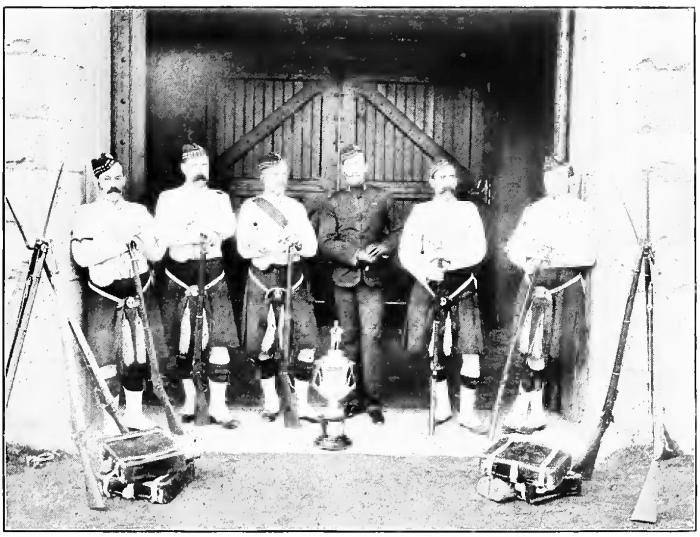
Winners of the Gzowski Challenge Cup, D.R.A. Matches, 1896.
The individual winnings at the Dominion Rifle Association were twenty-five prizes, amounting to $123.66 and badge. The team prizes won were: Gzowski Match, first prize, challenge cup and $50; British Challenge Shield, fifth prize, $22; a total of twenty-seven prizes for $195.66. Corporal Kerr, Pte. Mishaw, and Staff-Sergt. Harp secured places in the Governor-General’s Hundred. Corporal Kerr occupied seventh place on the Bisley Team list for the year. Corporal Kerr, who shows so well in these matches, received his entire training as a rifle shot while serving in the ranks of the 48th Highlanders.
This shooting year was signalized by the institution of a new competition for marching and firing. Eight teams were entered from the district, two of them from the Forty-Eighth, whose first team, commanded by Lieut. J. H. Mitchell and Colour-Sergt. D. W. Smith, had the honour of securing first place and winning for the first time, it was offered for competition the handsome Challenge Cup donated by Major-General Gascoigne. A large sized photograph of the team was presented by the Regiment to each of its members in recognition of their victory.
The annual Regimental Match was held on September the 26th. About 200 entered into the competitions. The programme and the prize list were very inviting. Showers fell during the early afternoon, but good shooting was made. The team and principal individual prizes and marksmen’s badges were formally presented on the 20th of November at the Armouries, in the presence of a large number of friends of the Regiment.
1897.—The Lee-Enfield rifle was introduced this year. The reports show a gratifying increase in the attendance at the weekly practices, and a marked improvement in the good shooting already attained to. In the class-firing the regimental figure of merit was not only higher than formerly, but exceeded that of the other two City corps.
Seven teams, two in the Martini and five in the Enfield series, were entered for the Canadian Military Ride League competition, and excellent shooting was made.
The individual winnings at the Ontario Rifle Association matches were fifty prizes amounting to $228, one bronze and two silver medals, second team prize Gzowski Match, $30; a total of fifty-one prizes; amounting to $258 and three medals, an increase on the record of 1896.
The number of representatives at the Dominion Rifle Association matches was only eleven, but the shooting was of the highest excellence. The individual winnings were thirty-seven prizes aggregating $436 and two badges; fourth team prize (Walker Match), $30; second in the Lansdowne Aggregate, $30; first in the British Challenge Shield, the shield and $40. The score made in the British Challenge Shield was the highest on record. Out of the eleven representatives, seven—Staff-Sergt. Graham, Pte. McVittie, Major Macdonald, Pte. McLaren, Pte. Davidson, Corporal Kerr and Pte. Hutchinson—obtained places in the Governor-General’s Hundred. In the Governor-General’s Match Privates Davidson and McVittie tied with Corporal Windatt, R.G., for the Governor-General’s prize, and in shooting off the tie they secured second and third places respectively. Private McVittie secured sixth place on the Bisley Team and Pte. Davidson first place on the waiting list for same.
In the Marching and Firing Competition two teams entered. That commanded by Lieut. Harbottle and Sergt. Frank Dewar won the second prize.
The annual Regimental Rifle Match was held on Saturday, the 25th of September. The number of competitors was 225. The weather was good and the match passed off very successfully.
In reporting upon the year’s work the Rifle Committee states that the advancement in rifle shooting exceeds that of any former year.
1898.—The year opens well at the ranges, the weekly practices being taken advantage of very generally. The Canadian Military Rifle League attracted eight teams from the regiment, seven of whom fired throughout. Thirteenth place was secured by the 1st team, a higher standing than in any former year.
At the Ontario Rifle Association matches the number of representatives of the Regiment was larger than usual. Their winnings in individual prizes were 72, aggregating $322, a silver medal and cup, as against 50 prizes and $258 and three medals in 1897. The team prizes won were: Third prize Canada Company Match, $20; second prize Corporation of the City of Toronto Match, $25; fourth prize Tait-Brassey Match, $30; and fourth prize Gzowski Match, $20; total $97. In the individual competitions, the first prize in the grand aggregate, the most important contest of the meeting, was won by Sergt. J. McVittie.
Fifteen representatives entered for the Dominion Rifle Association matches. The total individual winnings were 29 prizes, amounting to $153, and four team prizes, amounting to $65. Three members of the Regiment, viz., Staff-Sergt. Graham, Corporal J. C. Smith (a young shot who made an excellent record at these matches), and Corporal H. Kerr won places in the Governor-General’s Hundred, and Staff-Sergt. Graham won his place upon the Bisley Team for 1899.
In the Marching and Firing Competition No. 1 team, commanded by Lieut. Harbottle, won third place and No. 2 team, commanded by Lieut. Hamilton, won fifth place.
The annual Regimental Rifle Match took place on Saturday, the 8th of October. 235 competitors were present, a larger number than on any former year. A good prize list was offered, and, the weather being favourable, the match passed off very satisfactorily.
Special measures were adopted this year to turn the rifle gallery at the Armories to the best advantage, and the suggestion made that a company be detailed from parade each night to devote the entire evening to practice firing, it being apparent that better instruction in position and aiming drill could be imparted at the gallery than at the ranges.
1899.—This year was comparatively uneventful at the weekly practice and in the Canadian Military Rifle League Competition, although excellent work was put up.
At the Ontario Rifle Association Matches there was an increased representation, with seventy individual prizes, aggregating $284.90, and a bronze medal as winnings. Five regimental team prizes, amounting to $156, were won, as compared with four prizes and $95 for the previous year. “E” Company won first prize, $20 and the Brassey Cup, in the competition for company teams in the Tait-Brassey Match.
Sixteen crack shots attended the Dominion Rifle Matches from the Regiment. The winnings were 53 individual prizes, $299.10, and four team prizes, viz., $76 in cash and the Gzowski and Gillespie Challenge Cups, and the British Challenge Shield. The team prizes included first in the Gzowski Match, first in the British Challenge Shield, and first in the Gillespie Challenge Pup Aggregate, and third place (only four points behind the first team) for the Lansdowne Cup Aggregate. Sergt. J. McVittie, Sergt. J. C. Smith, Pte. H. McLaren, and Corporal H. Kerr secured places in the Grand Aggregate, and Sergts. McVittie and Smith were entitled to represent the Regiment at Bisley in 1900.
This, it must be admitted, is a record to be proud of, proving, as it does, that in the fluctuations to which a shooting record is so obviously liable, the Forty-Eighth have held their own with the best marksmen in Canada for a period of years which may be taken as long enough to be a valuable test.
The Annual Rifle Match, and the Marching and Firing Competition were well patronized and the Regiment showed up well in both events.
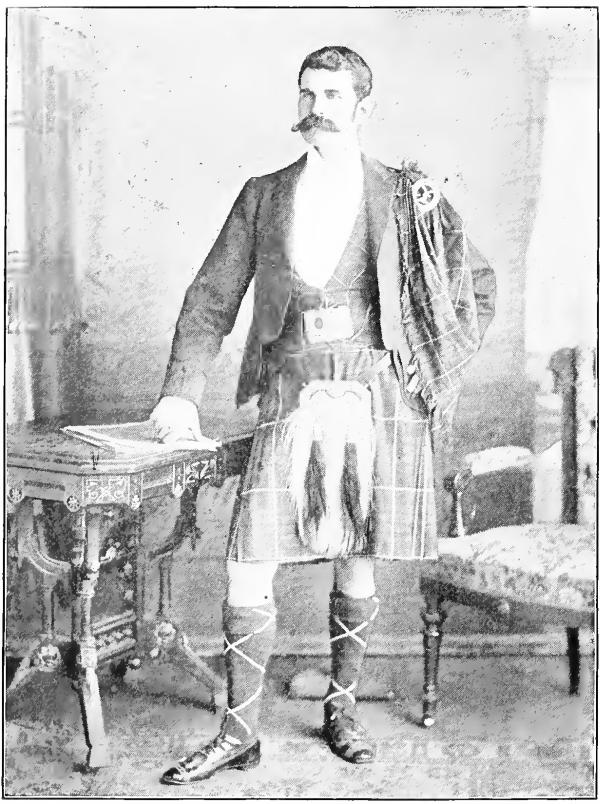
Alexander Fraser, M.A., Regimental Historian.
Cups and Trophies.—Following are the winnings for the cups and trophies offered for competition by the Regiment:—
Old Chum Tobacco Trophy, donated by D. Ritchie & Co., Montreal, through Hon. Major and Quartermaster W. H. Orchard: 1892, won by “A” Co.; 1893, “H” Co.; 1894, “H” Co.; 1895, “H” Co. Finally won by “H” Co.
Toronto Silver Plate Co.’s Trophy: 1893, won by “G” Co.; 1894, “E” Co.; 1895, “E” Co.; 1896, “A” Co.; 1897, “G” Co.; 1898, “G” Co. Finally won by “G” Co.
Crean & Rowan Banner: 1893, won by “H” Co.; 1894, “H” Co.; 1895, “C” Co.; 1896, “A” Co.; 1897, “A” Co.; 1898, “E” Co.
The Ladies’ Cup: 1893, won by “B” Co; 1894, “C” Co.; 1895, “H” Co.; 1896, “C” Co.; 1897, “G” Co.; 1898, “G” Co.
Caledonian Society Trophy, Scotch Tup’s Head, donated by the Caledonian Society of Toronto: 1894, won by “H” Co.; 1895, “A” Co.; 1896, “H” Co.; 1897, “E” Co.; 1898, “H” Co. Finally won by “H” Co.
Canadian Military Rifle League Cup: From 1895 to 1898 inclusive, won by Sergeants.
Walker Trophy: 1896, won by “H” Co.; 1897, “E” Co.; 1898, “E” Co.
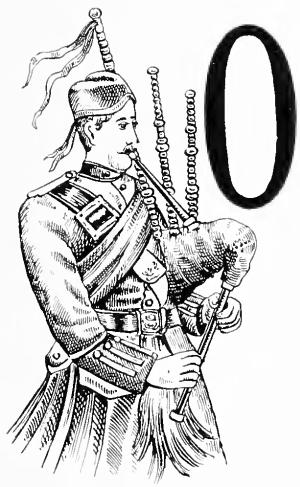
NE of the necessary parts of a Highland regiment is a pipe band. Tradition assigns a place to the piper at Bannockburn, and even English Chaucer sang of the bagpipe as an instrument of war. An efficient pipe-band is the pride of every true commanding officer of Highlanders; without one the very heart would be out of the thing. At the very commencement of the Forty-Eighth the pipers were there. When Captain Henderson drilled the men in Bailey’s Hall, Piper Charles Munro and Piper George Murray were there to rouse the enthusiasm of the candidates for a place in the Regiment. On the formal organization of the Regiment one of the first things done was to secure for the pipe-majorship Mr. Robert Ireland, reputed the best player on the continent. In a short time the pipe-band became famous, and the blue-ribbon of the profession in Ontario was a position in the Forty-Eighth pipe band.
When the band was fully organized by Pipe-Major Ireland, and during his tenure of the position, the following gentlemen were members of the pipe-band:— Sergeant James Sutherland, Lance-Sergeant John Trenholm, Pipers Frank Aitken, Wm. Currie, E. D. McInnes, James R. Muir, George Murray, John Sullivan, John Sutherland, S. C. Swanson, Blackhall, Malcolm McBain and John Sharpe, Drum-Sergeant George Kyle, Drummers Alexander Munro, Samuel McCracken, William McCracken, and Daniel Wilson.
Pipe-Major Ireland joined the 93rd Sutherland Highlanders when quite a young man, and began his military training as a piper in the band of that famous regiment. On this continent his home had been chiefly in New York until he came to Toronto to be Pipe-Major of the Forty-Eighth. He figured at all the important competitions held under the auspices of the Scottish societies of Canada and the United States for many years, and held several championships, among them being the Champion Cup of Canada, presented by the Caledonian Society of London, Ontario, and the Champion Bagpipe Trophy of North America (won three times) presented by the West Elgin Caledonian Society, Dutton, Ont. In the bagpipe contests held by the North America United Caledonian Assn., of whose committee he was long a member, he was a prominent, and generally the leading competitor. As a composer of marches he occupies a flatteringly high place. When Pipe-Major of the Forty-Eighth he composed a march in honour of the Regiment, and named it “Lieut.-Colonel John I. Davidson,” after the commanding officer of the battalion at that time. The march is an exceedingly beautiful composition, but on account of the delicate intricacy of the gracing and combinations, it is heard to better effect, in the hands of a good piper, when played as a slow march than in marching time; therefore, it has not become a popular tune on parade, although as a practice tune it holds a high place in the estimation of the lovers of the pipes. It is greatly admired in the Old Country, and just as in some instances one song has made a poet famous, so this one tune has raised Mr. Ireland to a niche in the piper’s temple of fame. Other compositions might be mentioned also, were they associated with the gallant Forty-Eighth. The writer, however, may be pardoned if he makes a single exception and acknowledges here Mr. Ireland’s tune named after him, which also has met with no small praise.
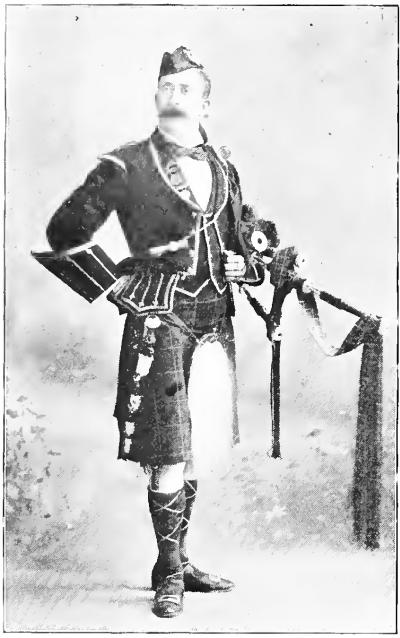
Robert Ireland.
First Pipe-Major of the 48th.
Following Mr. Ireland, the pipe-majorship was held by Mr. Norman MacSwayed, a native of Dingwall, who had a military training as a piper and who was a strict disciplinarian and a thoroughly capable leader. He was known as a good piobaireachd player in Scotland, and had won honours at Braemar, and other Highland gatherings where were competitions for mastery in the music of Scotland. Mr. MacSwayed had in his band: Sergeant George Murray, Pipers Wm. Currie, Hugh Mackenzie, James R. Muir, John Sutherland, John Trenholm, George Thomson, James Thomson, John Shire, and John Bryden; Drummers Alexander Munro, Samuel McCracken, Harry McGowen, James Malbrough, Charles Hawkins, and George Cottenden.
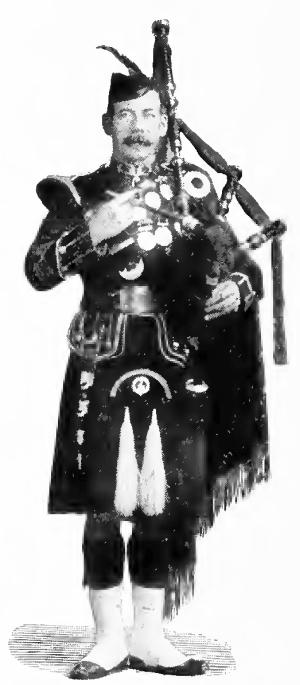
Pipe-Major F. Beaton.
When Mr. MacSwayed resigned the position to return to Scotland, his place was filled by Mr. Farquhar Beaton, who holds the office now. The pipers who have been and are in the band during Mr. Beaton’s term are: Sergeants George Murray, John Trenholm, and Samuel Leask; Pipers Wm. Currrie, George Thomson, James Thomson, Wm. Johnson, Samuel McCracken, James Clunas, Joseph Halcro, James Craig, H. Bourne, George Sutherland, Frank Ritchie, Gavin Hardy, Thomas Richardson, Alexander Robertson, Charles Boney, Charles Currie, Archibald Ritchie, and A. B. MacGillivray; Drummers Alexander Munro, Charles Hawkins, George Cottenden, Wm. McCracken, J. Malbrough, Walter Ross, Harry Latremoville, and Robert Murray. At the present time the strength of the band on parade is twenty-three—sixteen pipers and seven drummers—but there are quite a number under tuition, who do not rank on the strength of the band.
Pipe-Major Beaton has maintained the efficiency of his pipe-band by indefatigable practice. There are four practices every week, two for the beginners and two for the advanced pipers. With the former great pains are taken. Besides the ordinary scales Mr. Beaton has devised simple scales which explain those given in the books, with the result that the music is simplified and made easier to the learner. Attention is given to the capacity of each member of the class and special exercises are given accordingly. Therein lies Mr. Beaton’s success as an instructor. He has introduced a new practice to his band, viz., playing the four parts, the melody, tenor, alto, and bass, of the tune at the same time, on an orchestral basis, as has been the practice with some of the Old Country regimental bands for many years, but hitherto unknown in Canada. This idea was developed from an incident worth recording. When His Excellency, the Earl of Aberdeen, who is an ardent admirer of the bagpipes, was publicly entertained in Toronto, prior to his departure from Canada on the expiry of his term as Governor-General, the pipe band of the Forty-Eighth was in attendance at the ceremonies (in the Parliament Buildings). The Pipe-Major and one of the pipers played in concert the first and second part of the tune “The Green Hills of Tyrol.” The effect produced was at once noted by His Excellency, who complimented the Pipe-Major personally, and strongly recommended the cultivation of part-playing on the pipes, which since then has been done.
Pipe-Major Beaton has played the pipes since he has been fourteen years old, and has long been connected with volunteer corps as a piper. He won the championship of Edinburgh in 1881 against fifteen competitors, of whom the late celebrated William MacLennan was one. One of his most coveted honours is the Chicago World’s Fair championship and gold medal. In the circuit of Caledonian games in Canada and the United States for the years 1895, ’96, ’97, he took every first prize for which he competed, and he holds the first place for two of the three years required for the championship trophy of the West Elgin Caledonian Association. He is the able composer of quite a number of marches, the most noted being “The Midlothian Amateur Pipe Band,” published by David Glen, Edinburgh; and the “North American Pipers’ Association March.”
The Brass Band of the Forty-Eighth Highlanders was organized in the fall of 1892. Mr. John Griffin, a graduate of Kneller Hall Military School of Music, and Bandmaster of H. M. 63rd Regiment, was selected, and appointed Bandmaster. Upon his arrival in Toronto he began the formation of the first “kilted” brass band in Canada. The Regiment purchased a complete set of band instruments, uniforms, etc., costing in the neighborhood of $5,000. The Band paraded for the first time with the Regiment in the spring of 1893, for the purpose of attending a church parade. From the very outset the Band became one of the recognized bands in Canada and played at some of the most important events.
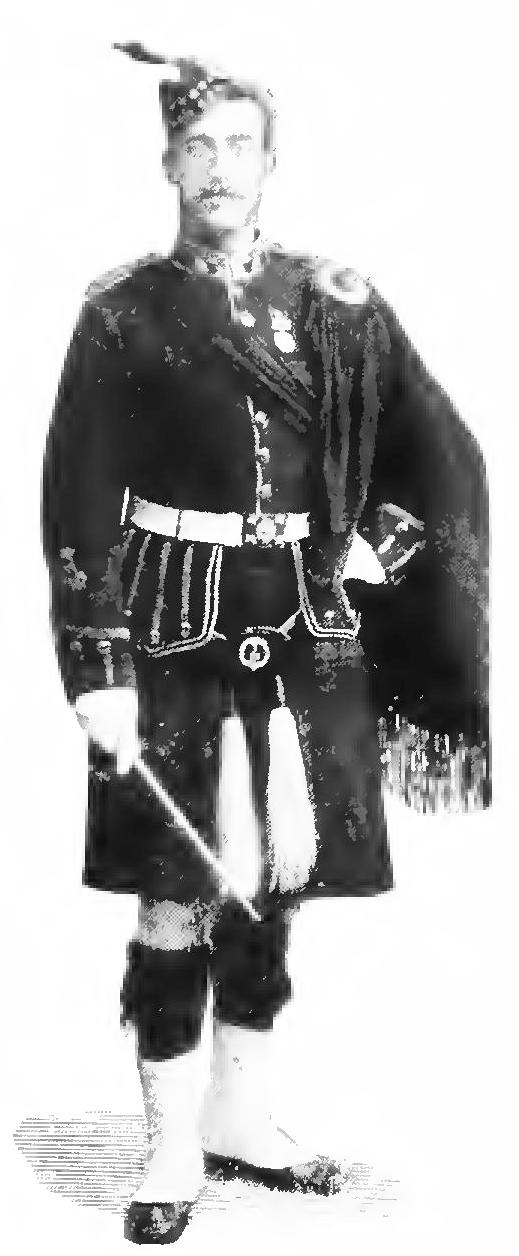
Bandmaster J. Slatter.
The position of Bandmaster becoming vacant in January, 1896, Mr. J. Slatter, the present Bandmaster, was selected from a large number of applicants, and was appointed to fill the vacancy. Mr. Slatter was formerly soloist in the famous 1st Life Guards’ Band, of London, Eng., and later served with distinction in Brook’s great Marine Band. He is a successful composer and writer of band music. Under his direction the Band at once took rank, and has been acknowledged for three years as one of the best, if not the best, brass band in Canada. It has grown to a strength of forty members, and the Regiment is naturally extremely proud of it.
The Bugle Band was organized at an early stage in the history of the Regiment, under Bugle-Major E. Robertson, and soon attained to strength and excellence. Bugle-Major Robertson was succeeded by Mr. J. Woods, also an excellent instructor and manager. At the present the Bugle Band is disorganized, the Regiment trying an experiment in the direction of further strengthening the Pipe and Brass Bands instead of maintaining three.
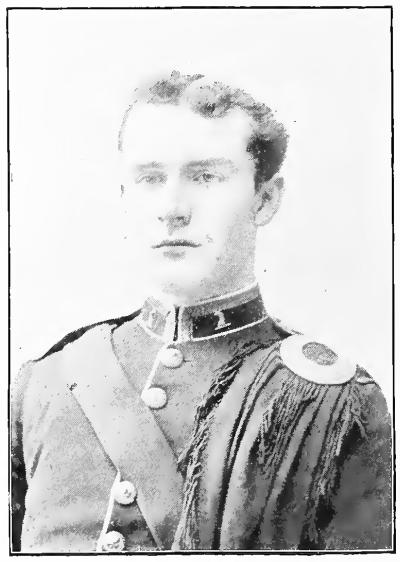
E. Robertson.
First Bugle-Major of the Regiment.
The Sergeants’ Mess is a most important part of any military organization. That of the Forty-Eighth Highlanders, it goes without saying, is no exception to the rule. The date of its formation is the 4th of May, 1892, and the place No. 66 Elm Street, the residence of the Sergeant-Major, Mr. Alfred G. Robertson. Colour-Sergeant Hugh Rose acted as Secretary-Treasurer. The subsequent meetings were held at the old Upper Canada College buildings, and until the first annual meeting in January, 1893, the Mess was conducted by an executive committee, consisting of Staff-Sergeant Harp, Staff-Sergeant Hollinger, Colour-Sergeant George MacBean, Colour-Sergeant Rose, Sergeant D. W. Smith, and the Sergeant-Major, with Sergeant Andrew Gordon Fraser as Secretary-Treasurer of the Mess. On October 17th, 1892, the Mess moved into quarters at old Upper Canada College. On the 9th of January, 1893, the following officers and committees were elected: President, Staff-Sergeant Wm. Harp; Vice-President, Colour-Sergeant Geo. MacBean, and later on, Staff-Sergeant Rose; Secretary, Lance-Sergeant Arthur McEvoy; Treasurer, Colour-Sergeant Hugh Rose. Committee: Colour-Sergeant Wm. Stewart, Sergeant A. G. Fraser, and Sergeant Davidson. Librarian to the Mess, Sergeant A. G. Fraser.
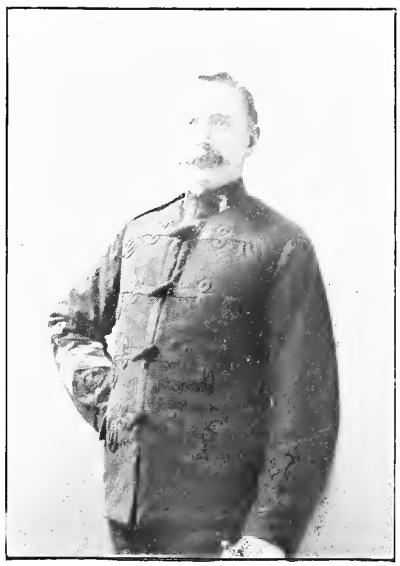
Sergt.-Major Alexander Rose.
The first annual dinner was held on the 10th of March, 1893, in the Arlington Hotel, the Sergt.-Major presiding. The guests included a large number of officers and non-coms. of the neighbouring regiments and friends of the Forty-Eighth.
On the 27th of July, 1893, a joint moonlight excursion with the Sergeants’ Mess of the 13th Battalion was held to Oakville, the Toronto men going by the steamers “Garden City” and “Greyhound.”
The officers for the succeeding years have been: 1894—President, Staff-Sergeant Harp; Vice-President, Staff-Sergeant A. Rose; Secretary, Colour-Sergeant Neil MacKinnon; Treasurer, Sergeant John Graham. Board of Management: Colour-Sergeant Stewart, Colour-Sergeant Lawrence, and Sergeant Davidson.
1895—President, Staff-Sergeant Harp; Vice-President, Staff-Sergeant A. Rose; Secretaries, Colour-Sergeant Neil MacKinnon, and Sergeant Donald Morrison; Treasurer, Sergeant John Graham. Board of Management: Colour-Sergeant Lawrence, Colour-Sergeant Smith, and Sergeant McEvoy.
1896—President, Staff-Sergeant A. Rose; Vice-President, Colour-Sergeant Stewart; Secretaries, Sergeant D. Morrison, and Sergeant S. V. Jones; Treasurer, Sergeant Cameron. Board of Management: Colour-Sergeant Wright, Colour-Sergeant Shaw, and Sergeant C. McDonald.
1897—President, Colour-Sergeant Stewart; Vice-President, Sergeant Cameron; Secretary, Sergeant S. V. Jones; Treasurer, Lance-Sergeant Arch. Macgregor. Board of Management: Sergeant Lambe, Sergeant Bruce, and Colour-Sergeant Richie.
1898—President, Sergeant Lambe; Vice-President, Colour-Sergeant Jones; Secretary, Colour-Sergeant Grant; Treasurer, Lance-Sergeant Miller. Board of Management: Colour-Sergeant Wallbridge, Sergeant Macgregor, Sergeant McRae.
1899—President, Bugle-Major Woods; Vice-President, Colour-Sergeant Macgregor; Secretaries, Sergeant W. H. Grant, and J. H. Campbell; Treasurer, Sergeant E. N. May. Committee: Sergeant Stewart, Colour-Sergeant Stevens, and Colour-Sergeant Rae.
1900—President, Bugle-Major Woods, until April 18th, and from that date Sergeant Merry; Vice President, Colour-Sergeant Rae; Secretary, Sergeant J. H. Campbell; Treasurer, Colour-Sergeant Kirkness. Board of Management: Sergeant Miller, Hospital Sergeant Ross, and Colour-Sergeant Thorne.
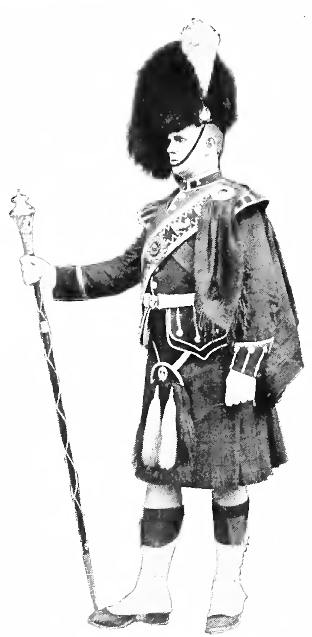
Drum-Major McLeay.
The honorary members of the Sergeants’ Mess are: Mr. Wm. Simpson, builder, Toronto, who took a deep interest in the formation of the Regiment; Mr. Alexander Muir., M. A., author of “The Maple Leaf,” Canada’s national song; Sergeant-Major Harding, and Mr. Bert Harvey.
It is a rule of the Mess that a handsome clock should be presented to each member who leaves the bachelors’ ranks for those of the benedicts, and this rule has been ever enthusiastically honoured.
Among the donations to the Mess-room from friends is a fine marble clock, the gift of Mrs. Davidson, wife of the first commanding officer of the Regiment, and many valuable pictures from members and ex-members.
A function which is greatly enjoyed is an annual rifle contest between picked teams, one representing the Sergeants’ Mess and the other the Officers’ Mess. Although some of the crack shots of the Regiment are officers, the non-coms. have never failed so far to win the trophy, which is a cup, to be held by the winning team for the year.
The main objects aimed at by the Sergeants’ Mess are: to stimulate mutual interest in the efficiency and welfare of the Regiment, and to cultivate and preserve friendly regard and esteem amongst the members. Mess meetings are held on the second Monday of each month, and during the winter season bowling is considerably indulged in under the auspices of the Mess, winding up by a stirring tournament, at which valuable prizes are offered. In the Mess-rooms there are first-class illustrated papers and magazines for the use of the members, who find in the Mess quarters a convenient rendezvous at which esprit de corps and the social side of volunteering can be pleasantly cultivated.
The value of such a spirit need not be enlarged upon. To it every military organization owes more than can be told. Time and again this truth has been exemplified in the experience of the Forty-Eighth Highlanders, whose non-commissioned officers are enthusiastic soldiers, and thoroughly efficient in the positions they occupy. It has been the good fortune of the regiment to be admirably officered, and with equal emphasis this can be applied to the non-commissioned officers, whose services have been conspicuous in maintaining the excellent condition of the regiment. Without the Sergeant’s Mess this could not be done, for it is the home of the non-coms., the centre of their activity, and the institution around which regimental memories will the longest linger.
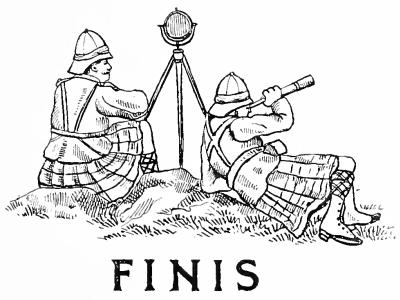
Davidson, J. L., Lieutenant-Colonel (provisional), 20th November, 1891. Confirmed, 25th March, 1892. Honorary Lieutenant-Colonel, 14th April, 1898.
Cosby, A. M., Major (provisional), 24th December, 1891. Confirmed, 18th June, 1894. Lieutenant-Colonel, 16th March, 1898. Died May 12, 1900.
† Macdonald, W. C., Major, 19th February, 1892. Lieutenant-Colonel, June 7, 1900.
Robertson, D. M., Captain (provisional), 19th February, 1892. Confirmed, 29th February, 1892. Major, 31st March, 1898.
Magillivray, D., Captain (provisional), 19th February, 1892. Confirmed, 29th February, 1892. Appointed Adjutant, 13th October, 1893. Appointed Paymaster, 24th August, 1896. Retired to Reserve of Officers as Captain, 6th July, 1900.
Hendrie, W., Jr., Captain (provisional), 19th February, 1892. Confirmed, 31st March, 1892.
Currie, J. A., Captain (provisional), 19th February, 1892. Confirmed, 13th August, 1892.
Gray, J. W., Captain (provisional), 19th February, 1892. Retired, 13th May, 1892.
Hunter, C. A., Lieutenant (provisional), 19th February, 1892. Confirmed, 29th February, 1892. Captain, 13th May, 1892. Retired, 29th October, 1894.
Michie, J. F., Lieutenant (provisional), 19th February, 1892. Confirmed, 29th February, 1892. Captain, 19th August, 1892.
Rose, G. M., Lieutenant (provisional), 19th February, 1892. Retired, 23rd June, 1894.
Donald, Duncan, Lieutenant (provisional), 19th February, 1892. Confirmed, 31st March, 1892. Captain, 13th October, 1893. Adjutant, 24th August, 1896.
McLean, D. H., Lieutenant (provisional), 19th February, 1892. Confirmed, 29th February, 1892. Retired, 20th April, 1894.
Adams, J., Honorary Captain and Quartermaster, 19th February, 1892. Retired, 19th August, 1897.
Stuart, W. T., Surgeon Major, 19th February, 1892.
Henderson, W., Captain, 24th March, 1892. Brevet-Major, 3rd March, 1892.
Macdonald, Walter, Captain, 24th March, 1892. Adjutant, 19th August, 1892. Retired with rank of Captain, 13th October, 1893.
Cassels, R. S., Captain, 22nd April, 1892. Retired, 21st April, 1894.
Orchard, W. H., Lieutenant, 13th May, 1892. Captain, 20th April, 1894. Honorary Major and Quartermaster, 18th March, 1898.
Ramsay, J. F., Lieutenant (provisional), 13th May, Confirmed, 30th September, 1892. Captain, 20th September, 1894. Retired, 20th March, 1897.
Campbell, C. A., Second Lieutenant (provisional), 13th May, 1892. Confirmed, 11th August, 1894. Lieutenant, 10th November, 1894. Captain, 27th November, 1899.
Thompson, J. A., Second Lieutenant, 13th May, 1892. Confirmed, 30th June, 1894. Lieutenant, 29th September, 1894. Retired, 4th June, 1897.
MacLean, H. C., Lieutenant (provisional), 24th May, 1892. Confirmed, 29th November, 1892. Captain, 24th August, 1896.
Dame, A. A., Assistant Surgeon, 19th August, 1892. Retired, 19th August, 1897.
† Mitchell, J. H., Second Lieutenant (provisional), 5th May, 1893. Confirmed, 20th February, 1894. Lieutenant, 20th April, 1894. Captain, 27th February, 1897.
Perry, F. M., Second Lieutenant (provisional), 26th August, 1893. Confirmed, 20th June, 1894. Lieutenant, 29th September, 1894. Captain, 13th May, 1898.
McLean, C. A. H., Second Lieutenant (provisional), 3rd November, 1893. Confirmed, 20th February, 1894. Lieutenant, 18th May, 1894. Retired on appointment to Second Battalion Argyle and Sutherland Highlanders, 21st March, 1896.
Cosby, F. L., Second Lieutenant (provisional), 7th April, 1893. Confirmed, 25th September, 1893. Lieutenant, 20th April, 1894. Captain, 13th May, 1898. Retired on appointment to North-West Mounted Police as Inspector, 23rd October, 1899.
Scott, C. D., Second Lieutenant (provisional), 20th April, 1894. Retired, 28th September, 1896.
Hamilton, H. V., Second Lieutenant (provisional), 18th May, 1894. Confirmed, 13th May, 1895. Lieutenant, 9th November, 1895.
Catto, C. J., Second Lieutenant (provisional), 18th May, 1894. Confirmed, 30th September, 1895. Lieutenant, 21st March, 1896.
Rainsbath, J. V., Second Lieutenant (provisional), 3rd August, 1894. Retired, 12th October, 1895.
Gibson, R. L., Second Lieutenant (provisional), 18th May, 1894. Retired, 29th September, 1894.
Cosby, N. L., Second Lieutenant (provisional), 21st September, 1895. Confirmed, 22nd May, 1896. Lieutenant, 4th June, 1897. Retired to enlist in R.C.A. for South Africa, 2nd January, 1900.
Brooke, H. J., Second Lieutenant (provisional), 12th October, 1895. Confirmed, 31st March, 1896. Lieutenant, 24th August, 1896.
Burnside, J. T. M., Second Lieutenant (provisional), 9th November, 1895. Confirmed, 31st March, 1896. Lieutenant, 6th March, 1897.
McDougall, D. H., Second Lieutenant (provisional), 4th May, 1896. Confirmed, 31st October, 1896. Lieutenant, 13th May, 1898. Retired, 9th January, 1900.
Hall, A., Second Lieutenant (provisional), 24th August, 1896. Confirmed, 2nd August, 1897. Retired, 11th January, 1898.
Taylor, A. P., Second Lieutenant (provisional), 12th December, 1896. Confirmed, 30th June, 1897. Lieutenant, 13th February, 1900.
Harbottle, C. C., Second Lieutenant (provisional), 30th December, 1896. Confirmed, 31st March, 1897. Lieutenant, 13th May, 1898.
Macdonald, C., Second Lieutenant (provisional), 10th May, 1897. Retired, 26th December, 1898.
Bickford, O. L., Second Lieutenant (provisional), 15th October, 1897. Confirmed, 31st March, 1898.
† Temple, R. G. H., Second Lieutenant (provisional), 12th March, 1898. Confirmed, 13th August, 1898. Lieutenant Special Service Battalion, R.C.R.I., October, 1899.
Smith, D. K., Surgeon-Lieutenant, 2nd February, 1898.
Mackenzie, A. W., Second Lieutenant (provisional), 18th October, 1898.
Darling, C. W., Second Lieutenant (provisional), 18th October, 1898. Confirmed, 23rd May, 1899.
Woodbridge, M. J., Second Lieutenant (provisional), 25th October, 1898. Confirmed, 31st March, 1899.
Isbister, A. J., Second Lieutenant (provisional), 2nd November, 1898.
McGaw, O. E., Second Lieutenant (provisional), 26th December, 1898. Confirmed, 23rd May, 1899.
Black, Rev. Armstrong, Honorary Chaplain, 29th September, 1899.
Somerville, L. McR., Second Lieutenant (provisional), 15th February, 1900.
Macdonell, Rev. D. J., appointed Chaplain by Regimental order before Honorary Chaplains allowed.
The Canadian Bank of Commerce
Canada Life Assurance Co.
William MacKenzie
D. R. Wilkie
Sir David L. McPherson
Caledonian Society
Wm. Christie
Bank of Toronto
John Kay & Son Co.
Frederick Wyld
Canada Sugar Ref. Co.
Hon. George A. Cox
Hiram Walker & Sons, Ltd.
Kemp Mfg. Co.
Northrop & Lyman Co., Ltd.
Robertson Bros.
Oak Hall.
Western Assurance Co.
Gutta Percha and Rubber Mfg. Co.
E. Boisseau & Co.
The Gurney Foundry Co., Ltd.
Toronto Type Foundry Co., Ltd.
The Barber & Ellis Co.
Imperial Life Assurance Co.
Blue Ribbon Tea Co.
Lumsden Bros.
Corticelli Silk Co.
J. F. Brown Co., Ltd.
Adams Furniture Co.
P. W. Ellis Co.
Pugsley, Dingman & Co.
W. McIntosh
A. A. Barthelmes & Co.
Swan Bros.
The Wm. B. Hamilton Shoe Co.
The J. D. King Co., Ltd.
Chas. Cockshutt & Co.
John H. Dunlop
T. G. Brough
E. W. Gillett
The Cowan Co., Ltd.
H. S. Howland
Pure Gold Mfg. Co.
J. & J. Taylor
J. Algernon Temple, M.D.
Jas. W. Ross, M.D.
John Leckie
J. E. Ellis
John Dick
Thos. Dunnet
Nerlich & Co.
J. Firstbrook
Harry Webb Co.
Crompton Corset Co.
H. W. Petrie
Boeckh Bros. & Co.
Toronto Lithographing Co.
Ireland National Food Co.
S. Trees
W. G. Harris
Rolph, Smith & Co.
P. Jacobi
Donald Mackay
Ashdown’s Music Store
John Abell Eng. & Mach. Works
Jas. P. Murray
Aikenhead Hardware Co.
John Hillock & Co.
John Holderness
Alfred Robinson
Ontario Lead and Wire Co.
T. A. Lytle
John Burns & Son
John Smith
Todhunter, Mitchell & Co.
T. Milburn & Co.
The Wilkinson Plough Co.
The Brown Bros., Ltd.
Toronto Can Co.
Samuel May
Ontario Wind Engine & Pump Co.
R. S. Williams
Warwick Bros. & Rutter
Menzie, Turner & Co.
Osler & Hammond
G. P. Magann
Chas. S. Blackwell
Northey Mfg. Co.
Noah L. Piper & Son
The Jas. Robertson Co.
John Macdonald & Co.
Octavius Newcombe & Co.
Parisian Steam Laundry Co.
Nisbet & Auld
John D. Ivey Co.
Conger Coal Co.
The Central Canada Loan & Savings Co.
Provincial Building & Loan Assn.
W. & J. G. Greey
The Dodds Medicine Co.
E. Saunders
Adams Bros.
John B. Smith & Sons
Frankel Bros.
Archibald Campbell
Gillespie, Ansley & Co.
Geo. B. Meadows Co.
McAlpin Tobacco Co.
Rankin & Co.
Spilling Bros.
Smith Bros.
Niagara Navigation Co.
D. W. Alexander
McIntosh Granite & Marble Co.
J. J. McLaughlin
Taylor Bros.
George Milligan
D. McCall
H. Horsman
Geo. Weston
H. P. Dwight
Nordheimer Music & Piano Co.
Arthur J. Frost
M. & L. Samuel, Benjamin & Co.
Jas. Robertson
Chas. Peters
Blake, Lash & Cassells
Robert Simpson
Alex. Gibb
Jno. Blackwell
Geo. Ratcliffe
T. McFarlane
J. Little
Wm. Stark
Edison Electric Co.
W. R. Spencer
A. H. Campbell
A. W. Grassett
Wm. Bryce
Dr. Clark
Dalton Bros.
J. D. Nasmith
T. D. Miller
J. F. Smith, Q.C.
T. R. Warwick
Warwick & Co.
W. H. Beatty
Gaelic Society
Shedden & Co.
W. M. Clark
Jno. Bailie
A. B. McColl
Kilgour Bros.
J. B McColl
Robert Swan
John Hallam
John Henderson
J. H. Ewart
R. Green
Hon. Edward Blake
Mrs. C. Macdonald
J. McMillan
Chas. Walker
Hugh Miller
Dr. James Thorburn
George Gooderham
Wm. Adamson
W. Kinghorn
John Flett
Hugh Ryan
D. W. Alexander
Mrs. Johnston
S. F. McKinnon
J. L. Morrison
F. W. Holgate
A. McArthur
Jas. Cooper
R. J. Havenden
Wm. Armstrong
J. Scholes
J. Elliott
T. Pells
Wm. Milligan
John Harp (Amoy, China)
W. Simpson
F. W. Lockwood
John Lander
T. Giles
R. Fleming
R. W. Spence
McMasher & Co.
W. D. Matthews
Paul Campbell
R. H. Bethune
E. B. Osler, M.P.
J. K. Macdonald
St. Lawrence Sugar Ref. Co.
Eddy Mnfg. Co.
J. Taylor
Badgerow & Dixon
D. B. Dick
Pearson Bros.
J. Harvie
D. Turner
“Glendale” (Montreal)
Thos. Robertson
Mrs. Cameron
Dr. Andrew Smith
Harry Piper
D. Walker
C. Rogers & Sons Co.
A. Jardner & Co.
R. Jaffray
Mrs. R. Carroll
Hutchison, Shurley & Derrett
S. Tidy & Son
P. A. Macdonald
W. J. Gage & Co., Ltd.
J. McCausland
The Mason & Risch Piano Co.
M. Staunton & Co.
Stone & Wellington
Pelham Nursery Co.
Rogers & Co.
Hutchinson & Son
Westman & Baker
The British-American Business College Co.
Dominion Paper Box Co.
Fensom Elevator Co.
Kinnear & Co.
E. R. C. Clarkson
Dominion Radiator Co.
James Park
Irving Umbrella Co.
F. W. Humphrey
W. J. McGuire
G. Goulding & Sons
John Dixon
The Tait-Bredin Co., Ltd.
George Coles
W. J. McMurty
The Bennett & Wright Co., Ltd.
G. O. Roche
Belle Ewart Ice Co.
Alex. Millard
Gourlay, Winter & Leeming
A. S. Boone
Toronto Foundry Co.
The National Cycle & Auto. Co., Ltd.
The Copeland-Chatterson Co., Ltd.
Joan Bishop
St. Margaret’s College
Jas. Poffley
Canada Cycle & Motor Co.
Wreyford & Co.
K. Ishikawa & Co.
J. J. Foy
John Northway
Rev. Arthur H. Baldwin
Rev. Armstrong Black
R. T. Coady
G. F. Marter
C. H. Rust
Fred Mowat
Charles Sheard, M.D.
Noel Marshall
R. A. Pyne
J. O. Langmuir
John Jones
Geo H. Hees, Son & Co.
Roden Bros.
R. Laidlaw Lumber Co.
George Rathbone
J. H. G. Hagarty
Robert Beatty & Co.
Commissioner of Crown Lands
Geo. A. Kingston
J. F. Junkin
Hon. G. W. Ross
Avern Pardoe
R. Harcourt
F. R. Latchford
J. R. Stratton
John Ritchie Plumbing & Heating Co., Ltd.
The Canada Permanent and Western Canada Mortgage Co.
James Maclennan
F. Osler
Chas. Moss
W. P. R. Street
N. Clarke Wallace
John Small
N. R. Frankland
Walter Harland Smith
York County Loan & Savings Co.
C. C. Stratton
Roderick J. Parke
Ryrie Bros.
Lt.-Col. H. J. Grasett
Eastmuir & Lightbourne
J. Hardy
Hugh MacMahon
J. A. Boyd
W. R. Meredith
E. Coatsworth
S. W. McMichael
A. E. Ames & Co.
Standard Bank of Canada
The Traders Bank of Canada
The Ontario Bank
E. Veals
T. Eaton
Larrat W. Smith
Toronto Mortgage Co.
J. F. Lester
Thomas Ferguson
Wm. Stitt & Co.
O’Keefe Brewery Co.
S. W. Black
Imperial Trust Co.
John Catto & Son
C. C. James
Hon. J. M. Gibson
H. H. Langton
The National Life Ass. Co. of Can.
Edmund Scheuer
A. J. Russel-Snow
Alex. Lochore
Jas. Pears
J. L. Campbell
R. Bond
The Canadian Birkbeck Investment & Savings Co.
R. Parker & Co.
Canada Printing Ink Co.
Ritchie & Ramsay
The Temperance & General Life Assurance Co.
Confederation Life Association
W. A. Murray & Co., Ltd.
Joseph Seagram
C. Robinson
W. E. Chalecraft & Co.
A. Bollard
Bristol & Cawthra
The Marlatt & Armstrong Co., Ltd.
Angus Kirkland
Sylvester Bros.
Hugh C. Salmon
R. G. Dun & Co.
The W. R. Brock Co., Ltd.

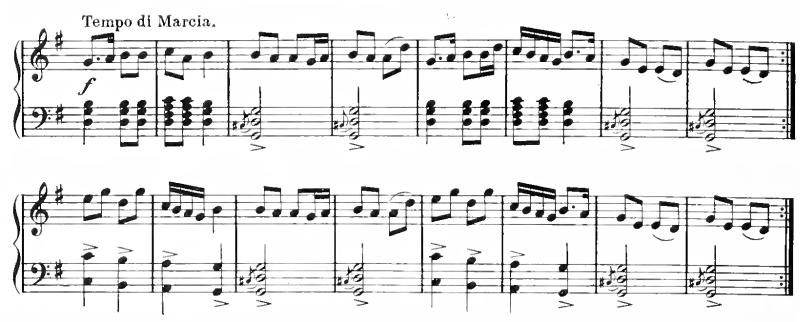
Where ha’e ye been a’ the day,
Bonnie laddie, Highland laddie?
Saw ye him that’s far away,
Bonnie laddie, Highland laddie?
On his head a bonnet blue,
Bonnie laddie, Highland laddie;
Tartan plaid and Highland trew
Bonnie laddie, Highland laddie?
When he drew his gude braid sword,
Bonnie laddie, Highland laddie,
Then he gave his royal word,
Bonnie laddie, Highland laddie,
That frae the field he ne’er wad flee,
Bonnie laddie, Highland laddie;
But wi’ his friends wad live or dee,
Bonnie laddie, Highland laddie.
Weary fa’ the lawland loon,
Bonnie laddie, Highland laddie,
Wha took frae him the British croon,
Bonnie laddie, Highland laddie;
But blessings on the kilted clans,
Bonnie laddie, Highland laddie;
That fought for him at Prestonpans,
Bonnie laddie, Highland laddie.

Transcriber’s Note:
Pages 97 through 128 of this book are advertisements by the companies mentioned in the Roll of Honour starting on page 94. In a textual format, these advertisements will not reproduce well, and have been omitted. The original scans of these pages may be found at https://archive.org/details/48thhighlanderso00fras_0.
Mis-spelled words and printer errors have been fixed.
Inconsistency in hyphenation has been retained.
Illustrations have been relocated due to using a non-page layout.
Some photographs have been enhanced to be more legible.
[The end of The 48th Highlanders of Toronto by Alexander Fraser]